Neither Kay or I realized when we got to Puno that its elevation would affect us with altitude sickness already. We both had headaches, a bit of nausea, a general sense of feeling unwell, and were really winded walking around. My headache felt like a vague hangover with stuffed up ears, but soon I realized that my stomach was upset probably due to the altitude and not food we had eaten.
For our first dinner, we went to Mojsa Restaurant in the main square and ordered some coca tea to help our headaches.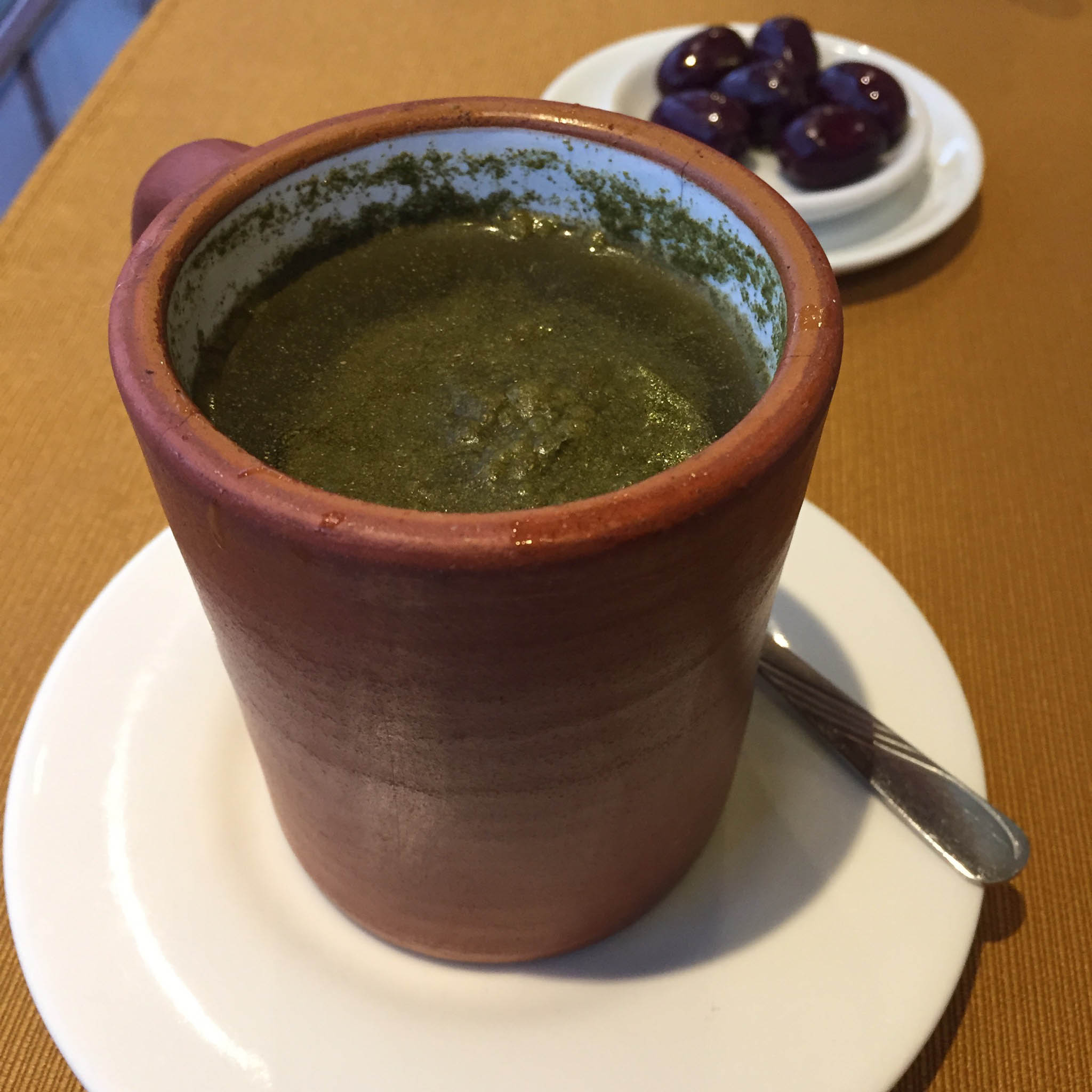 Our waitress was American and I was really happy to know that she knew what gluten was and could recommend several things to me.
Our waitress was American and I was really happy to know that she knew what gluten was and could recommend several things to me.
I ordered the Sirloin steak with Andean chimichurri, golden huayro and sweet potatoes, and parsley alioli sauce before getting pretty sick and running to the bathroom several times. When I came back, I’d lost my appetite completely (another symptom of altitude sickness) and it was a shame because my food looked really yummy. As I mentioned in our homestay post, we spent the next day in the care of locals who cooked mainly corn and potatoes, all gluten free. The soup below was absolutely delicious and vegetarian, with fresh muña tea herbs for our tea.
As I mentioned in our homestay post, we spent the next day in the care of locals who cooked mainly corn and potatoes, all gluten free. The soup below was absolutely delicious and vegetarian, with fresh muña tea herbs for our tea.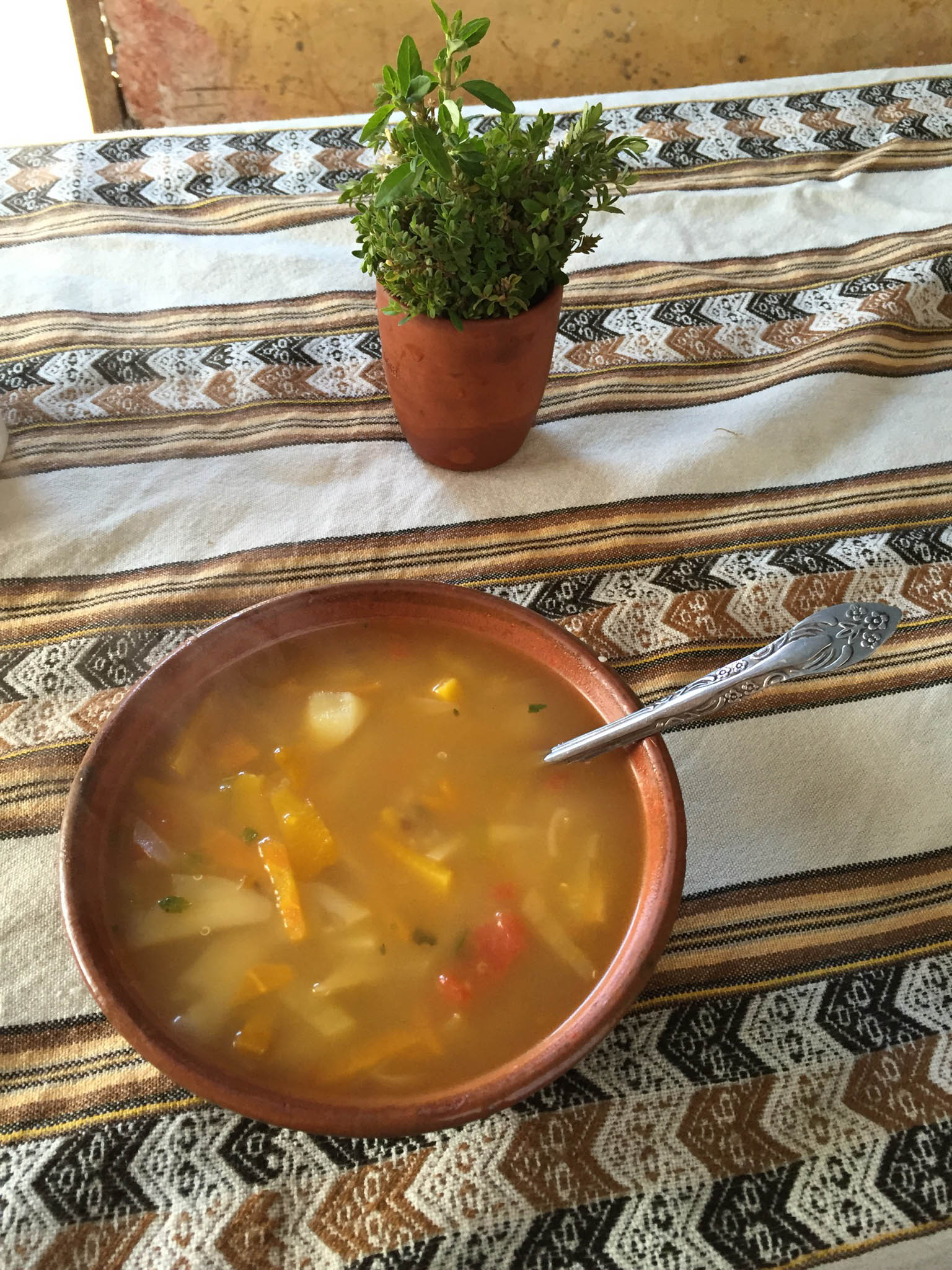 Also at lunch after the soup, we got a big bowl of various potatoes, some carrots I think, as well as a big piece of salty goat cheese.
Also at lunch after the soup, we got a big bowl of various potatoes, some carrots I think, as well as a big piece of salty goat cheese.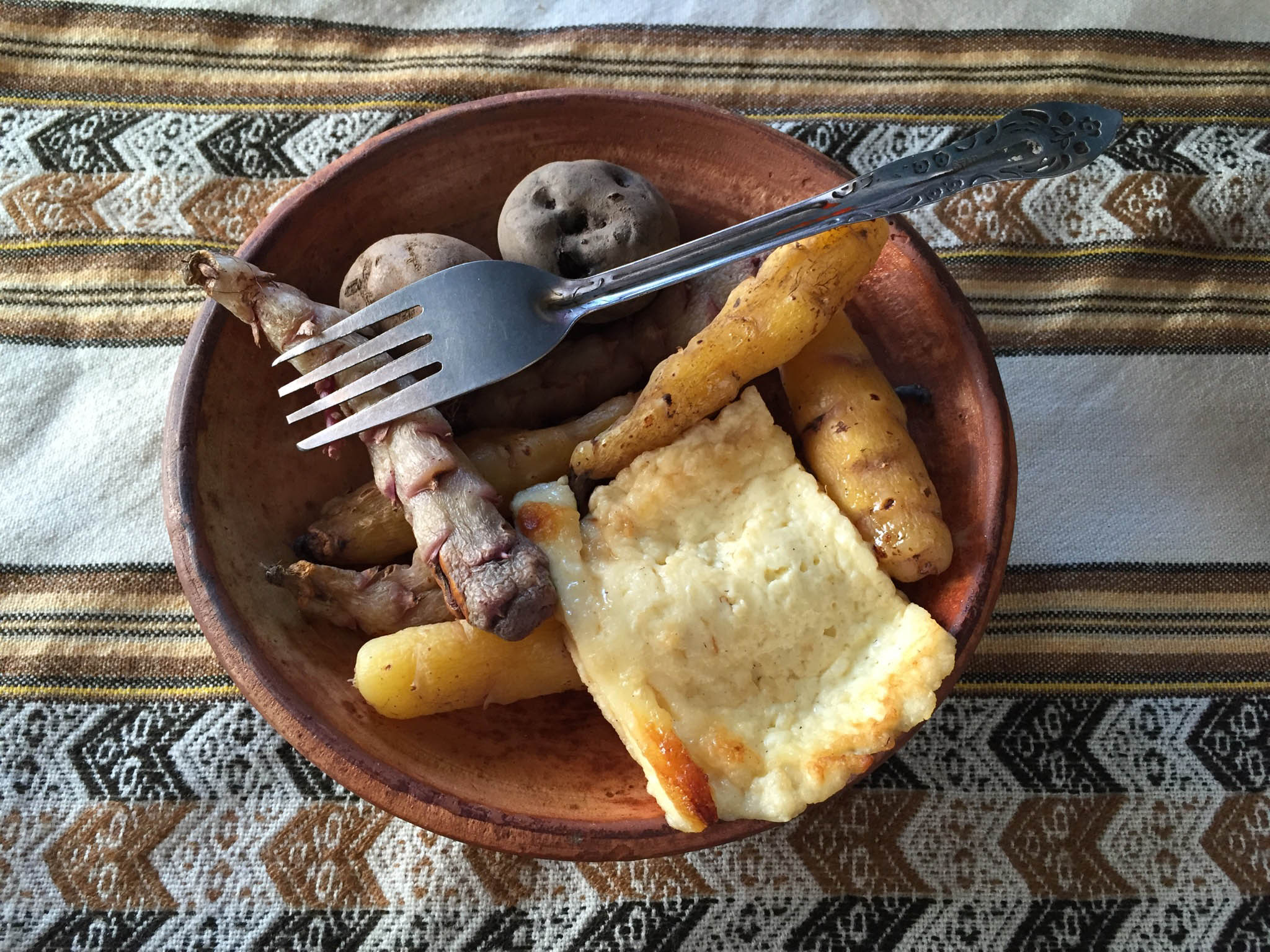 I was really impressed with the cooking the entire homestay because the kitchen was basically a small hovel off the eating area. It looked more like a barn or trash room because the family always swept everything from the eating area into the small kitchen space so that they could pick things up to burn later on. I was SO curious to see how they really cooked in a space like that. It was very small and cramped, with no vents for the smoke.
I was really impressed with the cooking the entire homestay because the kitchen was basically a small hovel off the eating area. It looked more like a barn or trash room because the family always swept everything from the eating area into the small kitchen space so that they could pick things up to burn later on. I was SO curious to see how they really cooked in a space like that. It was very small and cramped, with no vents for the smoke.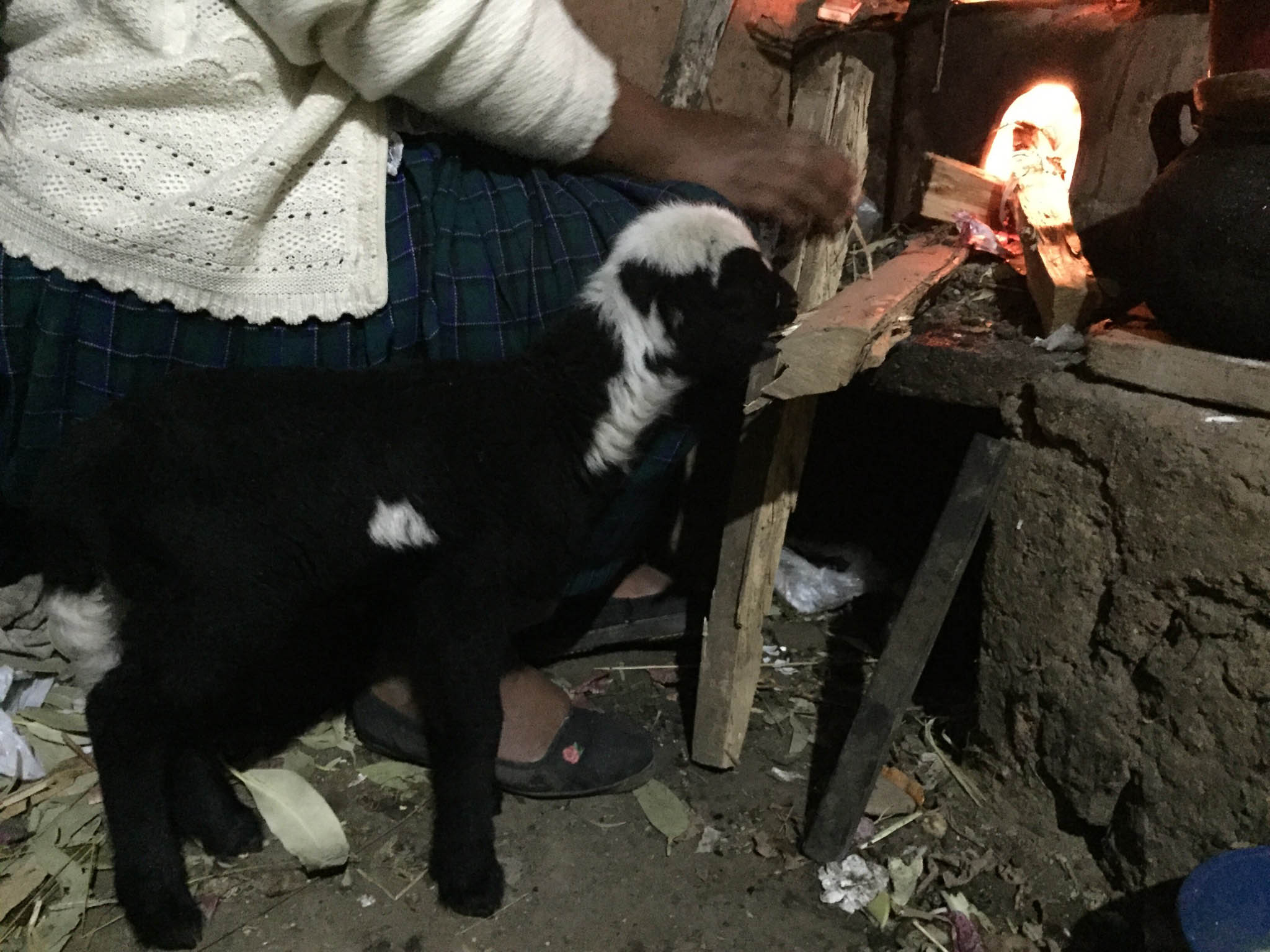 For dinner we had a kind of carrot and potato mix with rice.
For dinner we had a kind of carrot and potato mix with rice. The next morning I was concerned when our mama served us what looked like pancakes. Communicating with Kay’s Portuñol to their dialect of Quechua was a little tricky, but we verified that there was no “Harina de Trigo” and that it should just be made out of corn, so I ate my pancakes with coca tea and they were delicious.
The next morning I was concerned when our mama served us what looked like pancakes. Communicating with Kay’s Portuñol to their dialect of Quechua was a little tricky, but we verified that there was no “Harina de Trigo” and that it should just be made out of corn, so I ate my pancakes with coca tea and they were delicious.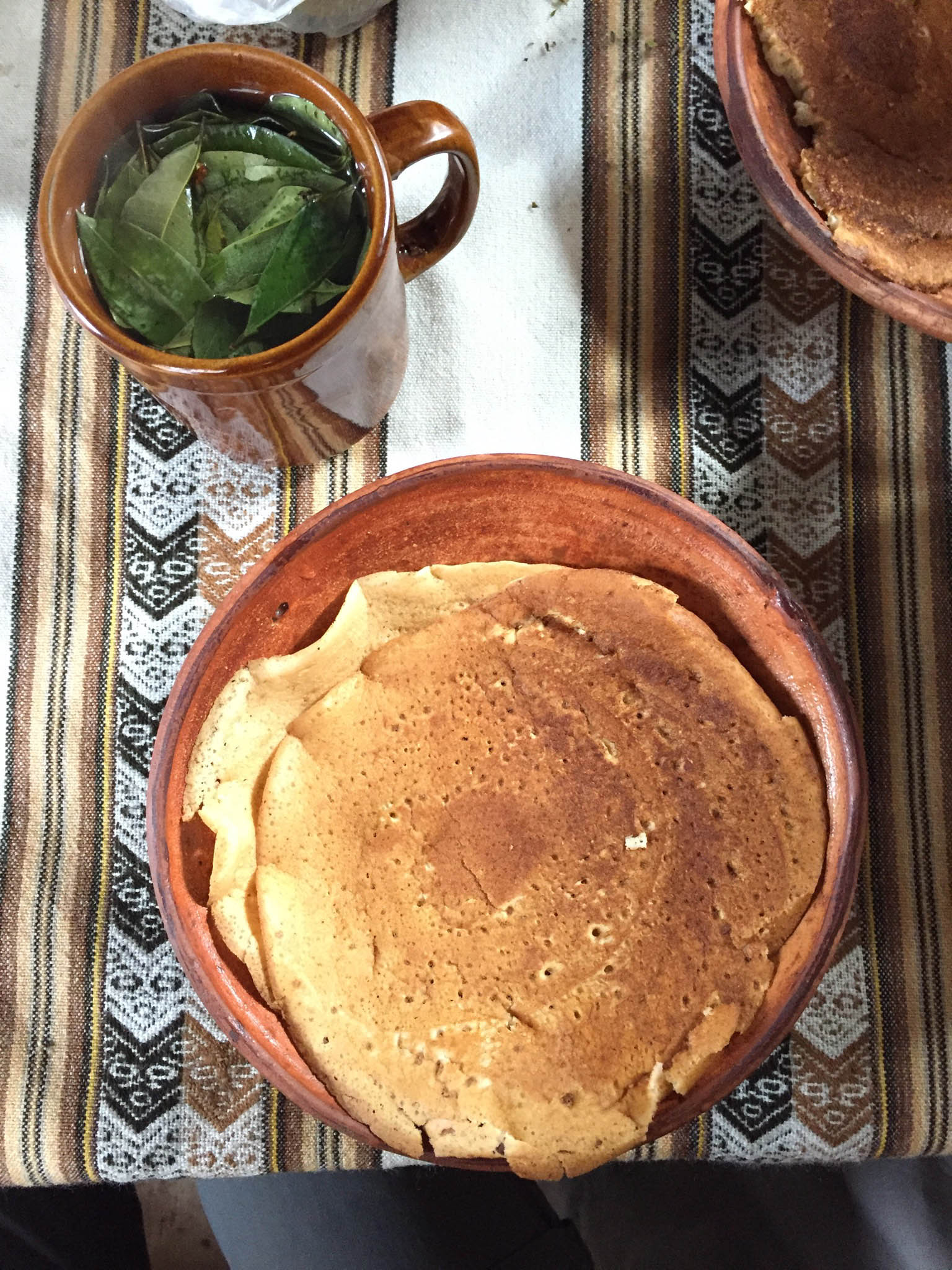 Next on our homestay tour, we had left Amantaní Island and headed to Taquile Island where we had a big goodbye lunch before heading back to Puno. Here I asked our guide to make sure the food was OK for me.
Next on our homestay tour, we had left Amantaní Island and headed to Taquile Island where we had a big goodbye lunch before heading back to Puno. Here I asked our guide to make sure the food was OK for me. 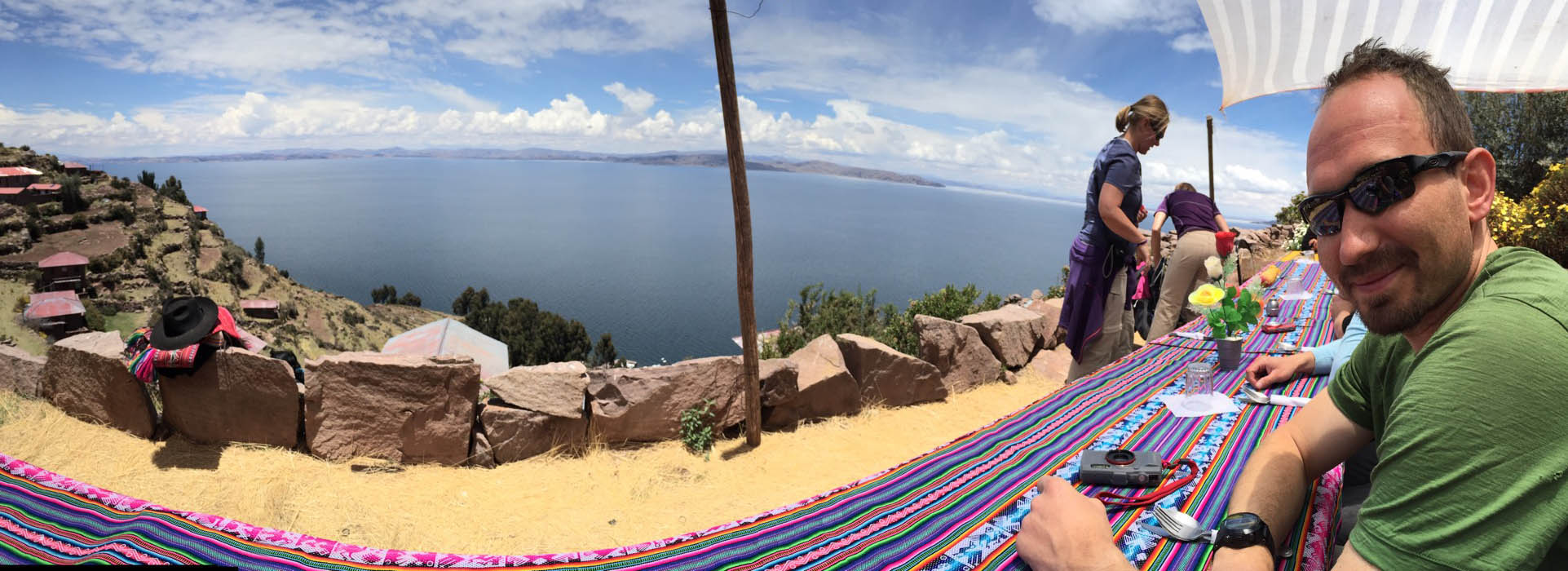 First up was some quinoa soup. We realized on the trip that quinoa, which we eat so often now with my celiac diet, often comes from Peru, and that the local diet uses it heavily, to my benefit.
First up was some quinoa soup. We realized on the trip that quinoa, which we eat so often now with my celiac diet, often comes from Peru, and that the local diet uses it heavily, to my benefit. For lunch we had a choice and I picked fresh fish with a side of rice, fries, and some veggies. I also purchases an additional Coke out of the homestay package because I felt icky and headachey and it took my headache right away. After that, I pretty much felt fine and headache-free from the altitude for the rest of the trip. Still extra winded though. 😉
For lunch we had a choice and I picked fresh fish with a side of rice, fries, and some veggies. I also purchases an additional Coke out of the homestay package because I felt icky and headachey and it took my headache right away. After that, I pretty much felt fine and headache-free from the altitude for the rest of the trip. Still extra winded though. 😉 Back in Puno, I wanted to go back to Mojsa Restaurant because I didn’t believe that the food had made me sick and I really wanted to try their gluten free brownie for dessert. It really had to be the altitude, which is quite a common reaction from travelers.
Back in Puno, I wanted to go back to Mojsa Restaurant because I didn’t believe that the food had made me sick and I really wanted to try their gluten free brownie for dessert. It really had to be the altitude, which is quite a common reaction from travelers.
Kay and I decided to split a ceviche as our appetizer because we hadn’t had it in Lima yet and it was delicious, it was trout ceviche with sweet potatoes and crunchy corn. If you are heading to Peru, make sure to try this signature Peruvian dish of fish cured in citrus.  For my main, I got the grilled trout fillet with a passion fruit and rocoto pepper sauce, served with sautéed vegetables. And a Pisco Sour, because we’d hiked a tough walk on Amantaní Island. 😉
For my main, I got the grilled trout fillet with a passion fruit and rocoto pepper sauce, served with sautéed vegetables. And a Pisco Sour, because we’d hiked a tough walk on Amantaní Island. 😉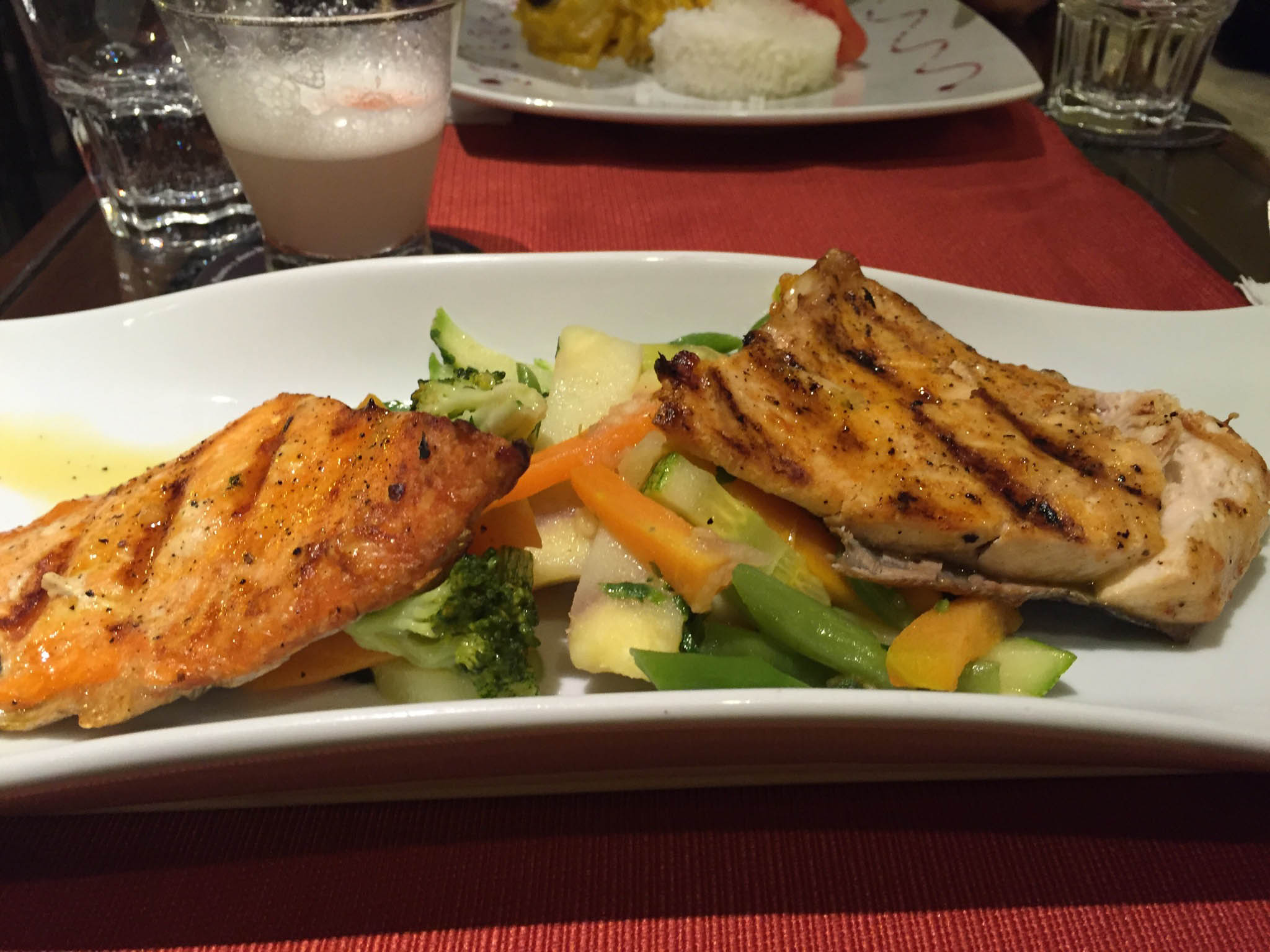 For dessert, I got my brownie and shared a tiny bit with Kay, who was quite stuffed himself.
For dessert, I got my brownie and shared a tiny bit with Kay, who was quite stuffed himself. On our fourth day in Puno, we thought we’d try something else out and we had the dreaded breakfast search, which is honestly still the worst part of traveling as a celiac. I’d eaten a snack bar or two before we found Cafe Bar de la Casa del Corregidor, which seemed like it was the cafe of a kind of hostel in the area.
On our fourth day in Puno, we thought we’d try something else out and we had the dreaded breakfast search, which is honestly still the worst part of traveling as a celiac. I’d eaten a snack bar or two before we found Cafe Bar de la Casa del Corregidor, which seemed like it was the cafe of a kind of hostel in the area.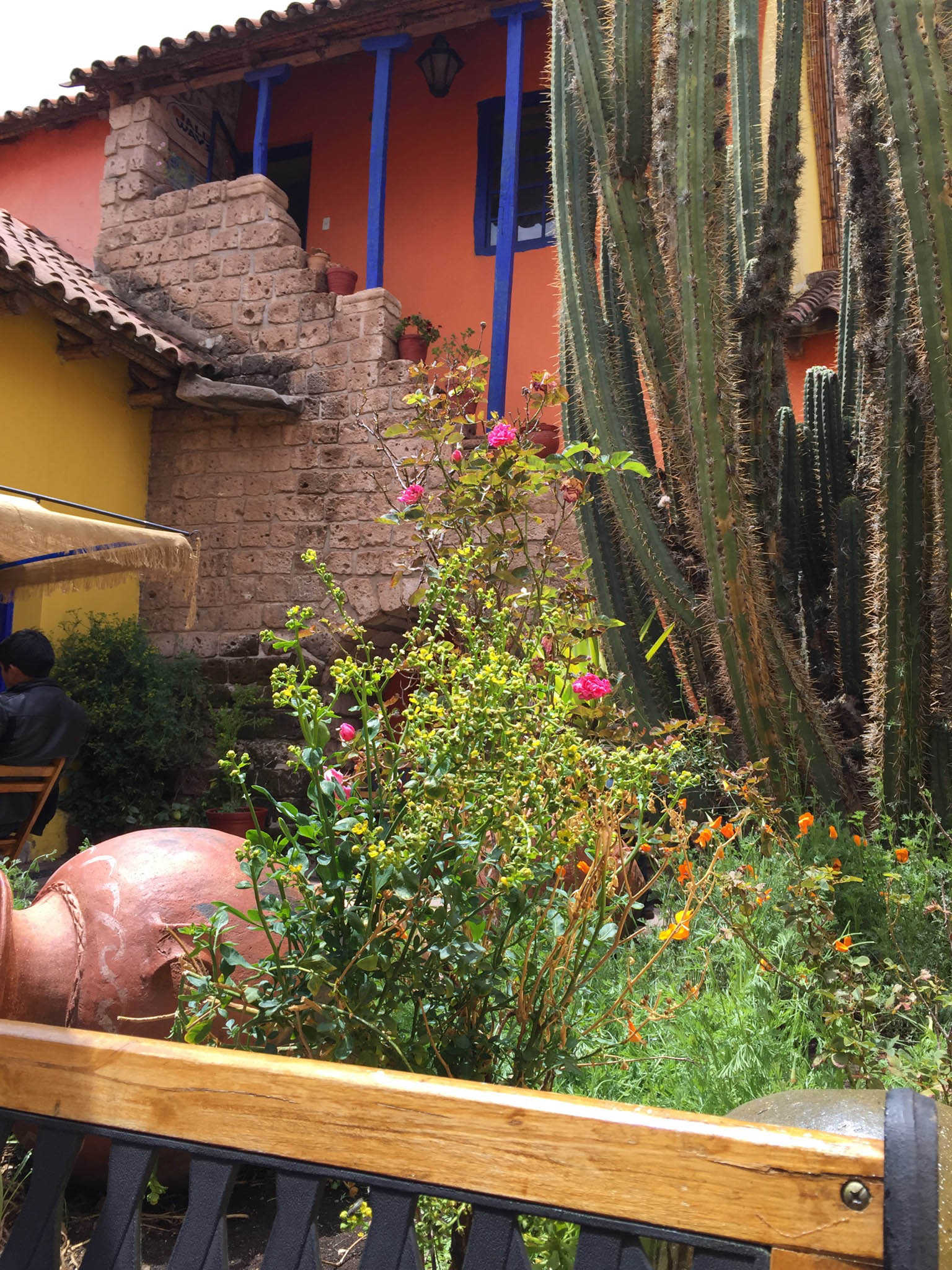
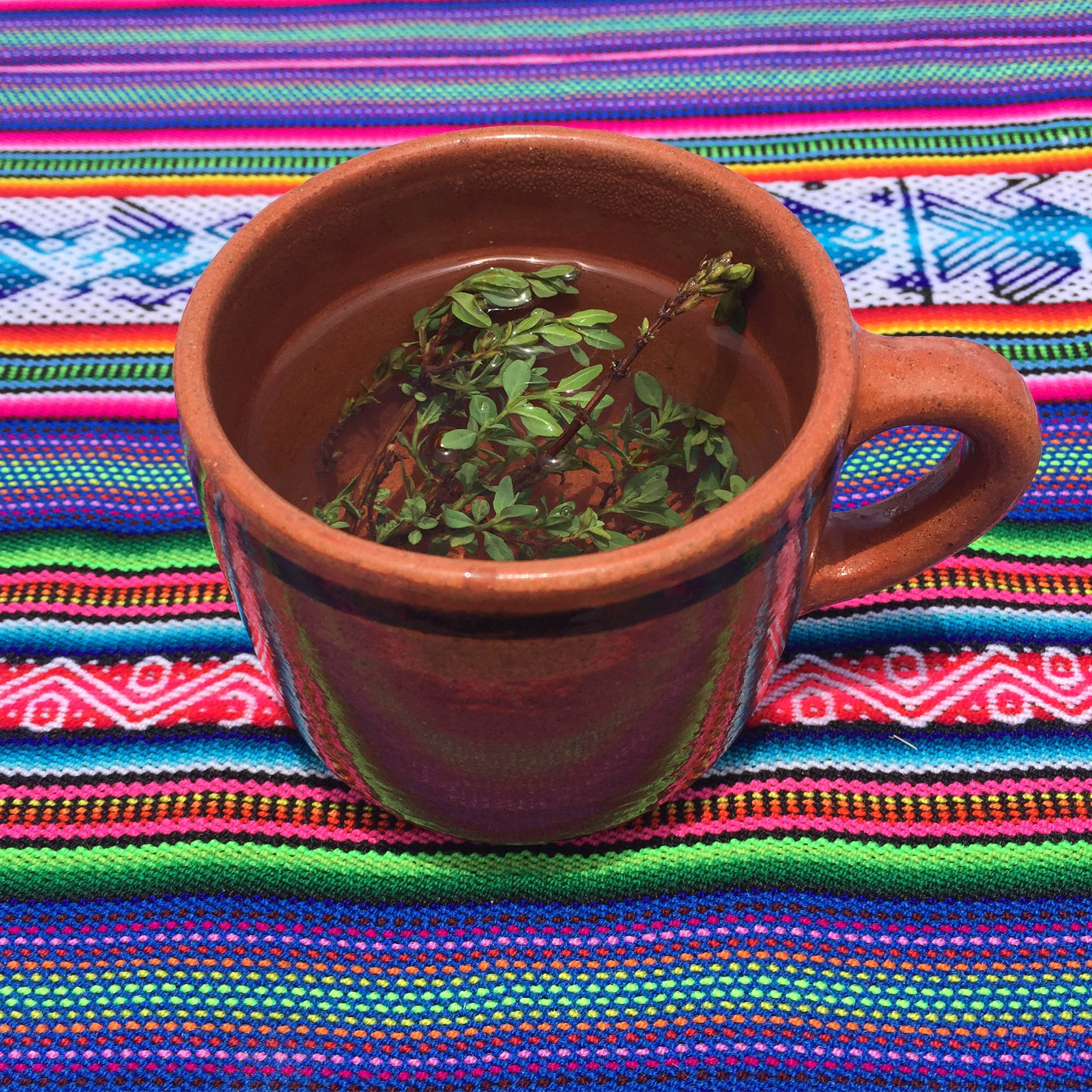 Muña tea and espresso were ordered, as well as juice because it was breakfast for us.
Muña tea and espresso were ordered, as well as juice because it was breakfast for us.
 The menu was not extremely gluten-free friendly, but I got some kind of frittata that met my needs.
The menu was not extremely gluten-free friendly, but I got some kind of frittata that met my needs.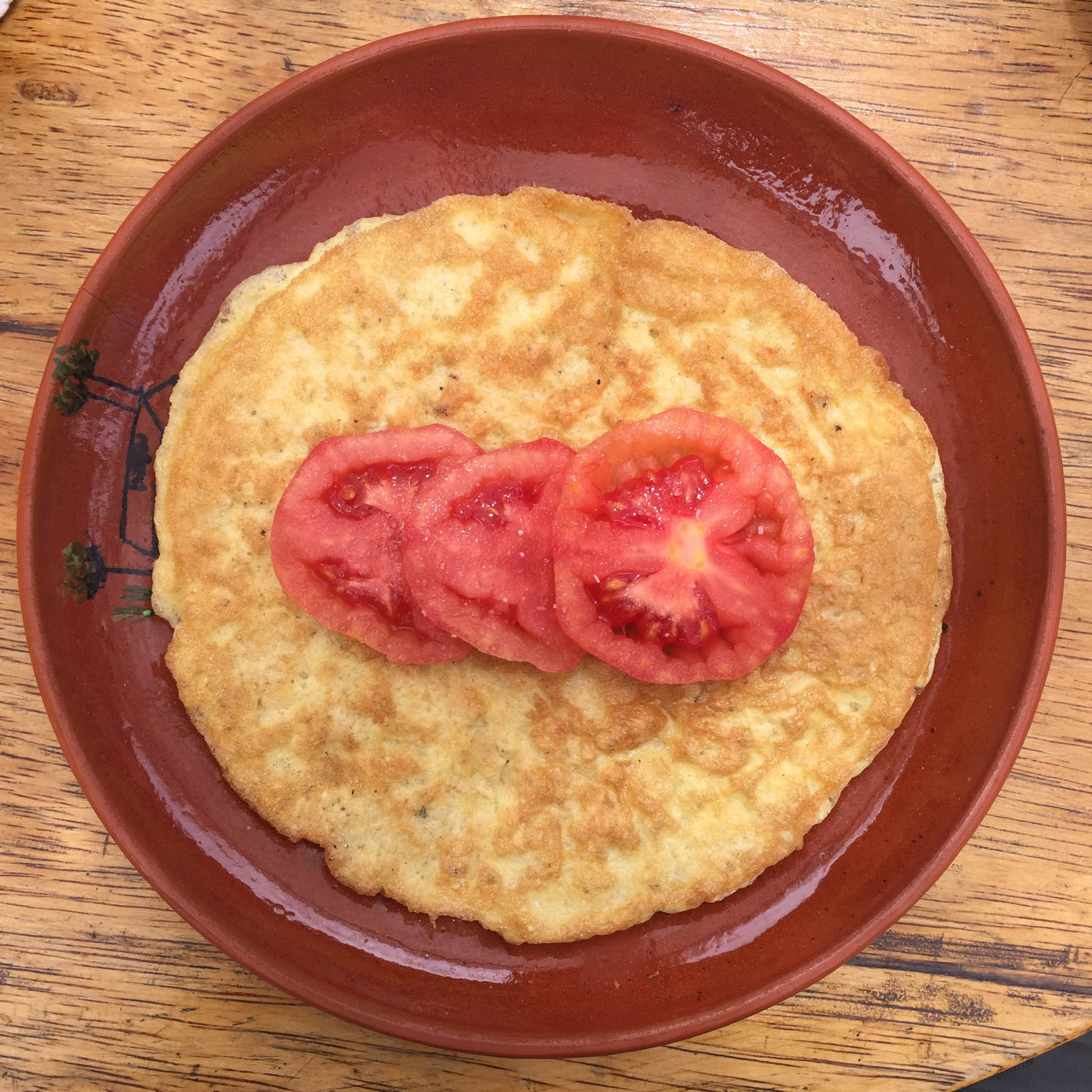 We also decided to split some chicken kebabs. Looking at them is making me hungry again.
We also decided to split some chicken kebabs. Looking at them is making me hungry again. After we walked up to the Condor in Puno, we stopped at the cafe again for some classic Inca Kola, which is like bubble gum flavored pop.
After we walked up to the Condor in Puno, we stopped at the cafe again for some classic Inca Kola, which is like bubble gum flavored pop.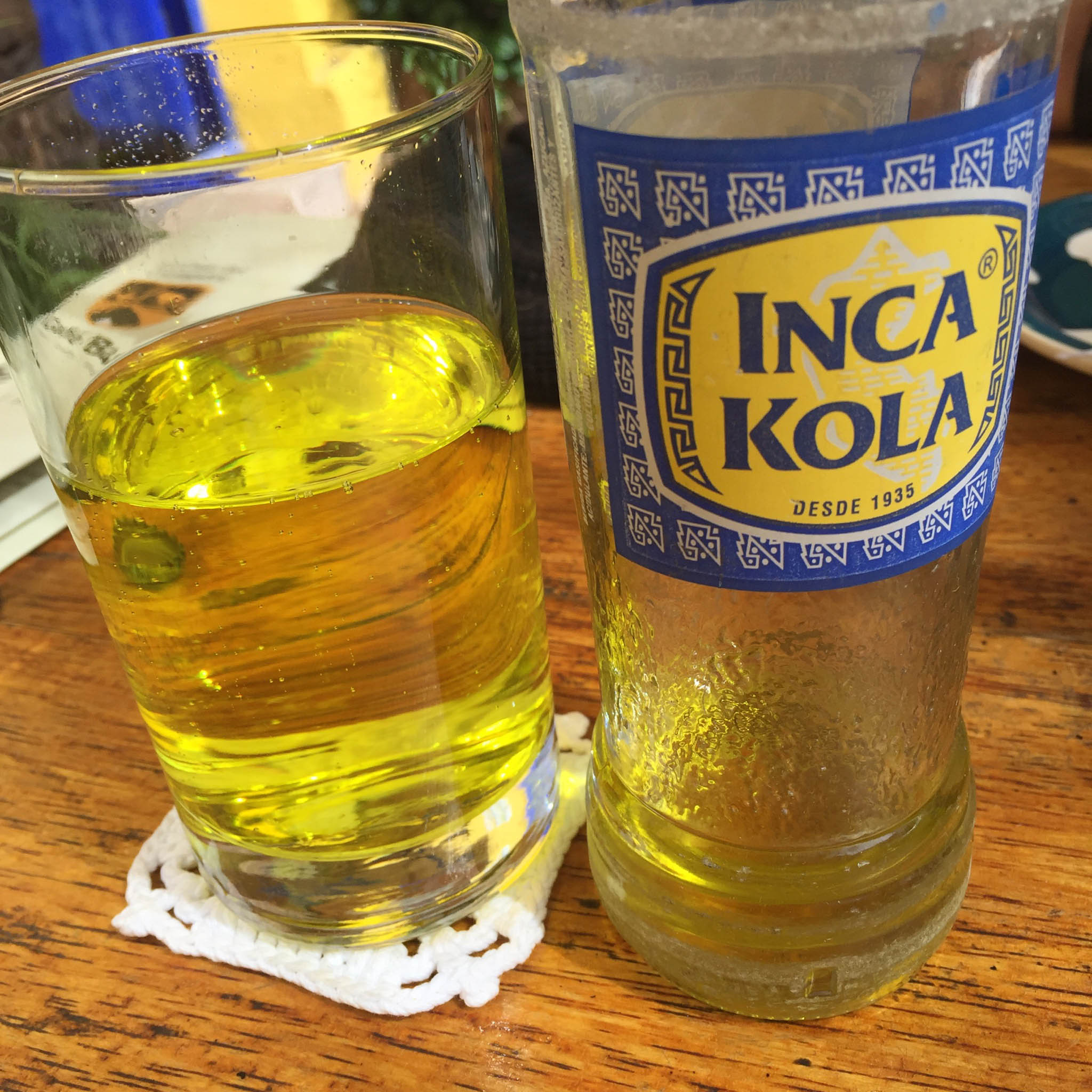 I also ordered a quinoa soup because breakfast didn’t fill me enough.
I also ordered a quinoa soup because breakfast didn’t fill me enough.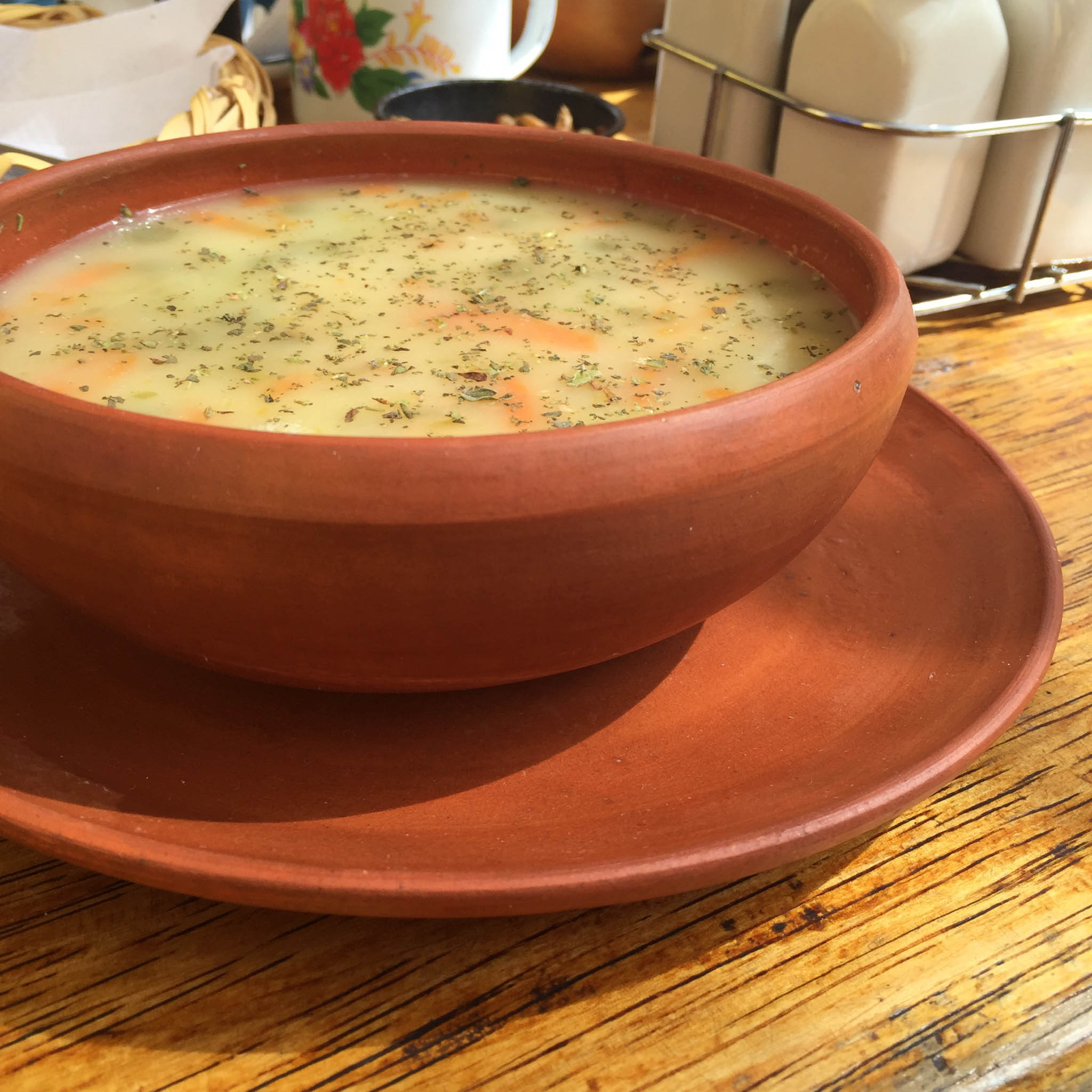 And they were so kind to give us more corn to munch on.
And they were so kind to give us more corn to munch on. For our last meal before our night bus to Cusco, we just went back to Mojsa Restaurant again. I’m still not one for repeats, but it makes life so much easier as a celiac when you know there is a safe restaurant with decent food. I’m making peace with the lack of spontaneity because I don’t have a choice in the matter. What makes life easy, makes life easy.
For our last meal before our night bus to Cusco, we just went back to Mojsa Restaurant again. I’m still not one for repeats, but it makes life so much easier as a celiac when you know there is a safe restaurant with decent food. I’m making peace with the lack of spontaneity because I don’t have a choice in the matter. What makes life easy, makes life easy.
Because it happened to be our 4th anniversary that night, I decided to go all out and try their kitschy oven baked guinea pig served with sweet potato puree, orange sauce and a small rocoto pepper and tomato salad. Yep, that is a guinea pig and this lady had no shame in eating it. It was GLUTEN FREE!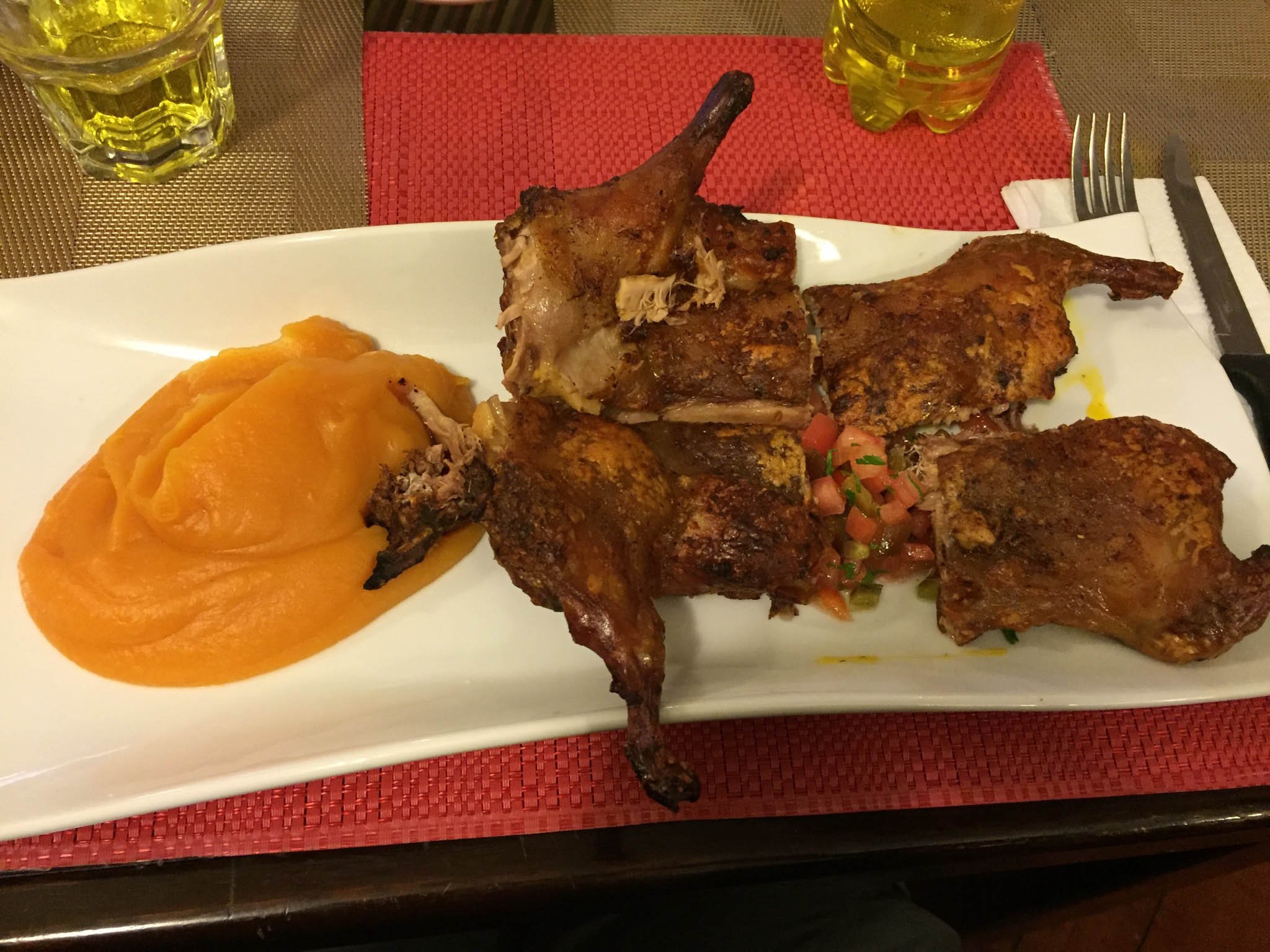 It tasted alright, maybe a bit more gamey than chicken or beef. It was a bit hard to get all the meat off the bone though and I ended up finishing it chicken-wings style.
It tasted alright, maybe a bit more gamey than chicken or beef. It was a bit hard to get all the meat off the bone though and I ended up finishing it chicken-wings style.
For dessert, we opted to split the second gluten free dessert, which was a kind of hot, sweet, quinoa porridge with raisins. It was very filling.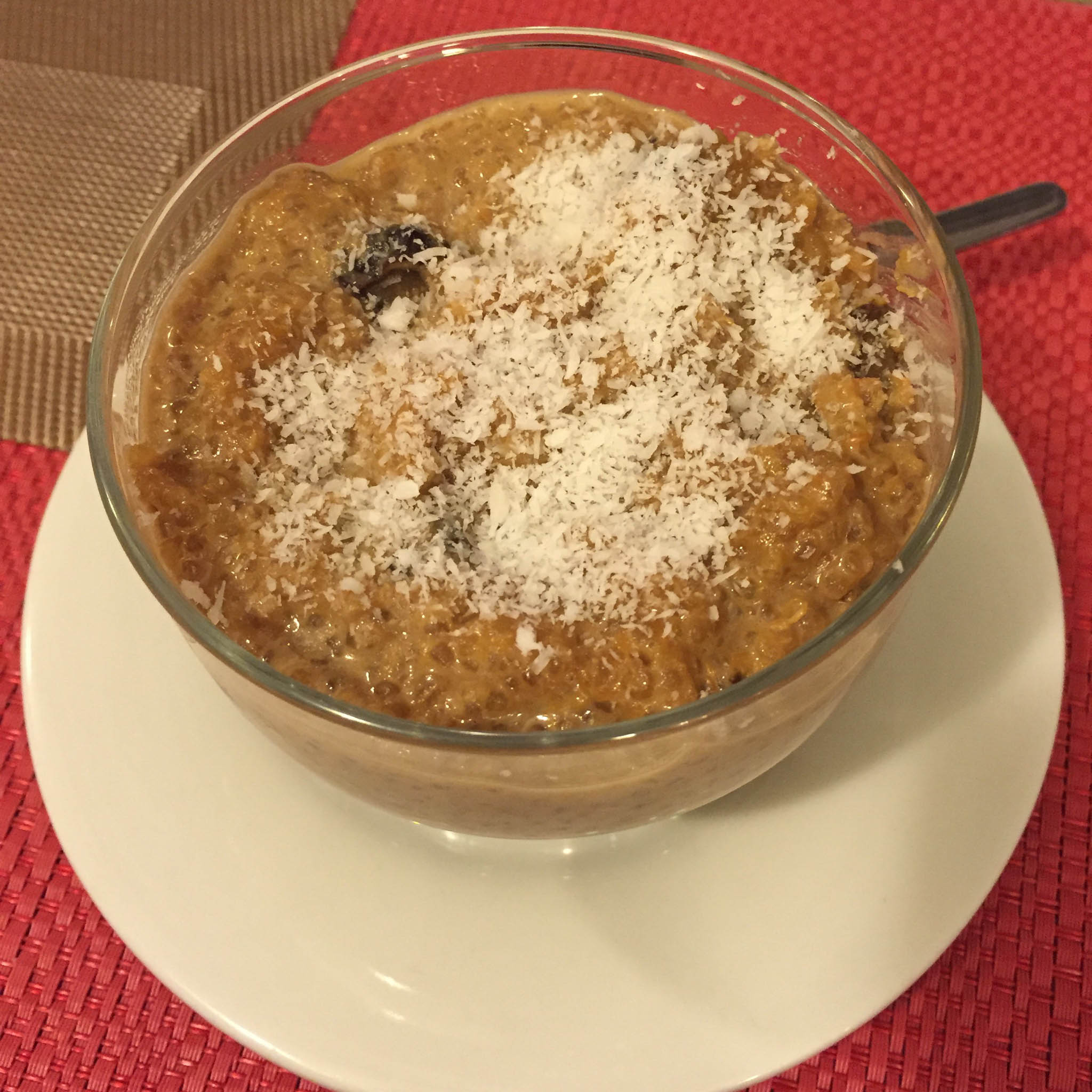 Up next, we arrive in Cusco the days we’d planned to acclimatize to the altitude we just encountered in Puno. Oops.
Up next, we arrive in Cusco the days we’d planned to acclimatize to the altitude we just encountered in Puno. Oops.
More from our trip to Peru:

 There is a special hat just for the leader of the community as well as hats for men and women to give a signal if they are single, dating, or married.
There is a special hat just for the leader of the community as well as hats for men and women to give a signal if they are single, dating, or married.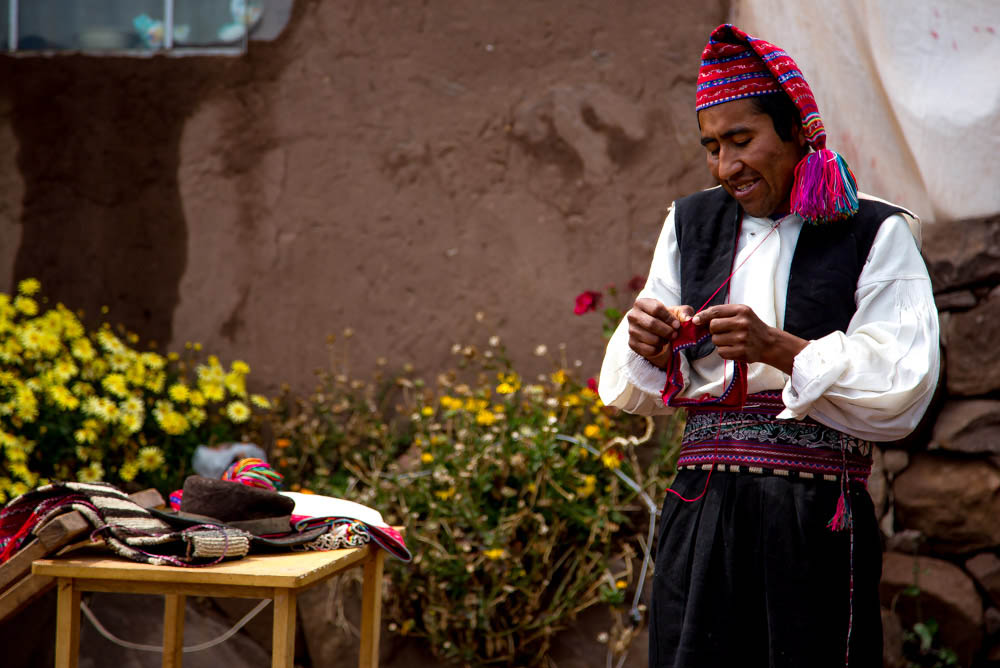 It was also interesting to learn that men, not just women, learn how to weave and knit. But some boys just want to quit school because they can make more money with needles faster than by studying, so it’s a problem for the community to deal with if they want to educate their youth.
It was also interesting to learn that men, not just women, learn how to weave and knit. But some boys just want to quit school because they can make more money with needles faster than by studying, so it’s a problem for the community to deal with if they want to educate their youth.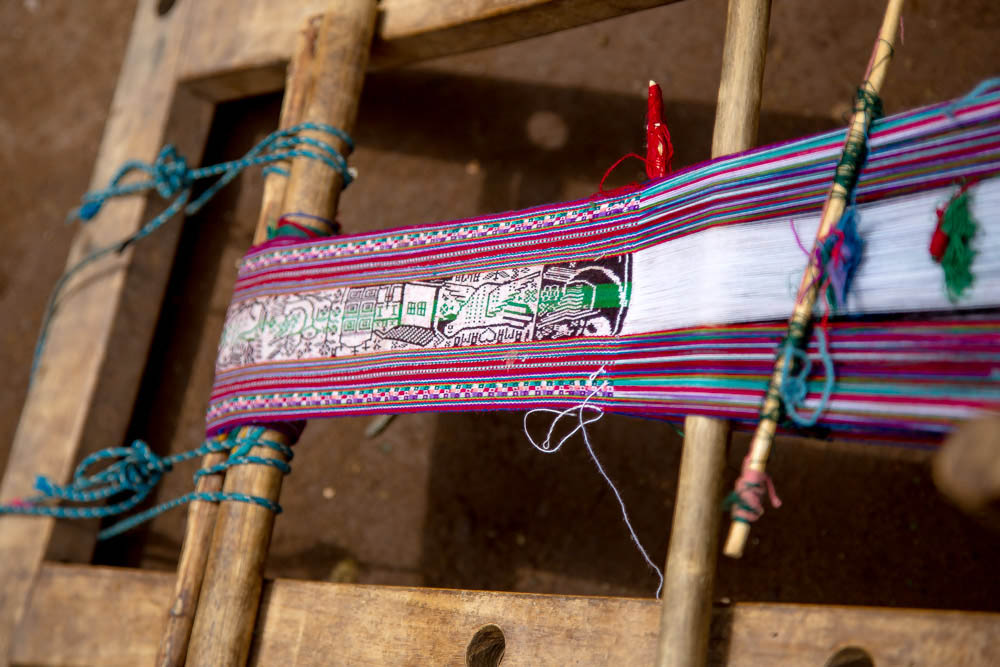 Peru is also full of the most darling little children, dressed similarly to their mothers.
Peru is also full of the most darling little children, dressed similarly to their mothers.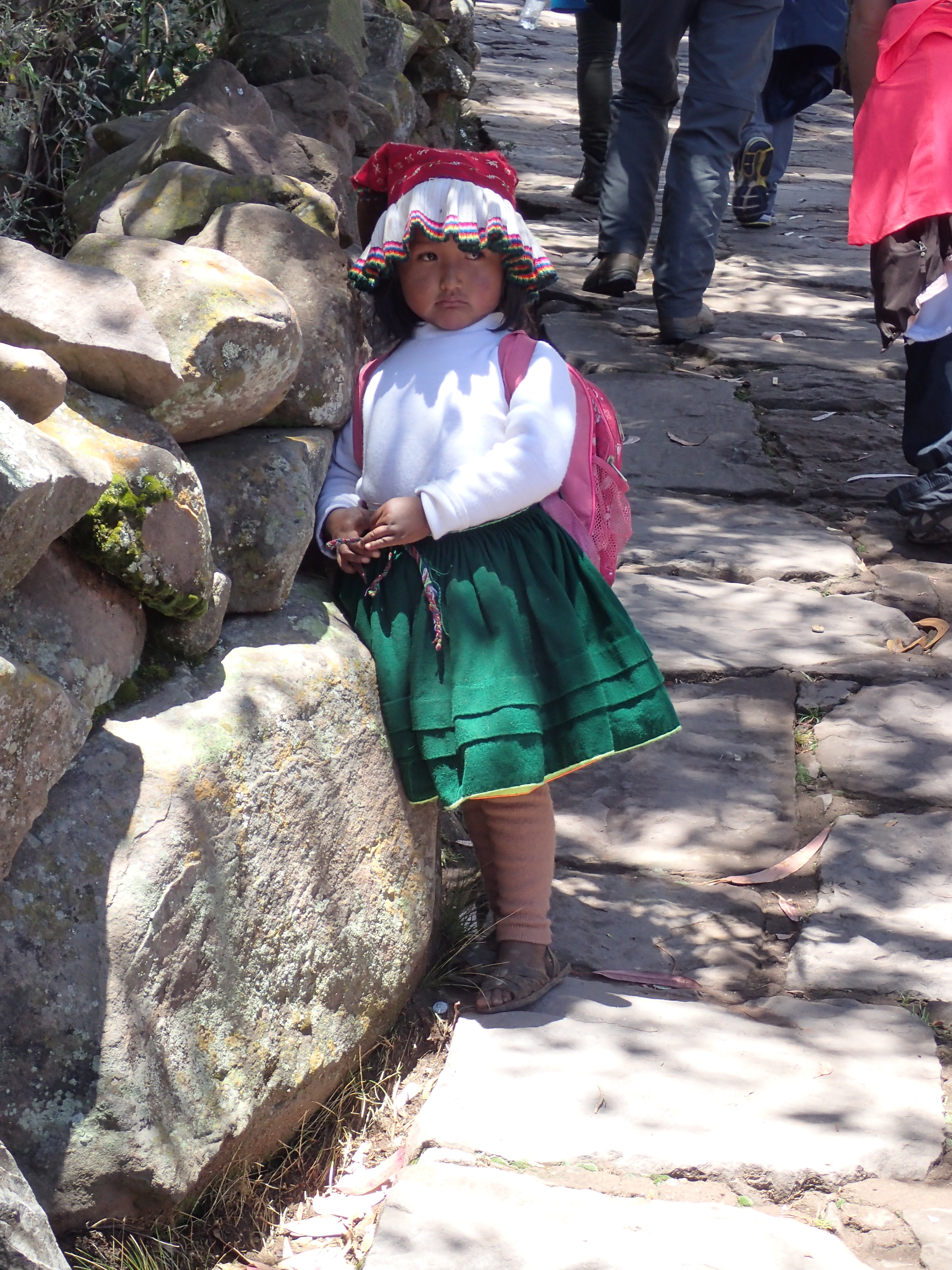 I wasn’t feeling so hot on this island. I wasn’t sure if it was altitude sickness or a stiff neck causing my headache, but after my Coke at lunch, I’m wondering if I was going through some caffeine withdrawal. Still, I slowly made it up the hill with all the others to a wonderful view.
I wasn’t feeling so hot on this island. I wasn’t sure if it was altitude sickness or a stiff neck causing my headache, but after my Coke at lunch, I’m wondering if I was going through some caffeine withdrawal. Still, I slowly made it up the hill with all the others to a wonderful view.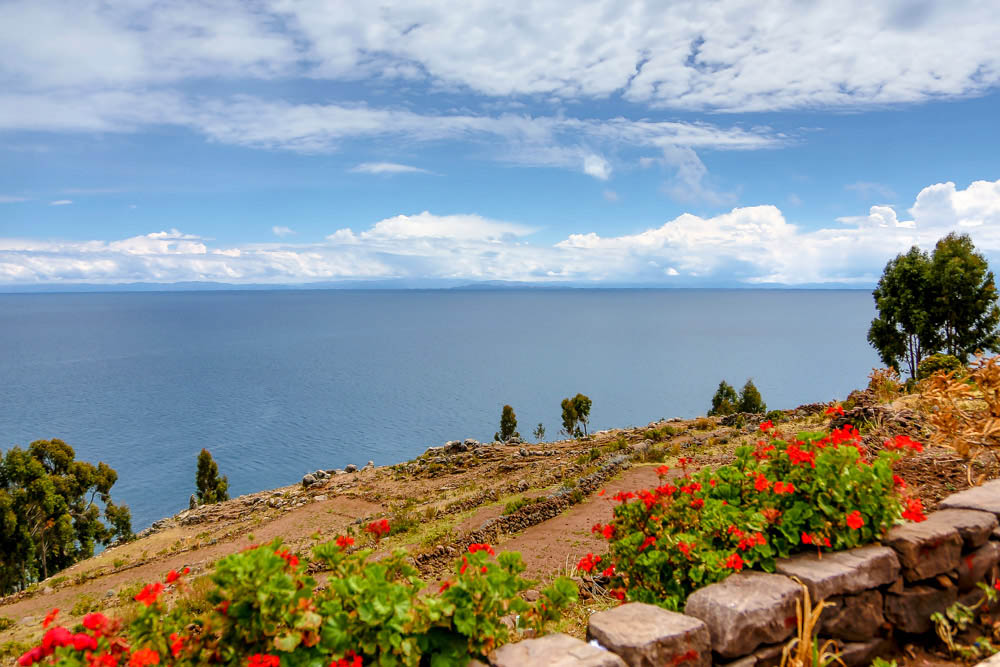
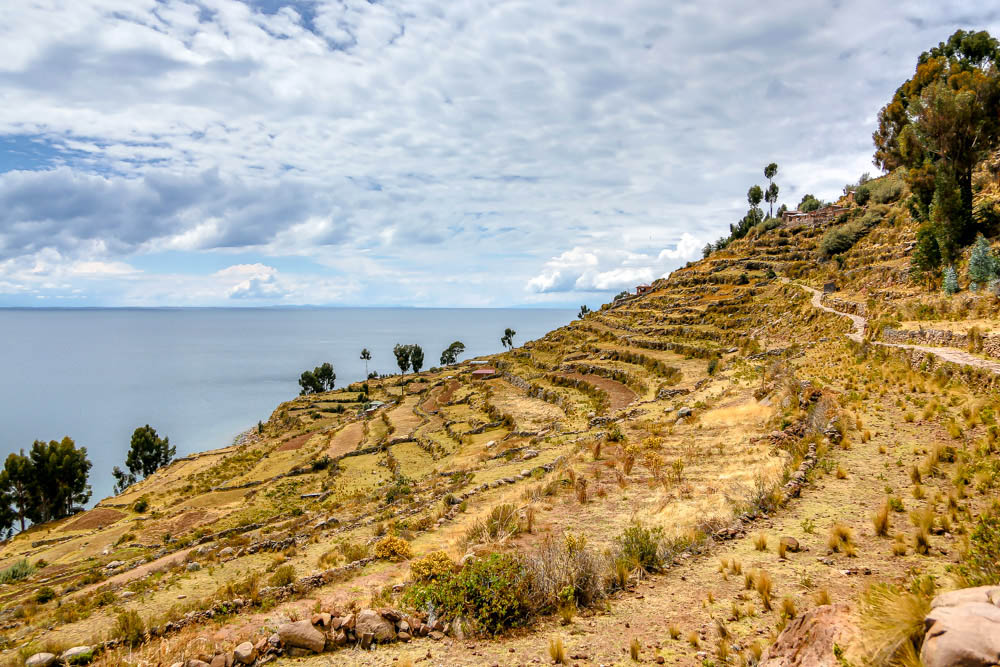 We could pay to use bathrooms from locals on this island, and they are not all the same.
We could pay to use bathrooms from locals on this island, and they are not all the same.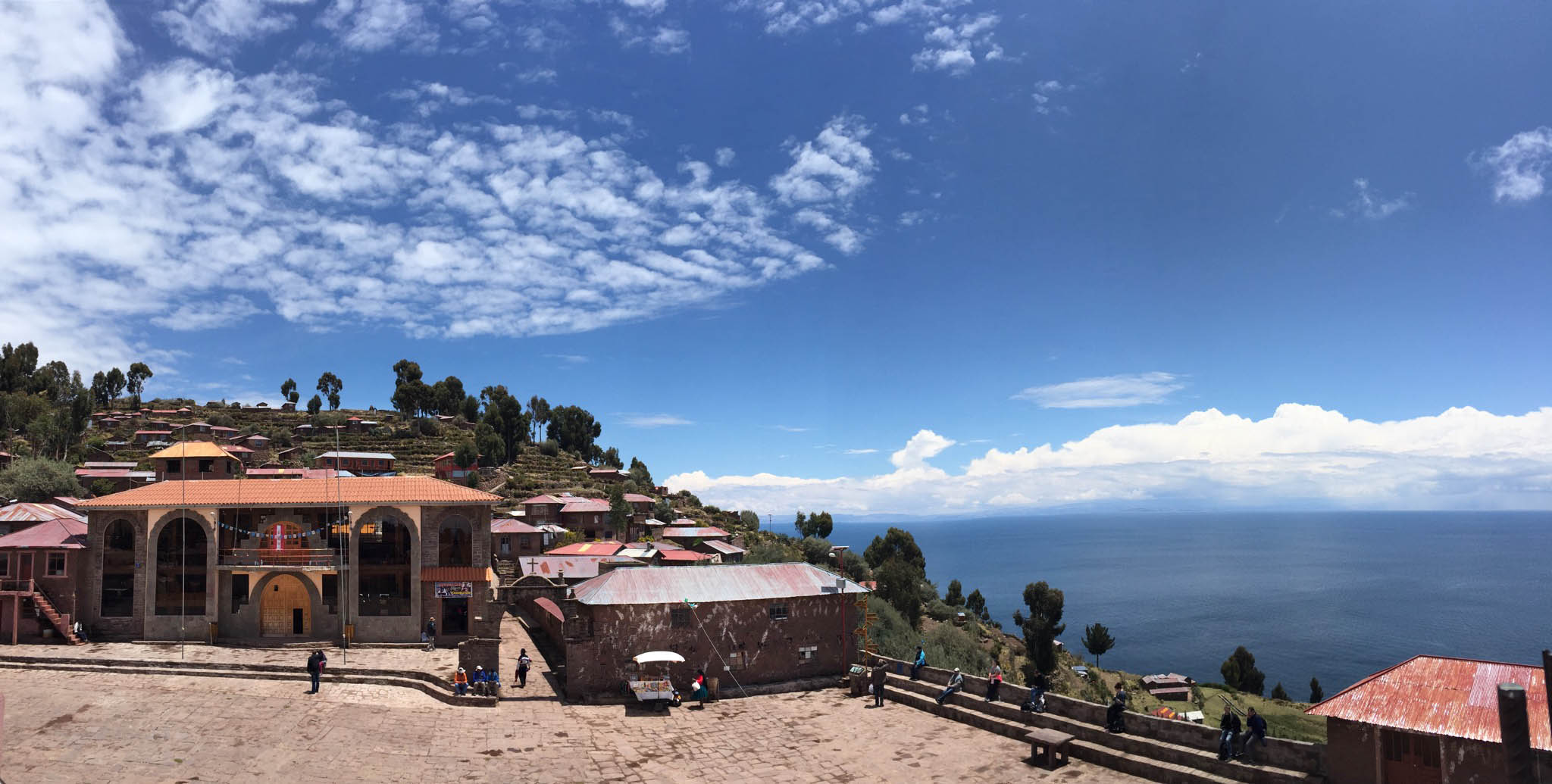 We thought the sign below was funny because Paris was on there, where we had just been on the weekend for
We thought the sign below was funny because Paris was on there, where we had just been on the weekend for 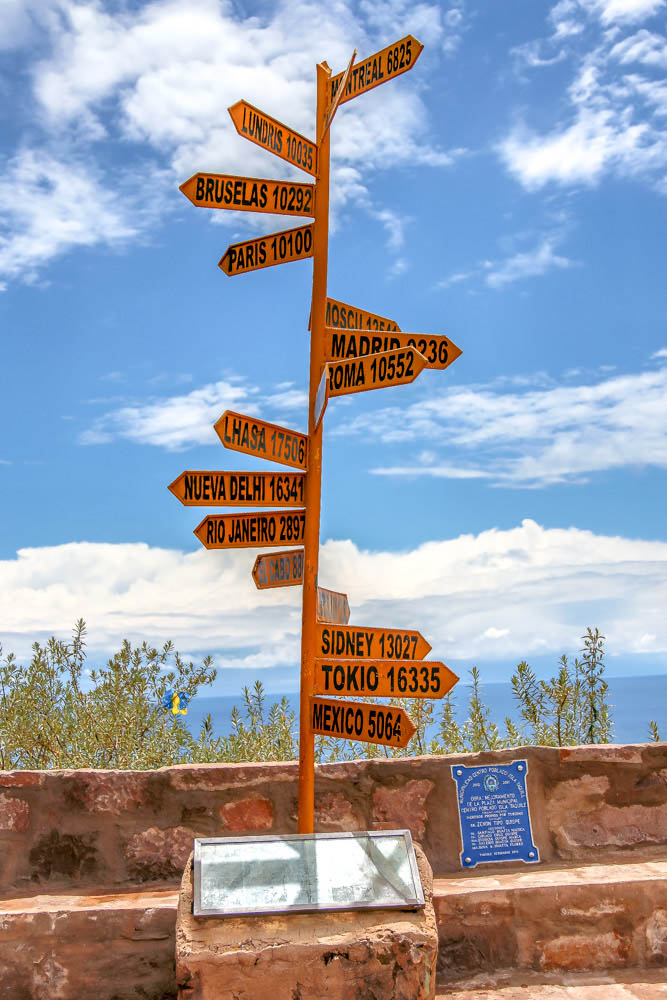
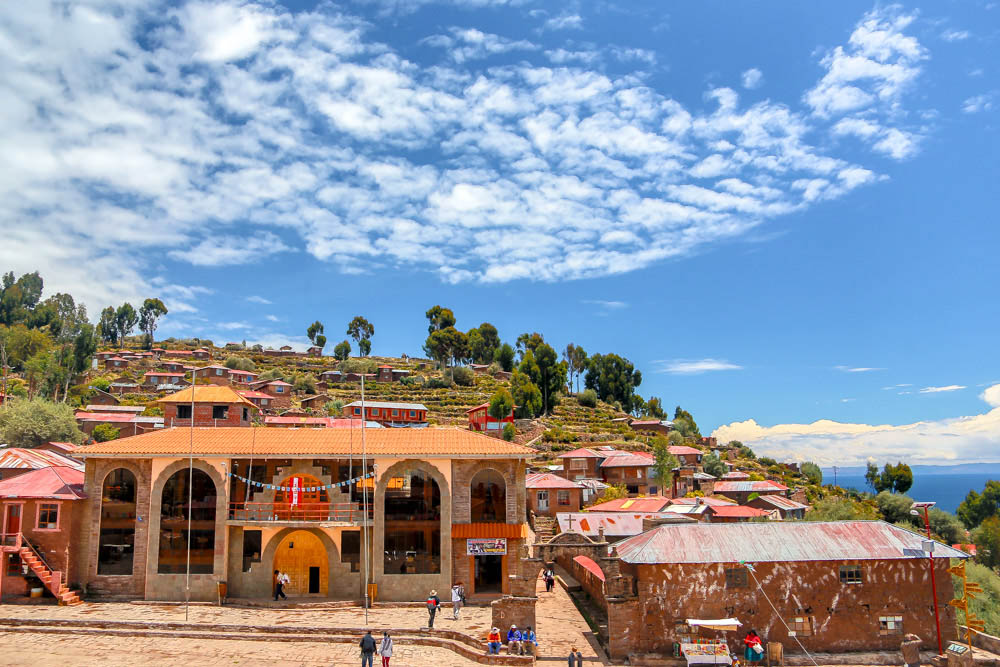
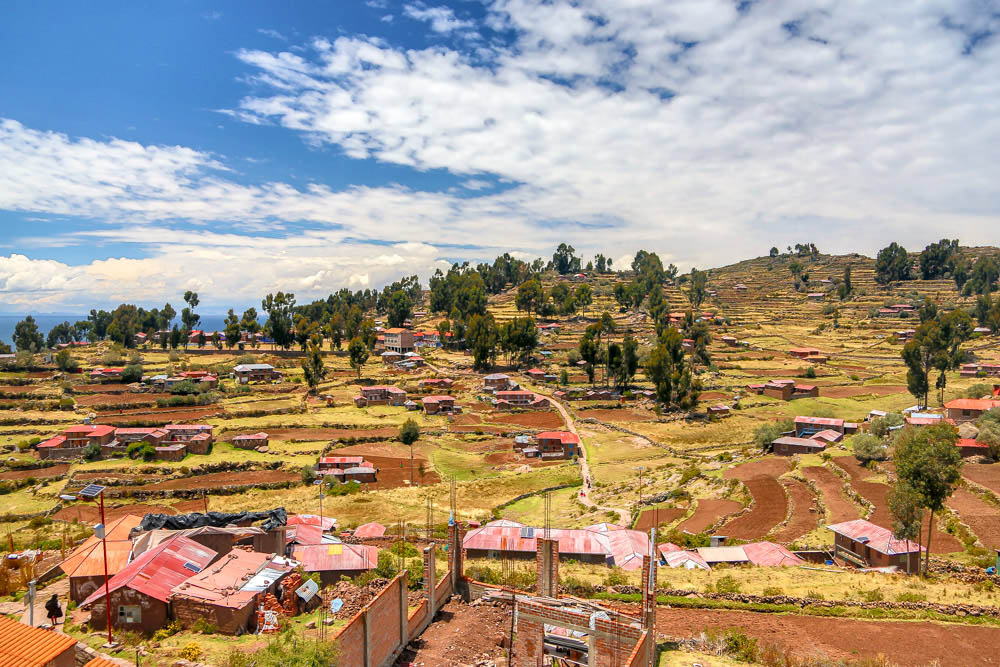 After our stop in the square, we hiked a little further up to our lunch destination.
After our stop in the square, we hiked a little further up to our lunch destination. Woolly sheep were to be seen along the way. 🙂
Woolly sheep were to be seen along the way. 🙂 And below was the view from the lunch table. It was incredible!
And below was the view from the lunch table. It was incredible!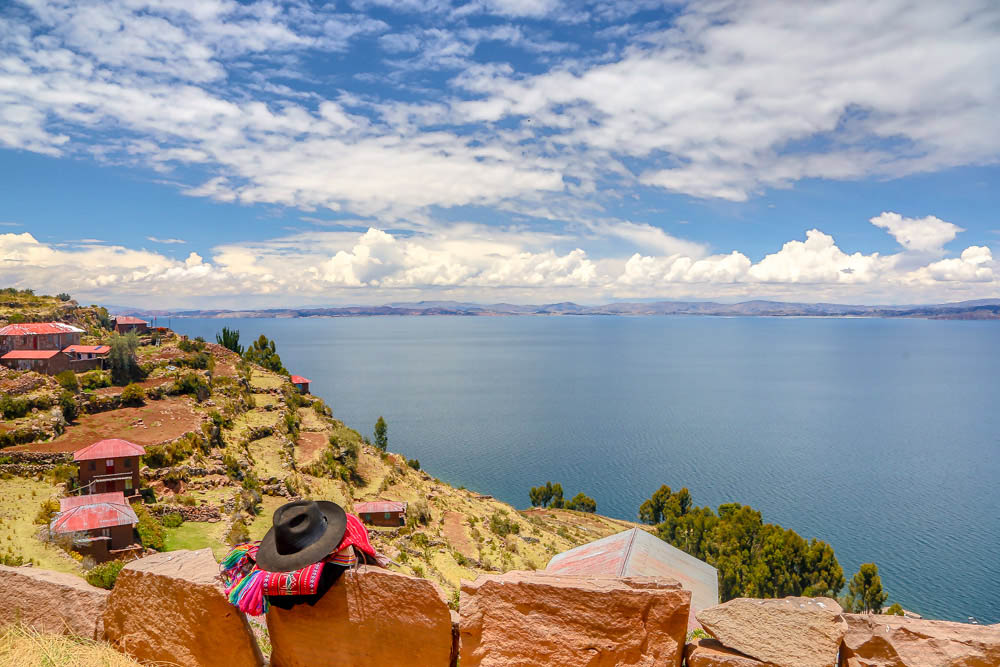 We were sat literally at the edge of the outlook.
We were sat literally at the edge of the outlook.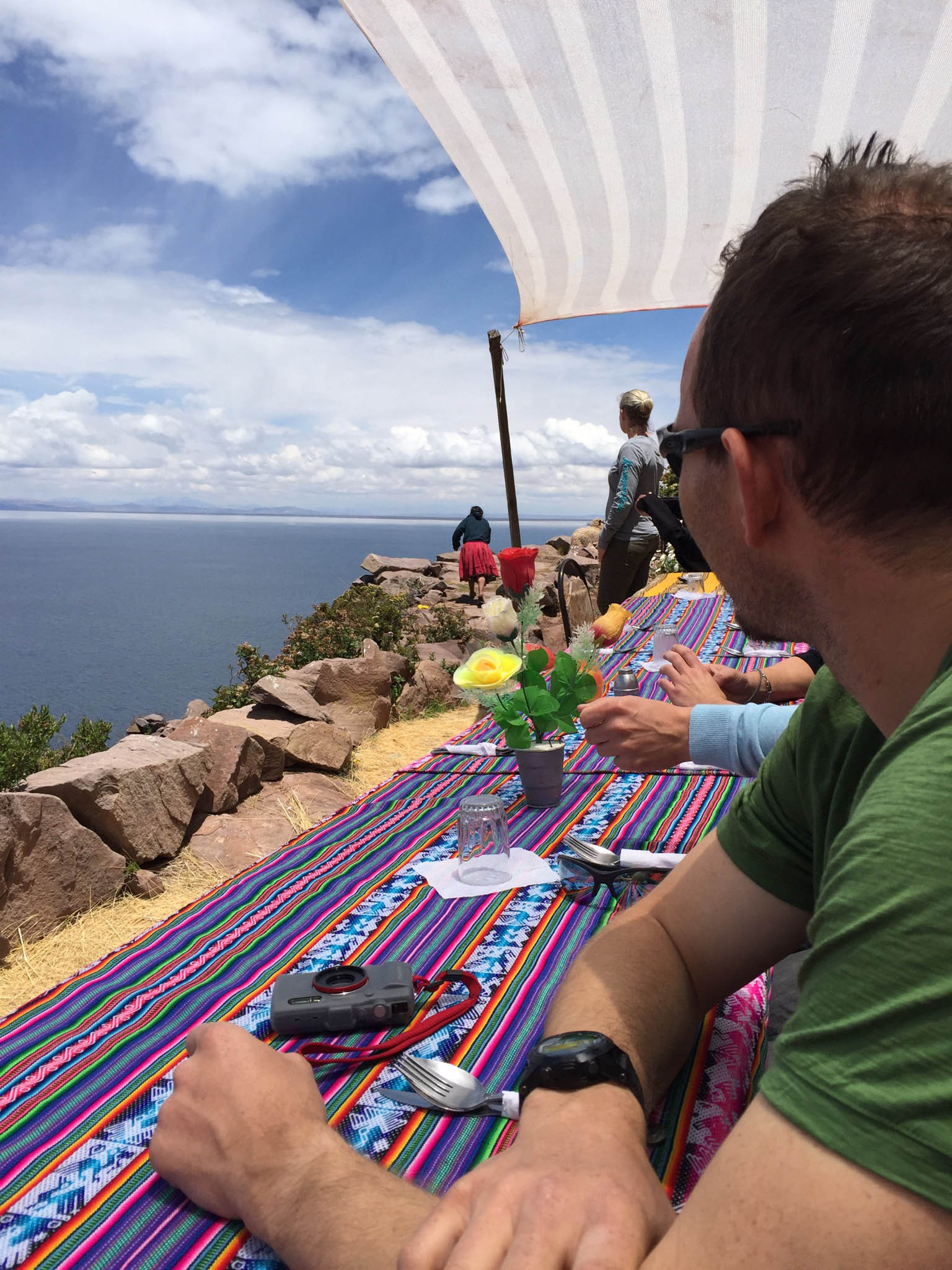 Kay was impressed.
Kay was impressed.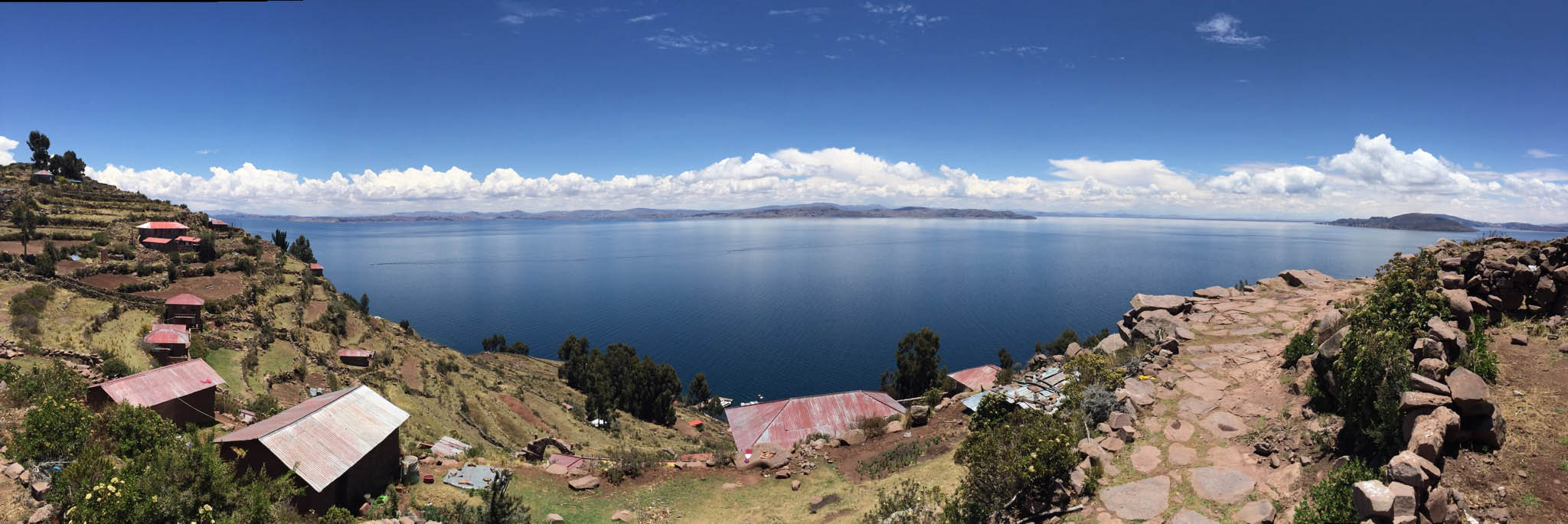
 After lunch we started to slowly make our way down the hill.
After lunch we started to slowly make our way down the hill.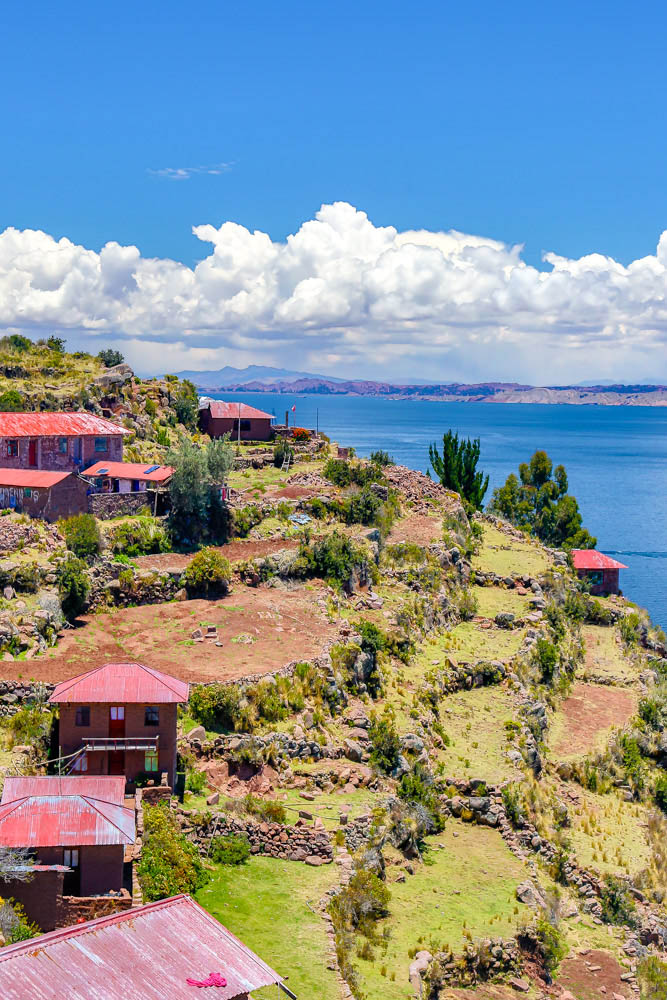 Before going down, I enjoyed a very nice toilet experience with toilet paper and soap and water. After staying in the homestay and visiting the other islands, this was really luxurious. I was impressed with the soap!
Before going down, I enjoyed a very nice toilet experience with toilet paper and soap and water. After staying in the homestay and visiting the other islands, this was really luxurious. I was impressed with the soap!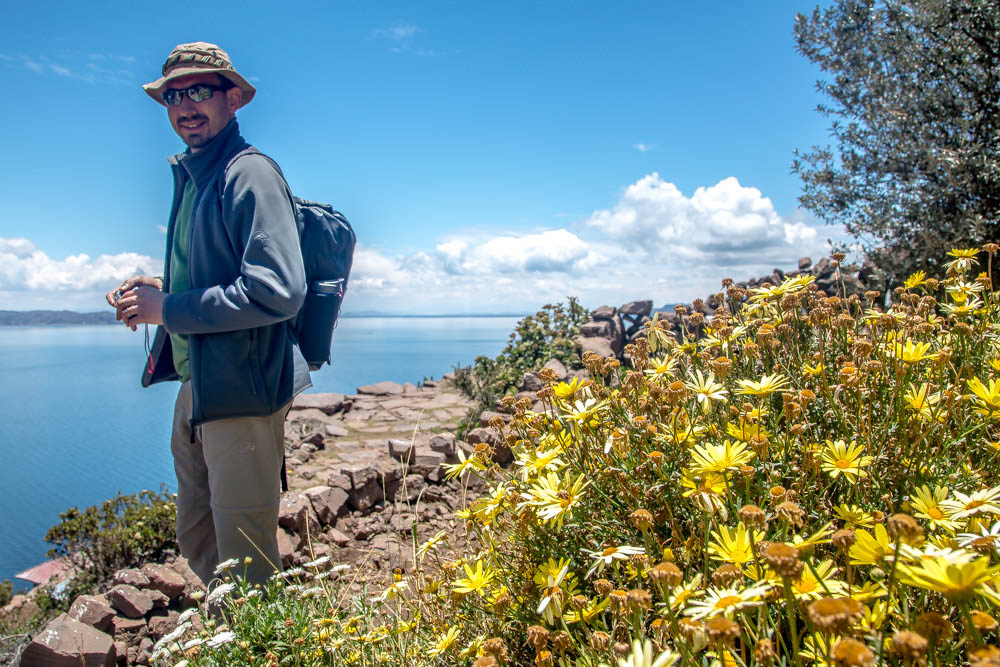
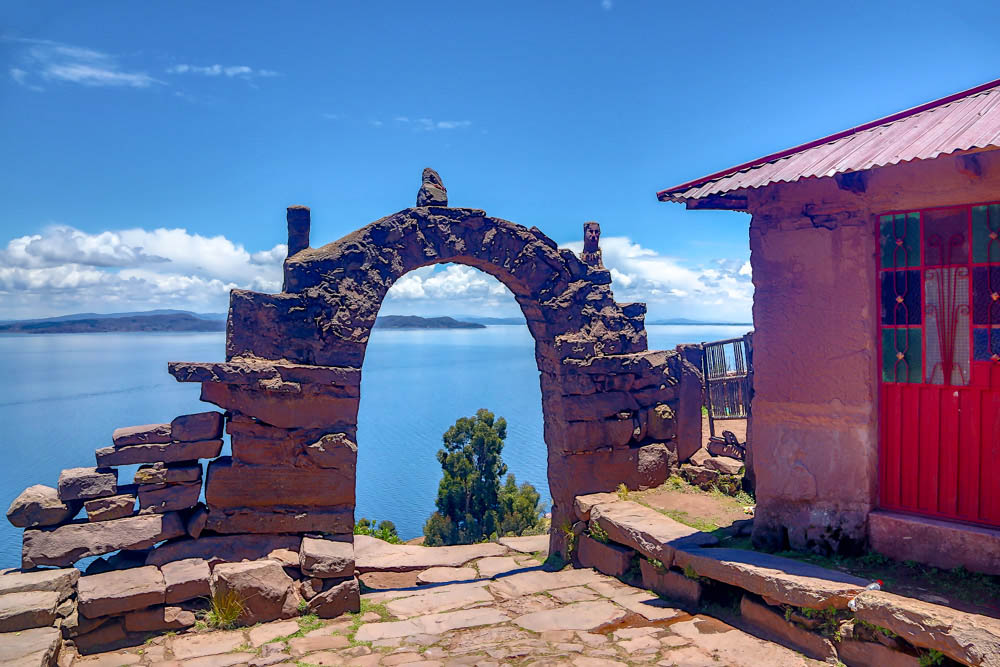
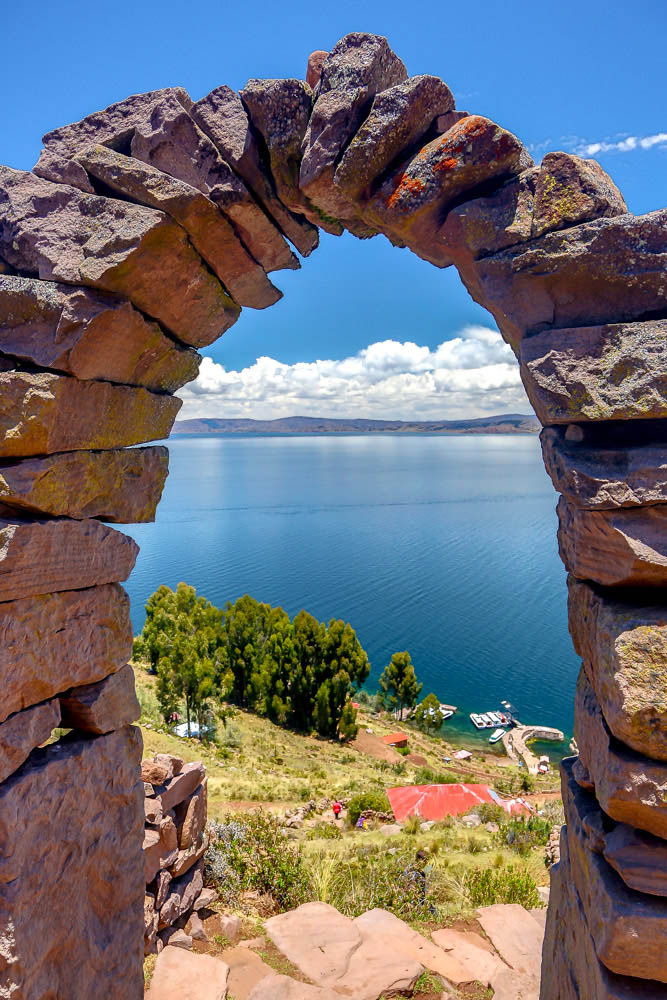 We hiked all the way down to the boats below. Or you could just say “walked”, because it was pretty easy going.
We hiked all the way down to the boats below. Or you could just say “walked”, because it was pretty easy going.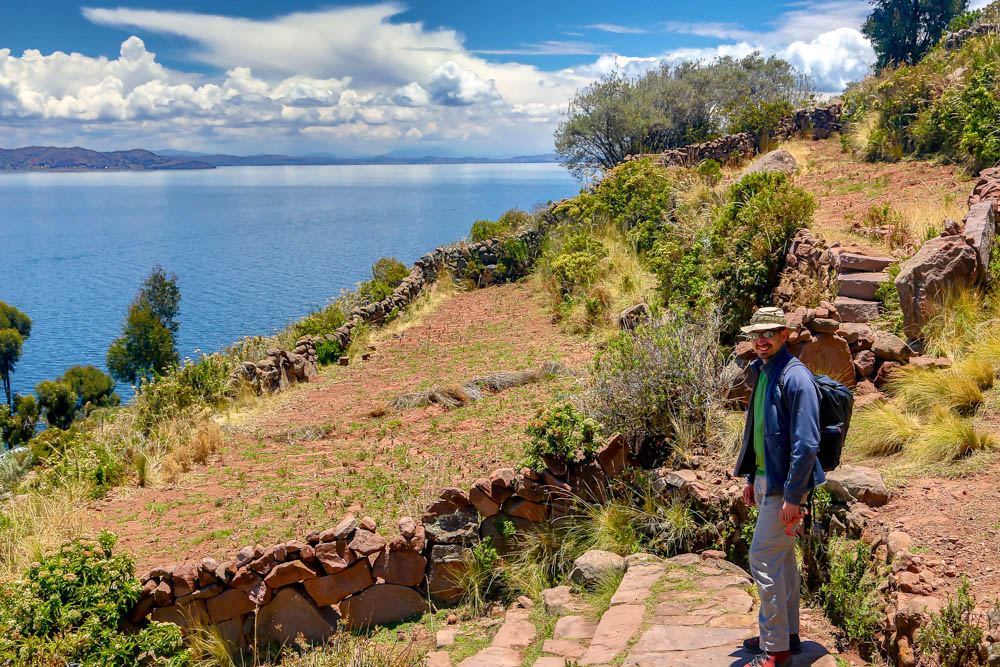 I was definitely feeling more smiley after my Coke at lunch! 🙂
I was definitely feeling more smiley after my Coke at lunch! 🙂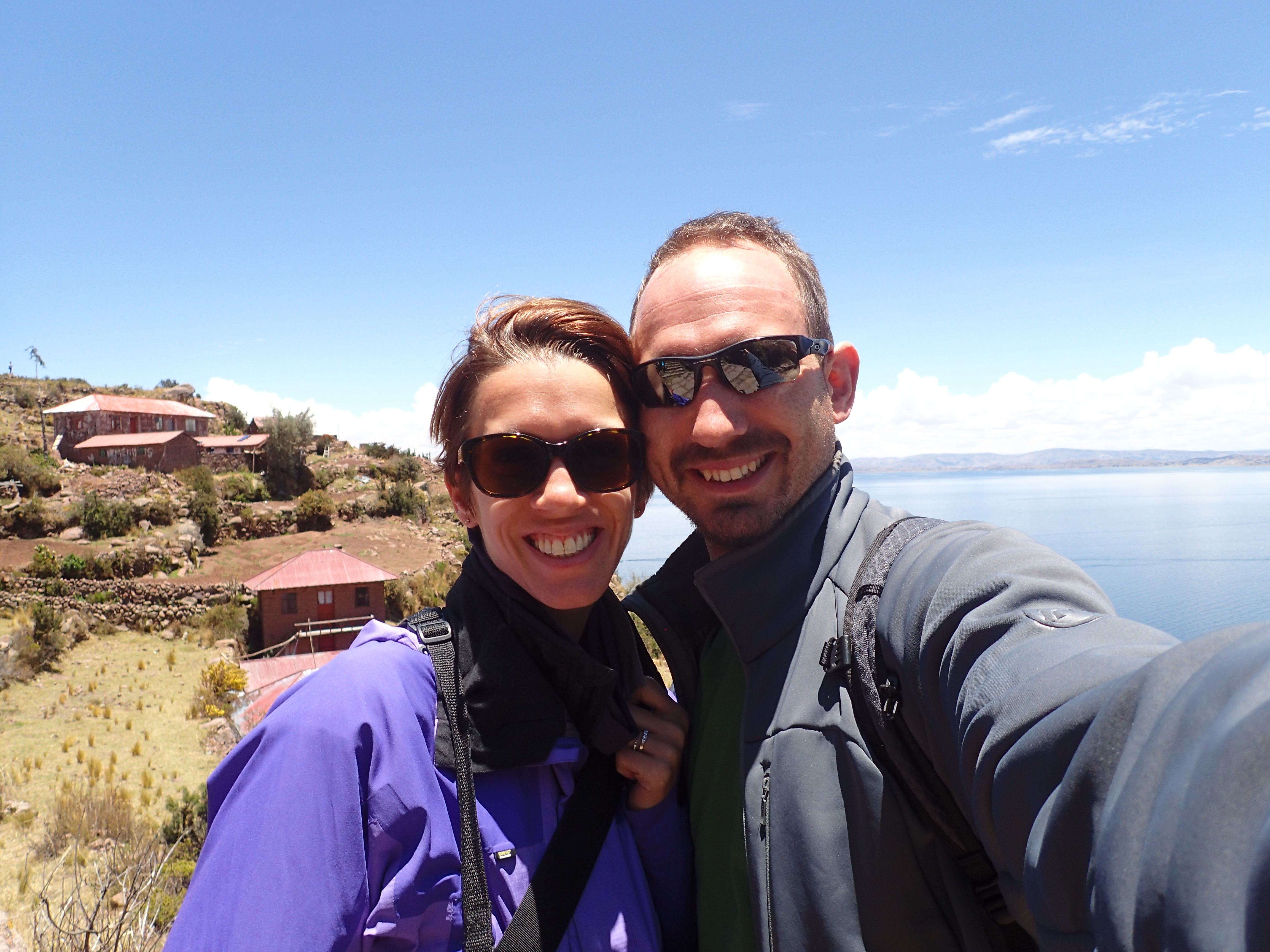
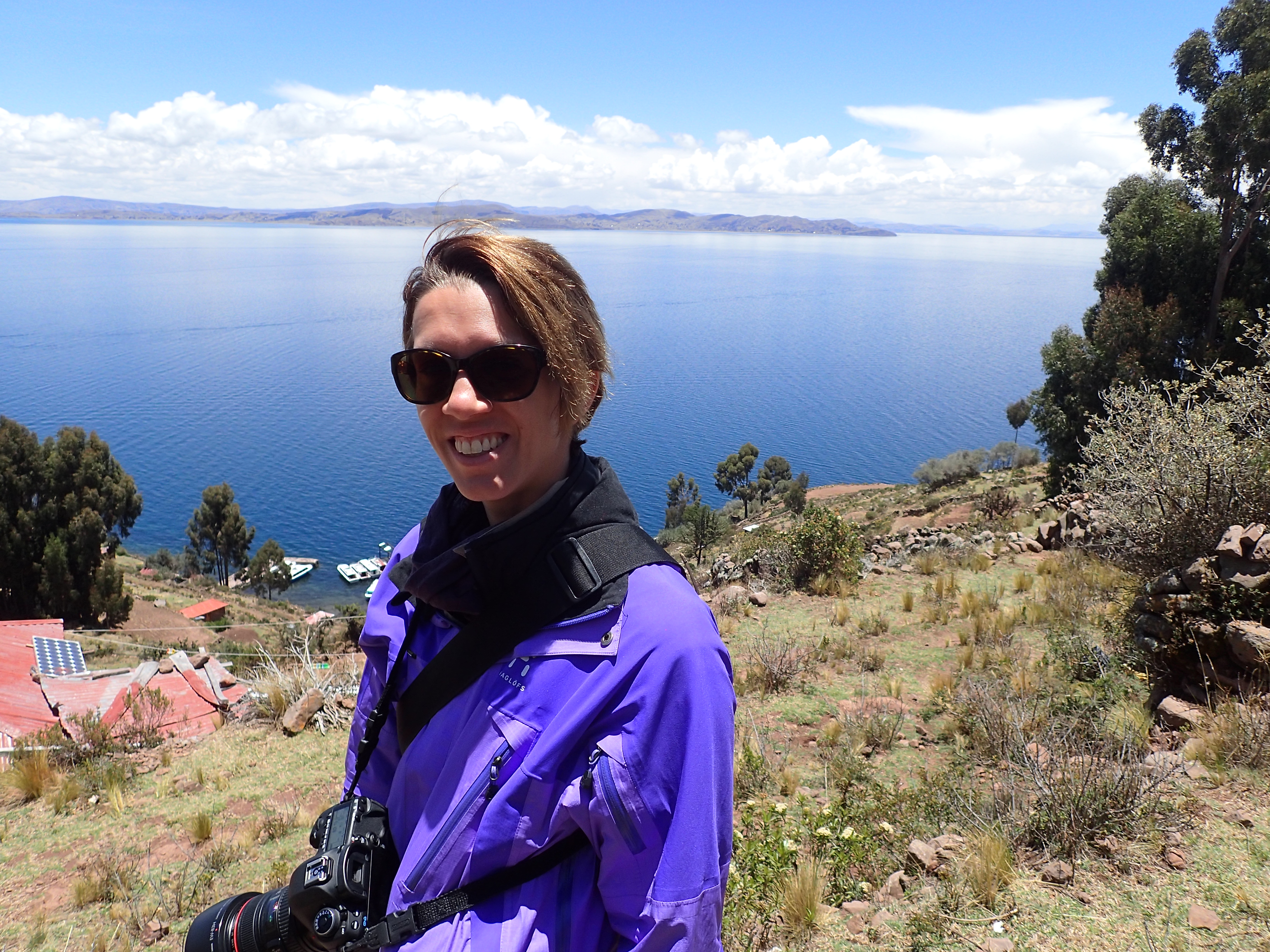
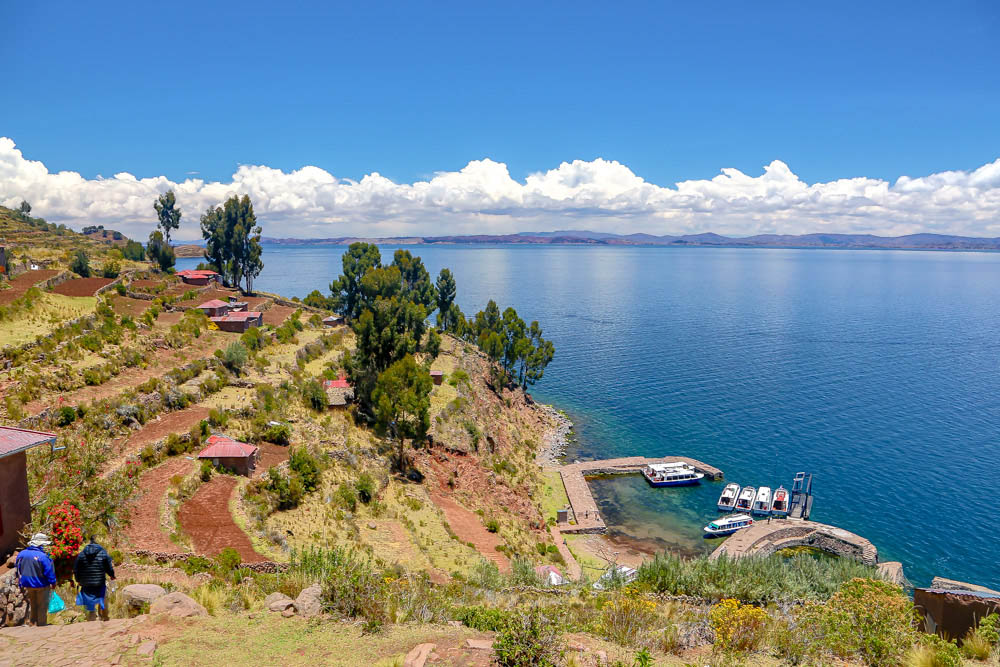
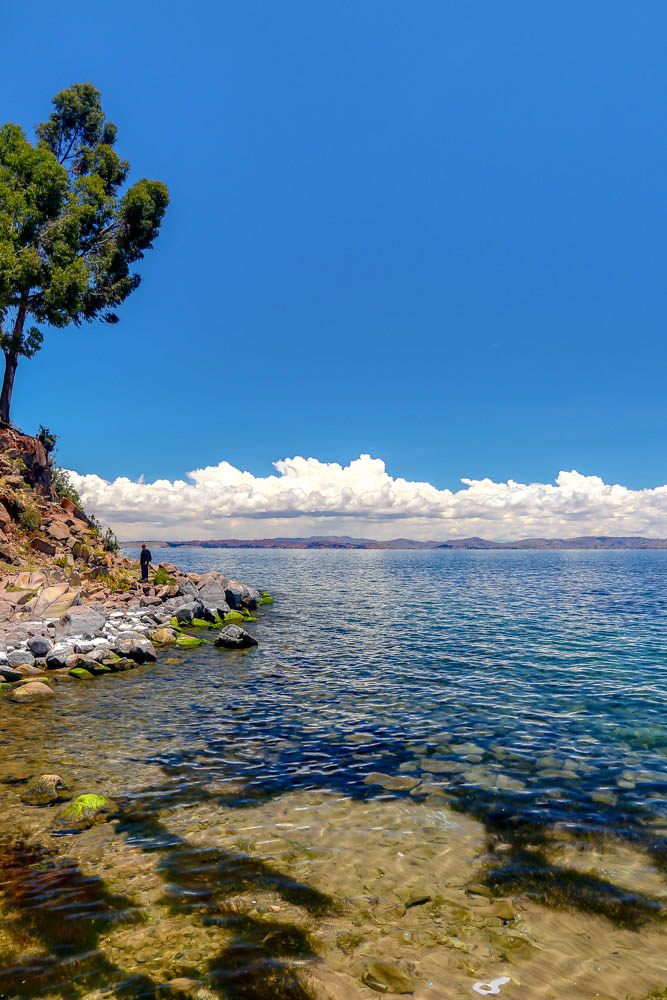 On the boat back to Puno.
On the boat back to Puno.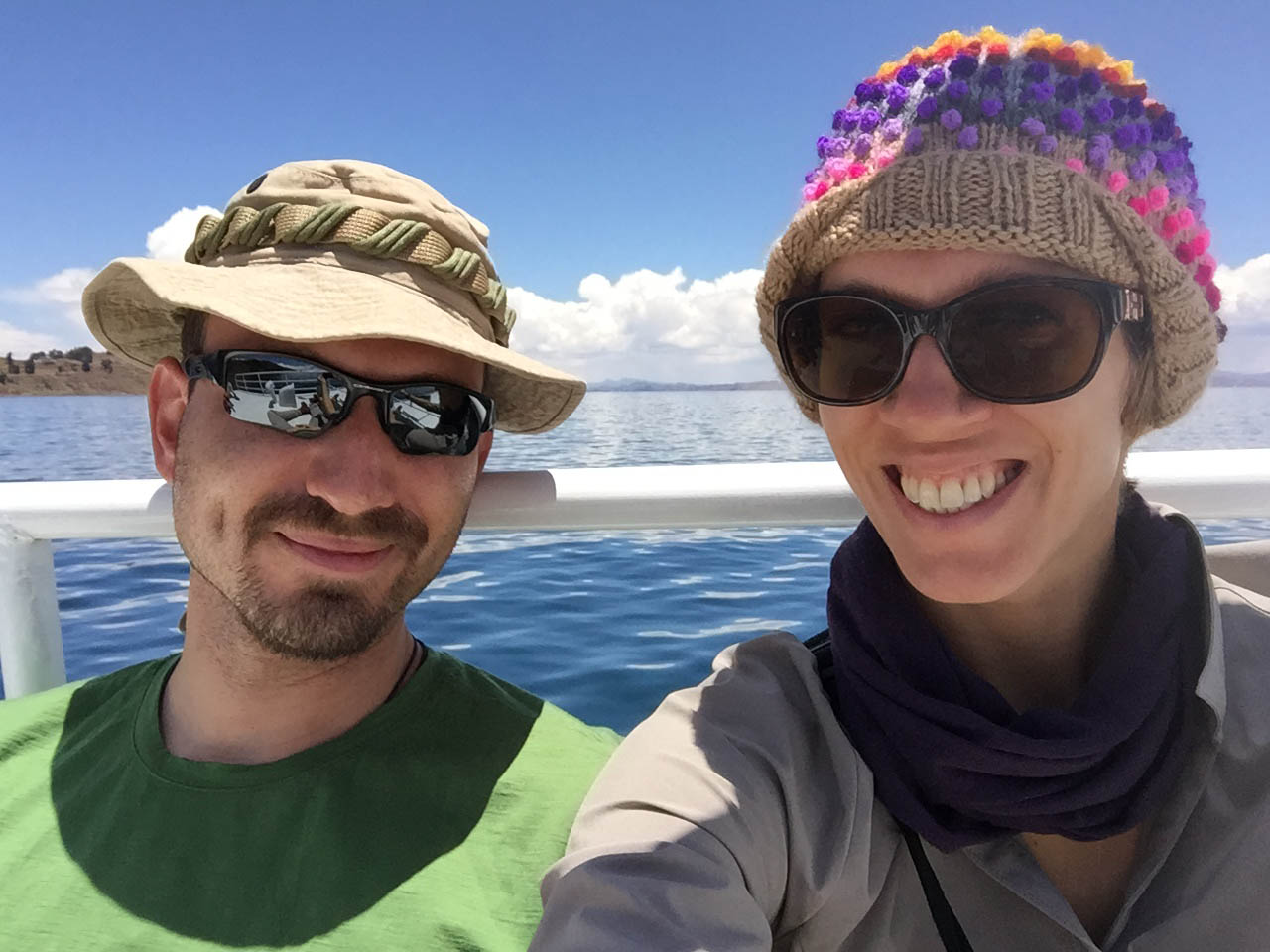
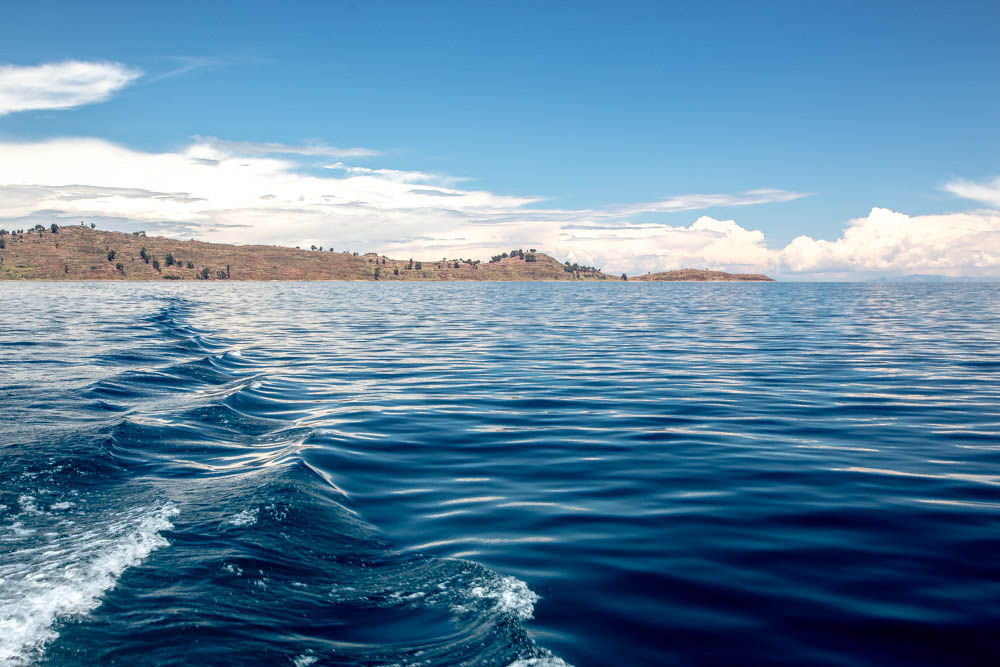 Back in Puno, we had another evening and full day before our night bus from Puno to Cusco. I wish we had cut Puno a day short and Cusco a day or two shorter, because we really could have fit another trip in, but alas… we did not know.
Back in Puno, we had another evening and full day before our night bus from Puno to Cusco. I wish we had cut Puno a day short and Cusco a day or two shorter, because we really could have fit another trip in, but alas… we did not know.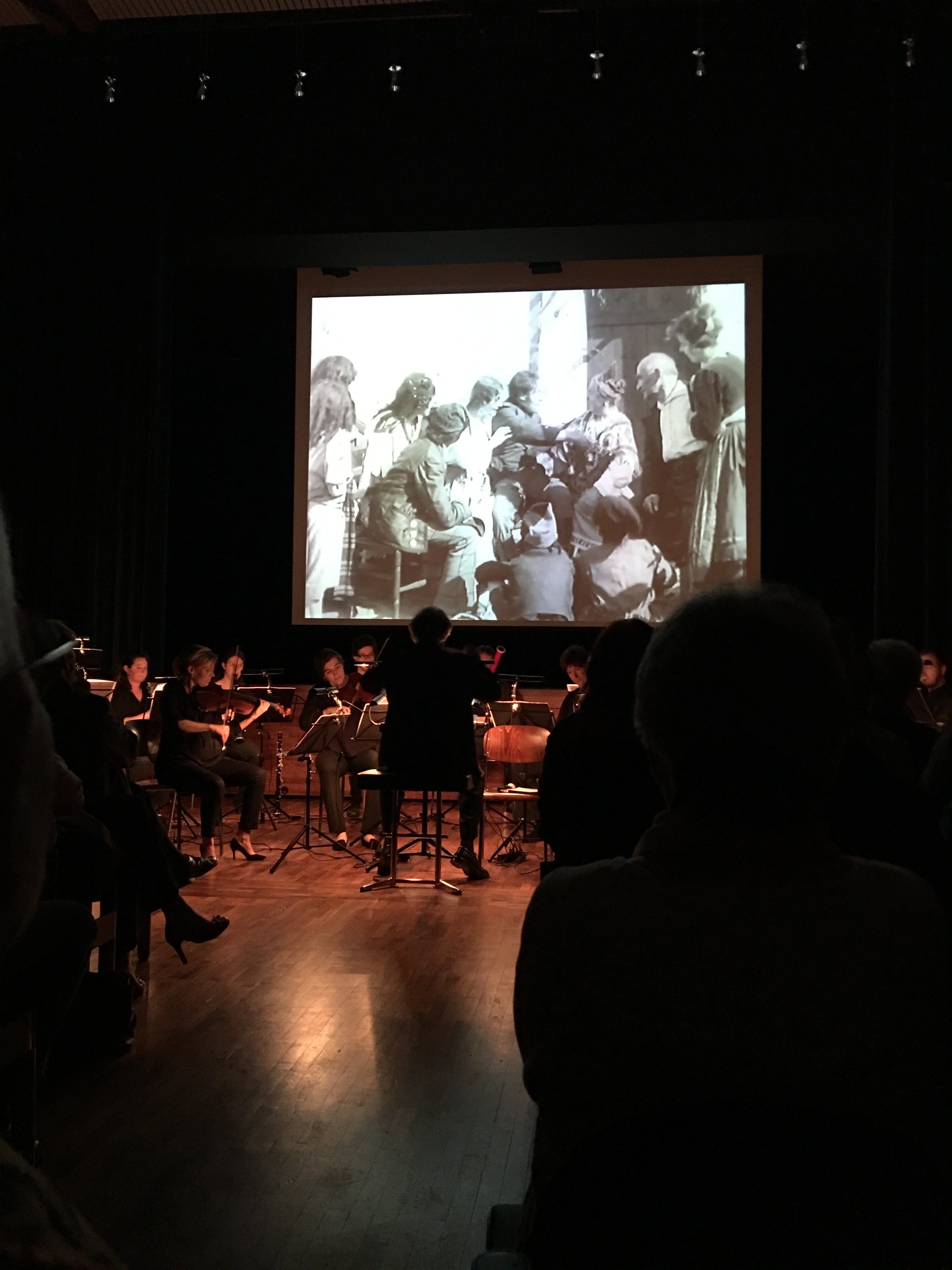
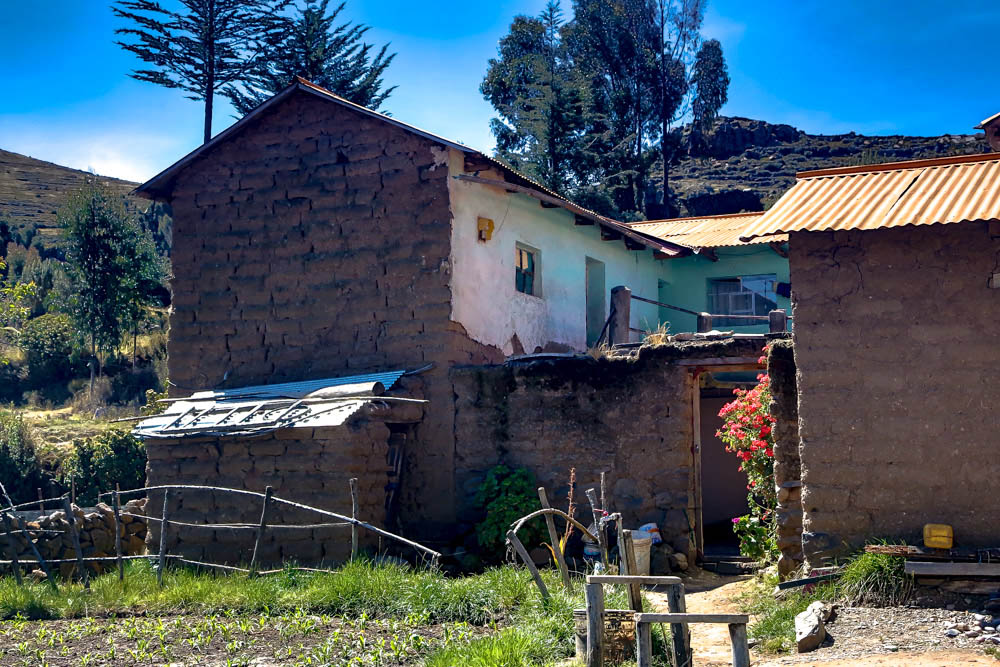
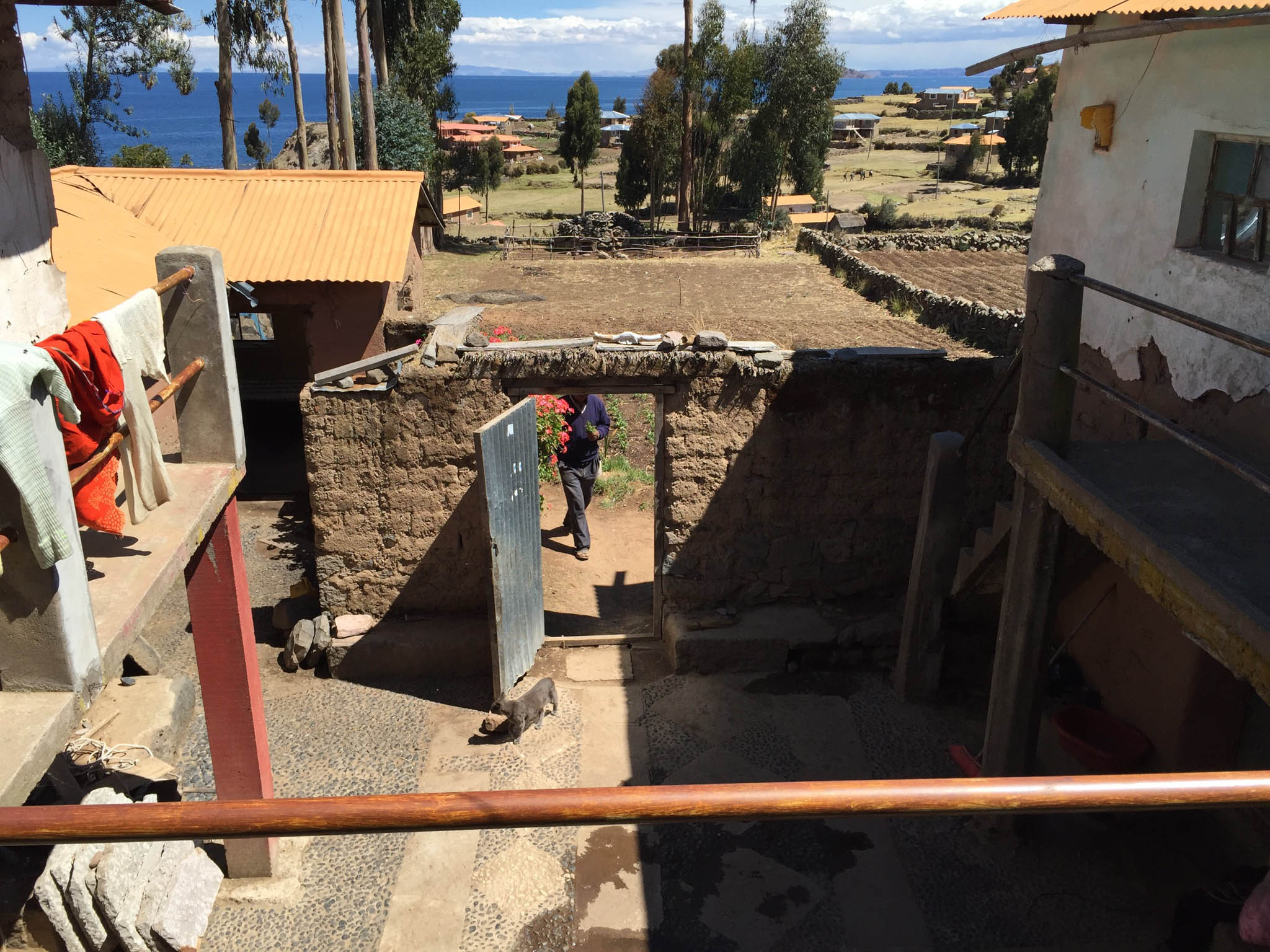 We were led to the second level of the house to a small funny, very short door that you had to duck to get into the room. There we found a nice clean bedroom with low ceilings and separate beds. No cuddling for Kay. 😉
We were led to the second level of the house to a small funny, very short door that you had to duck to get into the room. There we found a nice clean bedroom with low ceilings and separate beds. No cuddling for Kay. 😉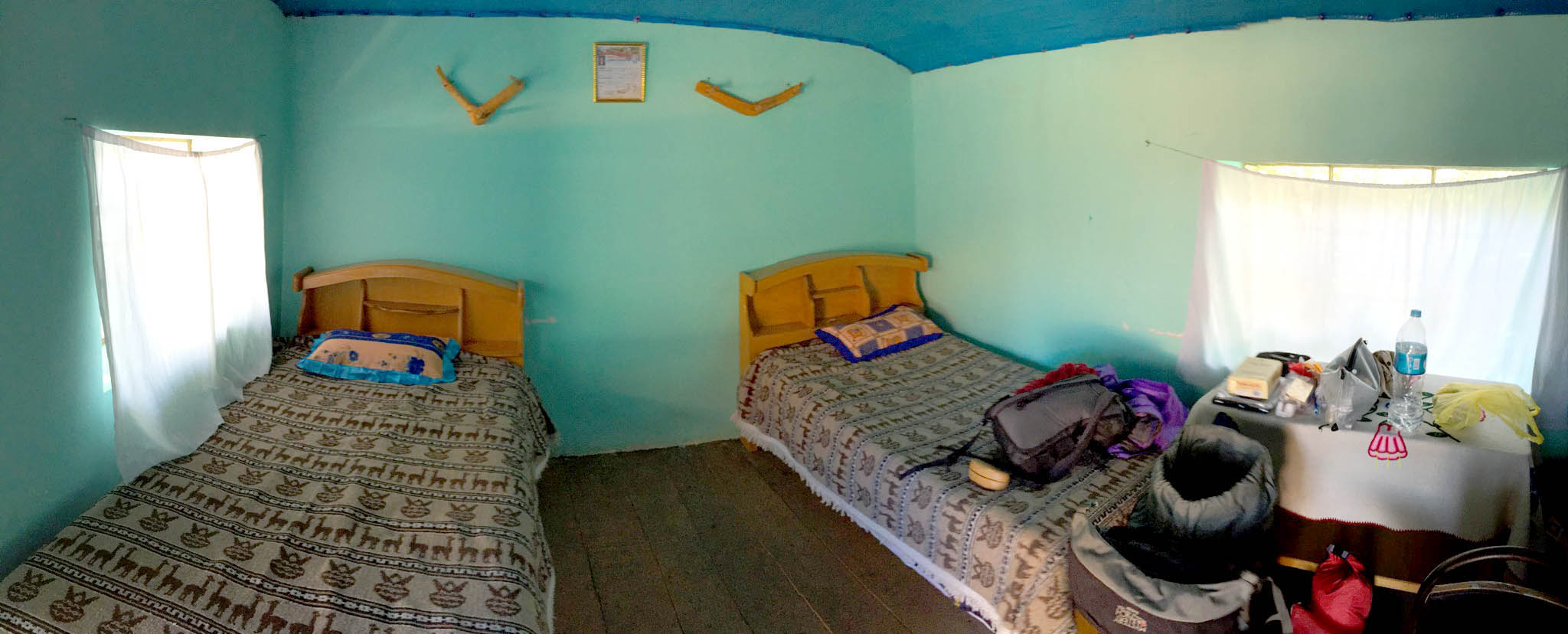 We were the only ones staying in the four bedroom room, so we dropped our things and made ourselves comfortable. Below you can see how much taller Kay was than the short door. The locals were not tall, but I like to believe that the house was also made for hobbits. 🙂
We were the only ones staying in the four bedroom room, so we dropped our things and made ourselves comfortable. Below you can see how much taller Kay was than the short door. The locals were not tall, but I like to believe that the house was also made for hobbits. 🙂 It was a lot to take in, these new surroundings that were SO different than our Swiss house back home.
It was a lot to take in, these new surroundings that were SO different than our Swiss house back home. I was a little nervous about eating. I had asked the guide about my celiac gluten problems and he said that it shouldn’t be a problem. The locals on the island mainly eat a diet of mainly corn and one of the 4000 varieties of potatoes in Peru.
I was a little nervous about eating. I had asked the guide about my celiac gluten problems and he said that it shouldn’t be a problem. The locals on the island mainly eat a diet of mainly corn and one of the 4000 varieties of potatoes in Peru.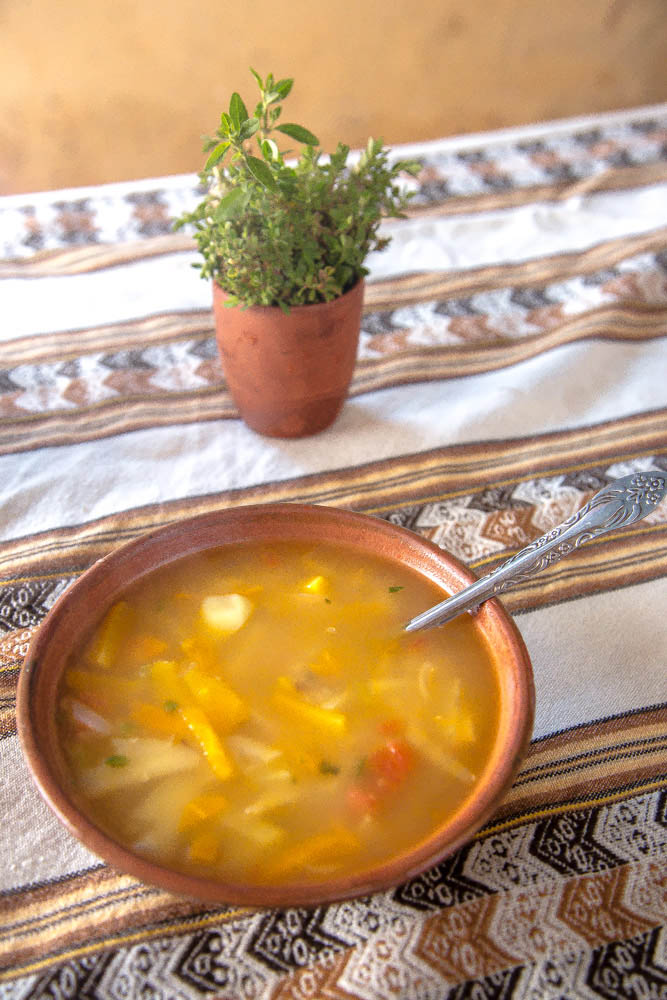 Our mama also showed us that the little plant on the table is not for decoration. It is actually muña tea leaves. She showed us to take some and put it in our cups with hot water. It was so delicious, I actually preferred it over coca tea. It has a bit of a minty flavor.
Our mama also showed us that the little plant on the table is not for decoration. It is actually muña tea leaves. She showed us to take some and put it in our cups with hot water. It was so delicious, I actually preferred it over coca tea. It has a bit of a minty flavor.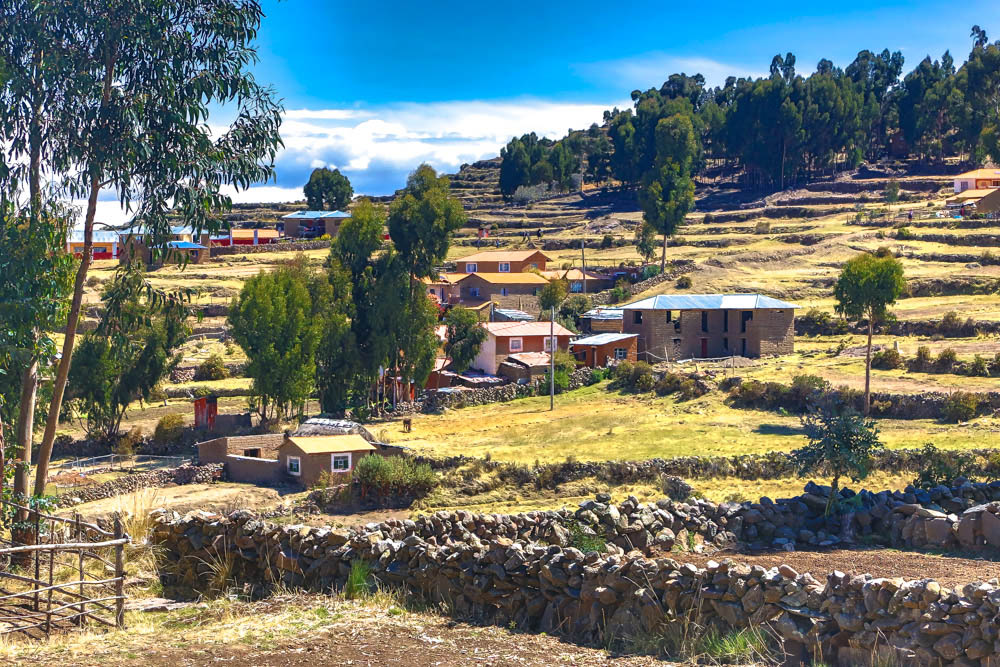 Chickens in the front yard, although meat is eaten pretty seldom on the island.
Chickens in the front yard, although meat is eaten pretty seldom on the island.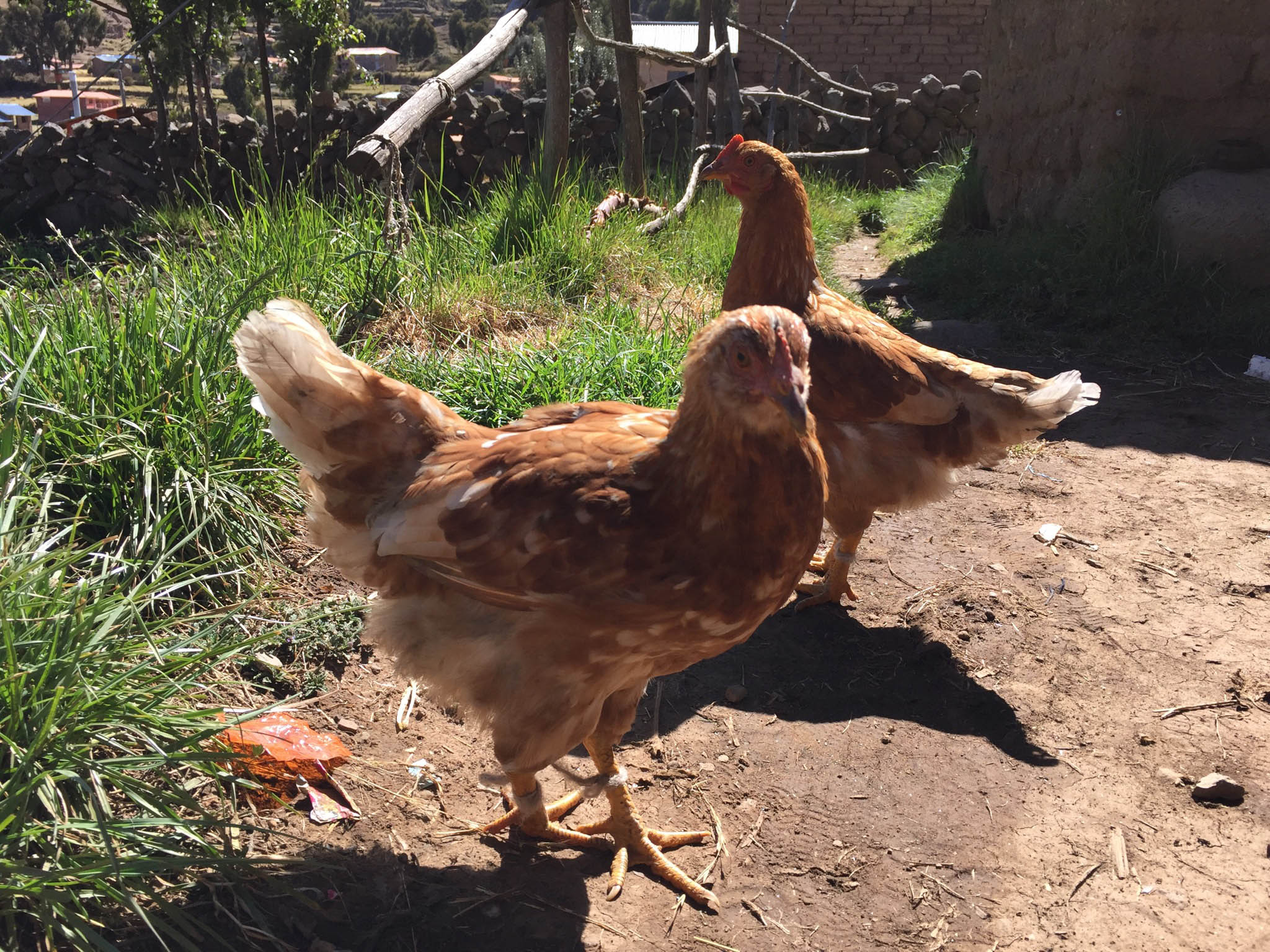 The house had a water tap out in the front yard and this was the only water supply. There was no running water in the house, including the bathroom. I was pretty happy that Kay brought his hand sanitizer! We would flush by using a bucket of rain water. I am used to flushing by bucket by now, but in Thailand we could usually wash our hands in running water, so this was something new to me, to see how people live with very minimal amenities.
The house had a water tap out in the front yard and this was the only water supply. There was no running water in the house, including the bathroom. I was pretty happy that Kay brought his hand sanitizer! We would flush by using a bucket of rain water. I am used to flushing by bucket by now, but in Thailand we could usually wash our hands in running water, so this was something new to me, to see how people live with very minimal amenities. 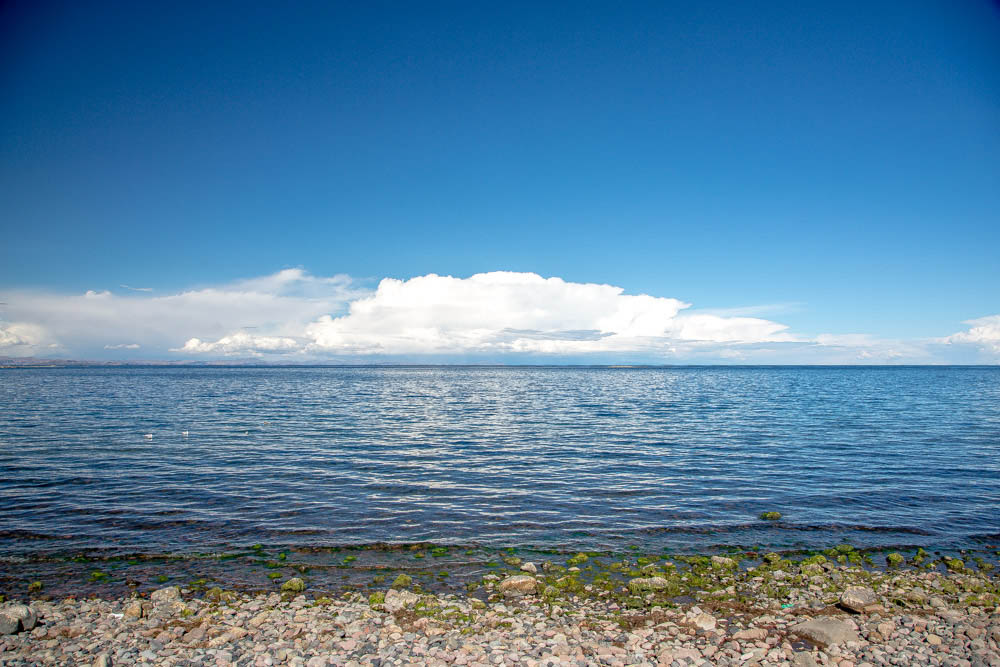 Down by the coast, the scenery was beautiful, but still pretty cold. It warmed up a little during the day, but it was freezing by night. The people here are used to both the altitude and the harsh weather conditions. Many of the women did not need shoes and still had the warmest hands!
Down by the coast, the scenery was beautiful, but still pretty cold. It warmed up a little during the day, but it was freezing by night. The people here are used to both the altitude and the harsh weather conditions. Many of the women did not need shoes and still had the warmest hands!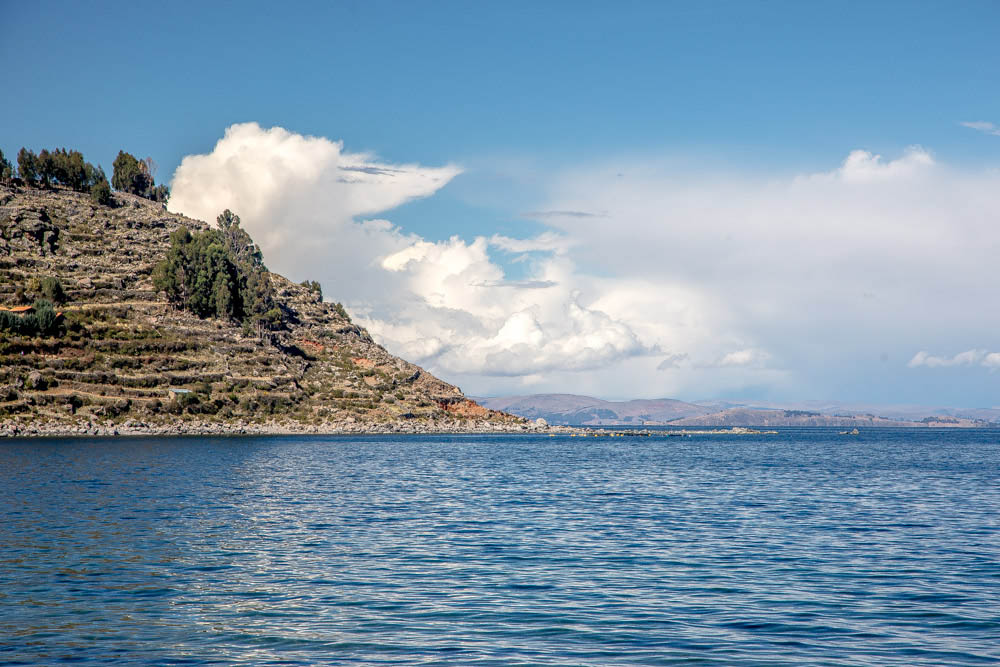
 Kay and I were enjoying the warmth from walking up the hills. We needed to take our time, being out of breath, but it was the first time that we were really warm! 🙂
Kay and I were enjoying the warmth from walking up the hills. We needed to take our time, being out of breath, but it was the first time that we were really warm! 🙂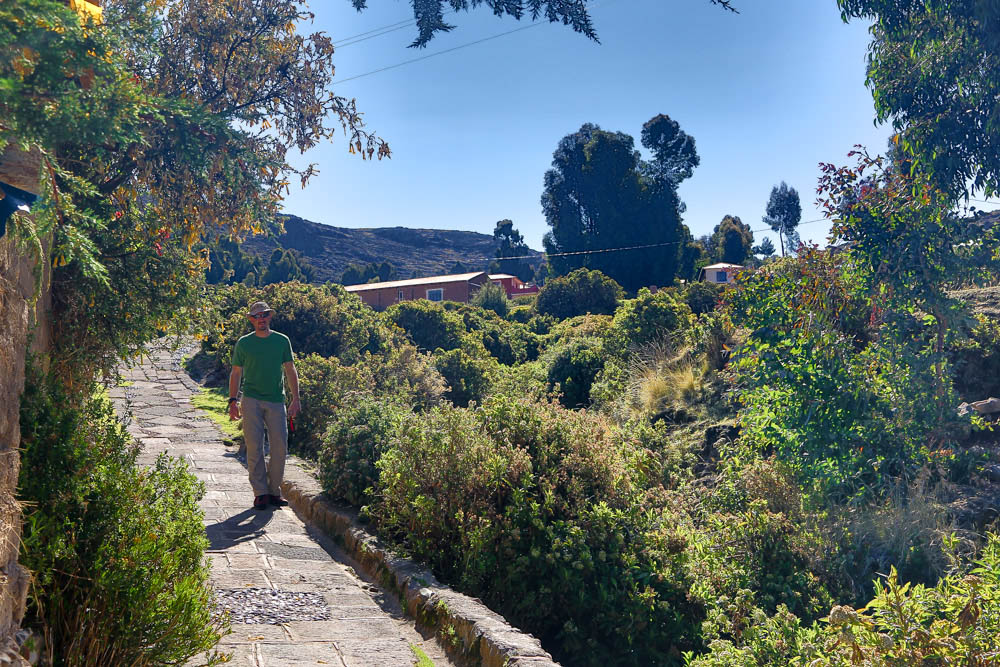
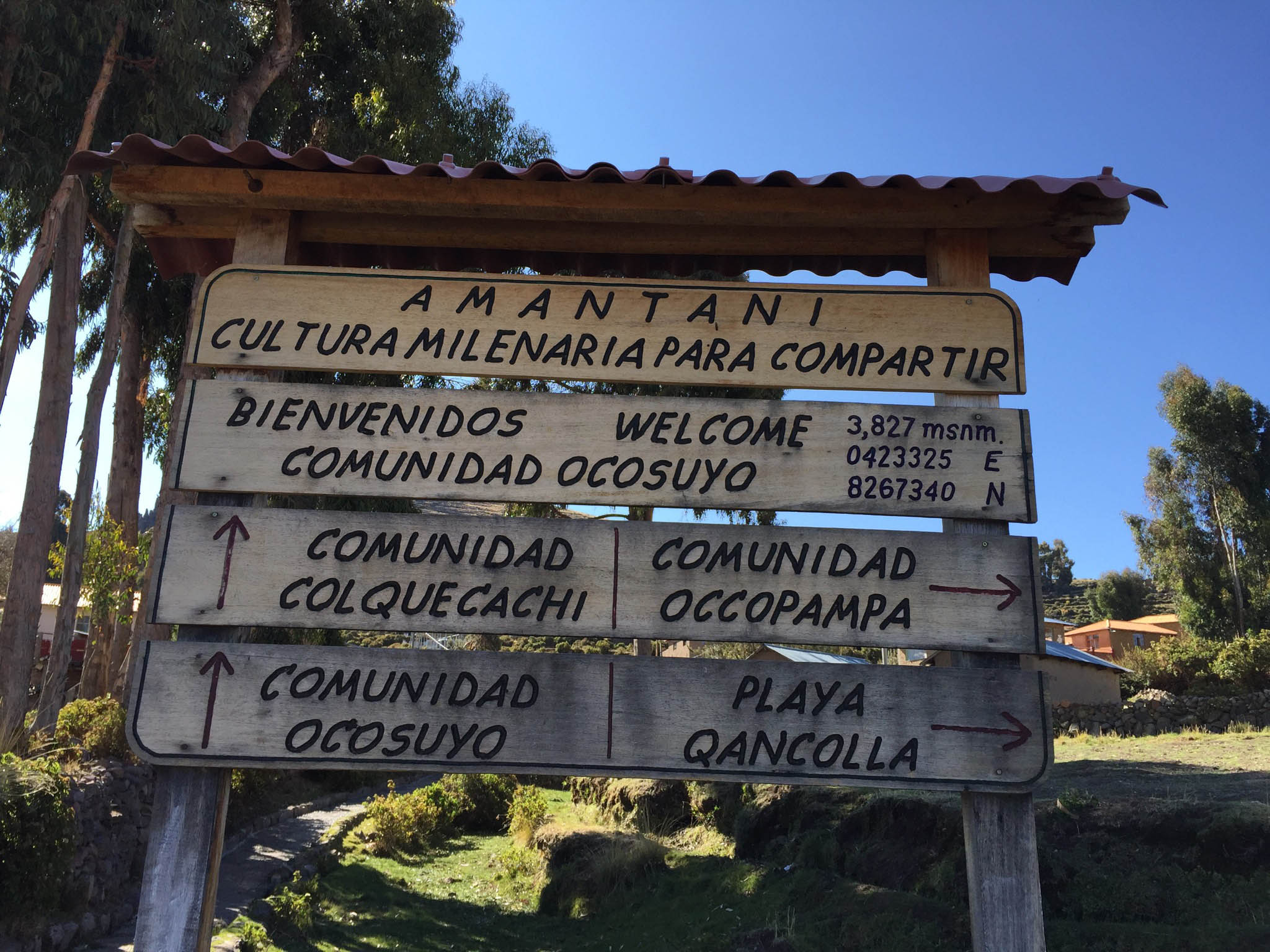 The island has a school for the children, much like the floating islands, but it was on the other side of the island from where we stayed. The youngest daughter in the house needed to get up early and walk across the whole island every day to go to school. We were a little surprised to see she had some Western items like a new-age backpack, with all her other very traditional Peruvian clothing.
The island has a school for the children, much like the floating islands, but it was on the other side of the island from where we stayed. The youngest daughter in the house needed to get up early and walk across the whole island every day to go to school. We were a little surprised to see she had some Western items like a new-age backpack, with all her other very traditional Peruvian clothing.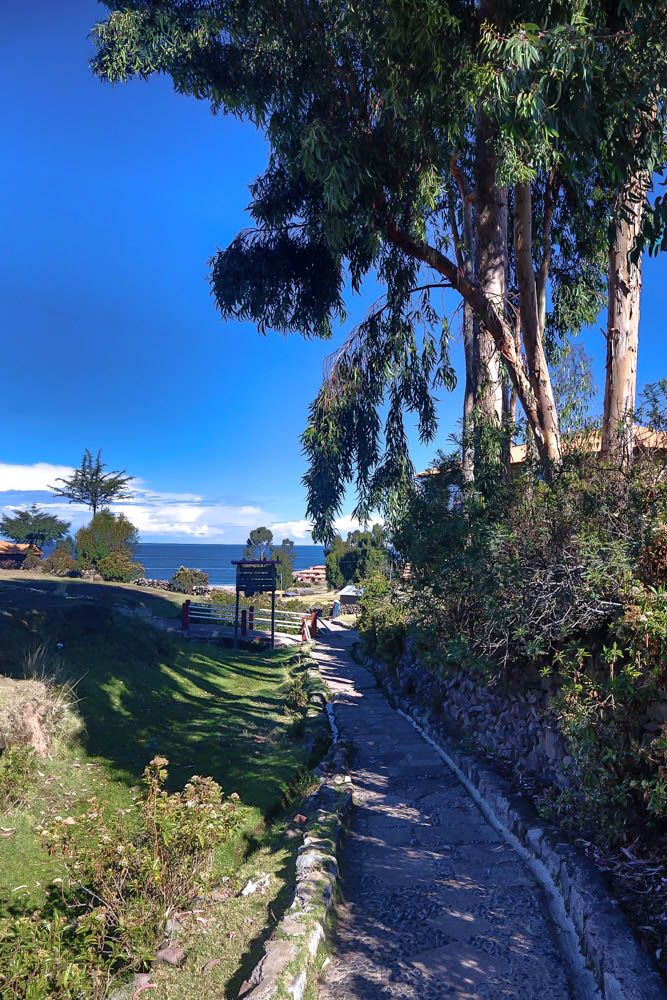
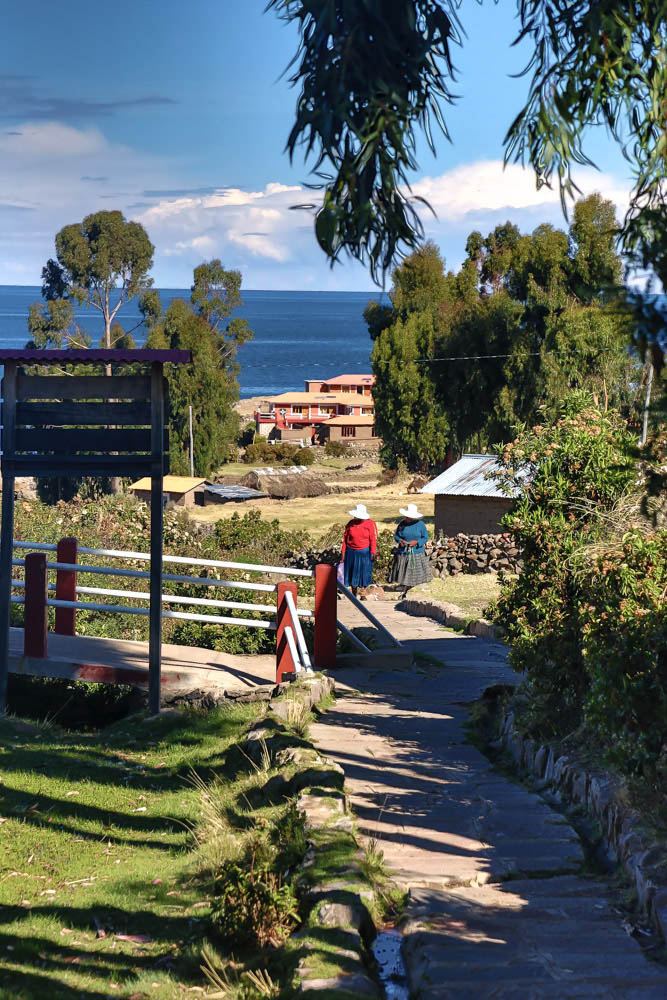
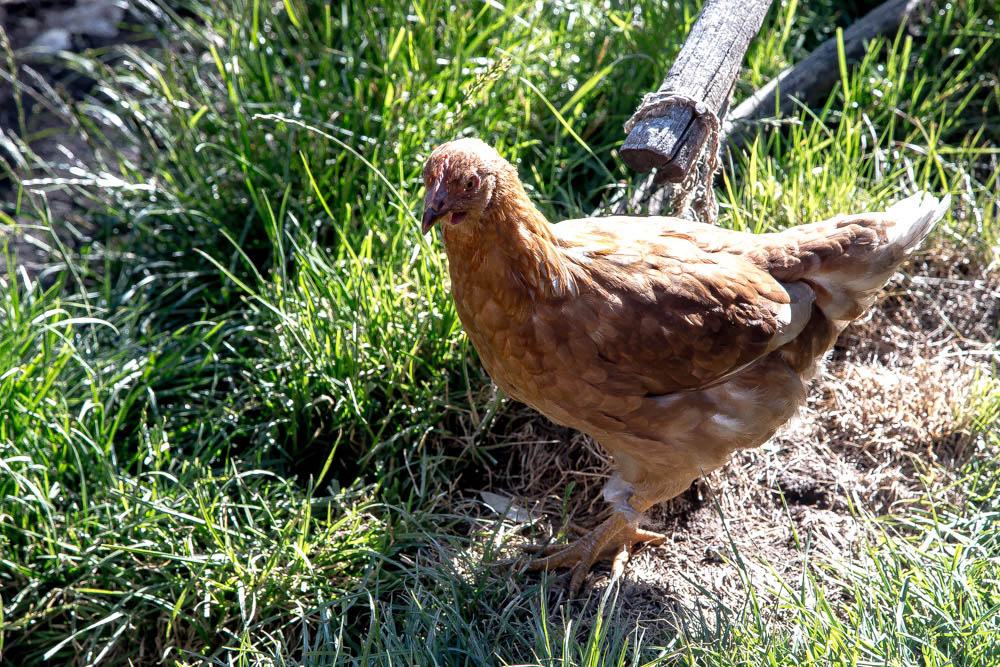
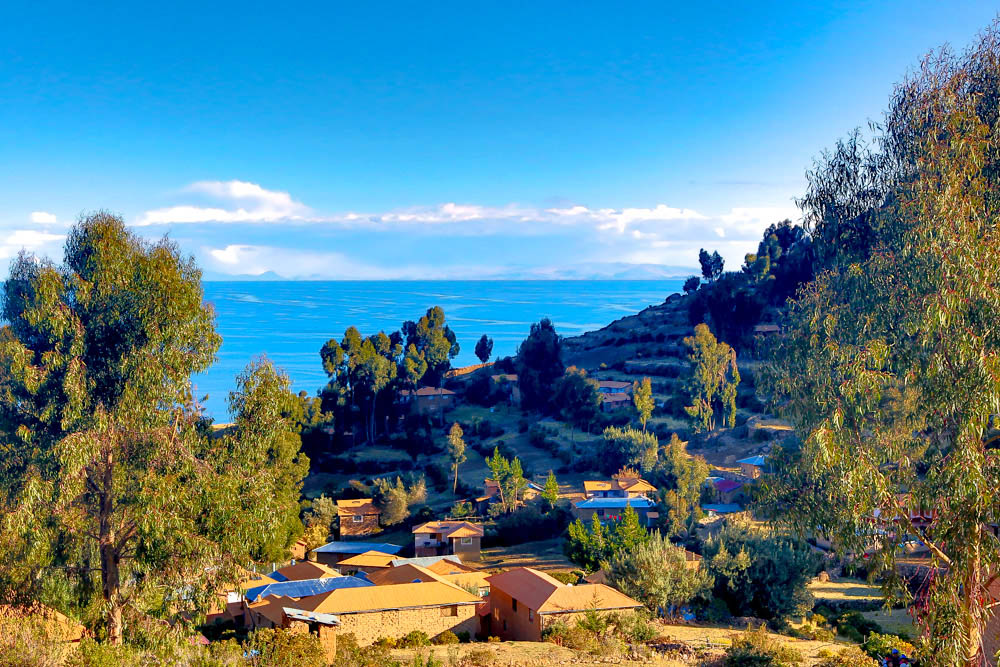 I was still feeling headache-y and nauseous from the altitude, so we took a little rest before dinner. It was like being a little hungover all day long, but the head just felt a bit stuffed up or blocked somehow. We drank more coca, but we didn’t have any altitude sickness tablets, so we just tried to bear through it.
I was still feeling headache-y and nauseous from the altitude, so we took a little rest before dinner. It was like being a little hungover all day long, but the head just felt a bit stuffed up or blocked somehow. We drank more coca, but we didn’t have any altitude sickness tablets, so we just tried to bear through it.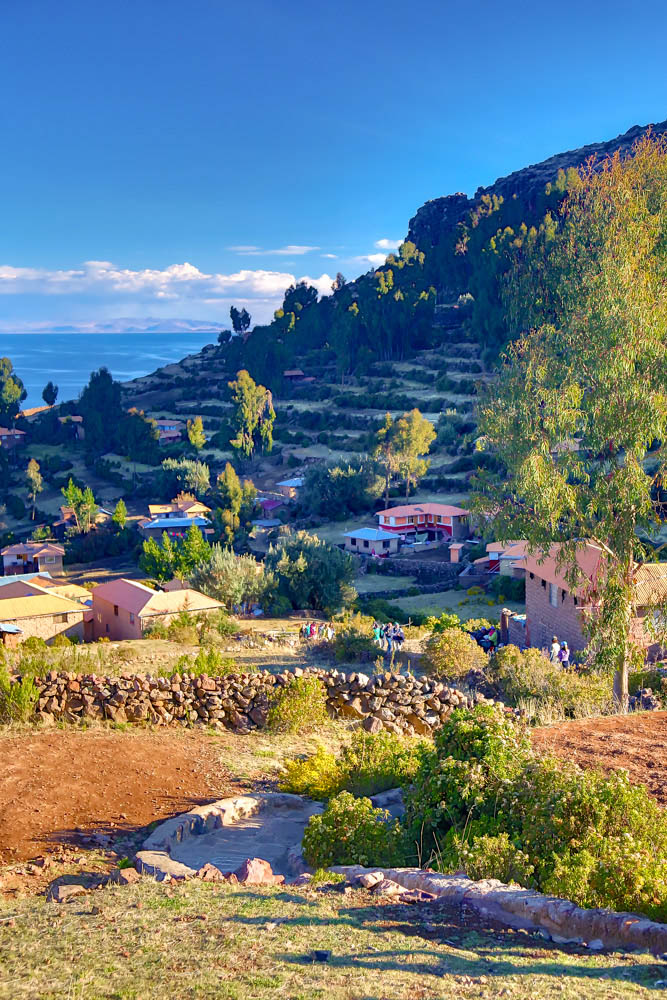 There wasn’t much time to rest before it was dinnertime. I was really interested to poke my head in the cooking area of the kitchen.
There wasn’t much time to rest before it was dinnertime. I was really interested to poke my head in the cooking area of the kitchen.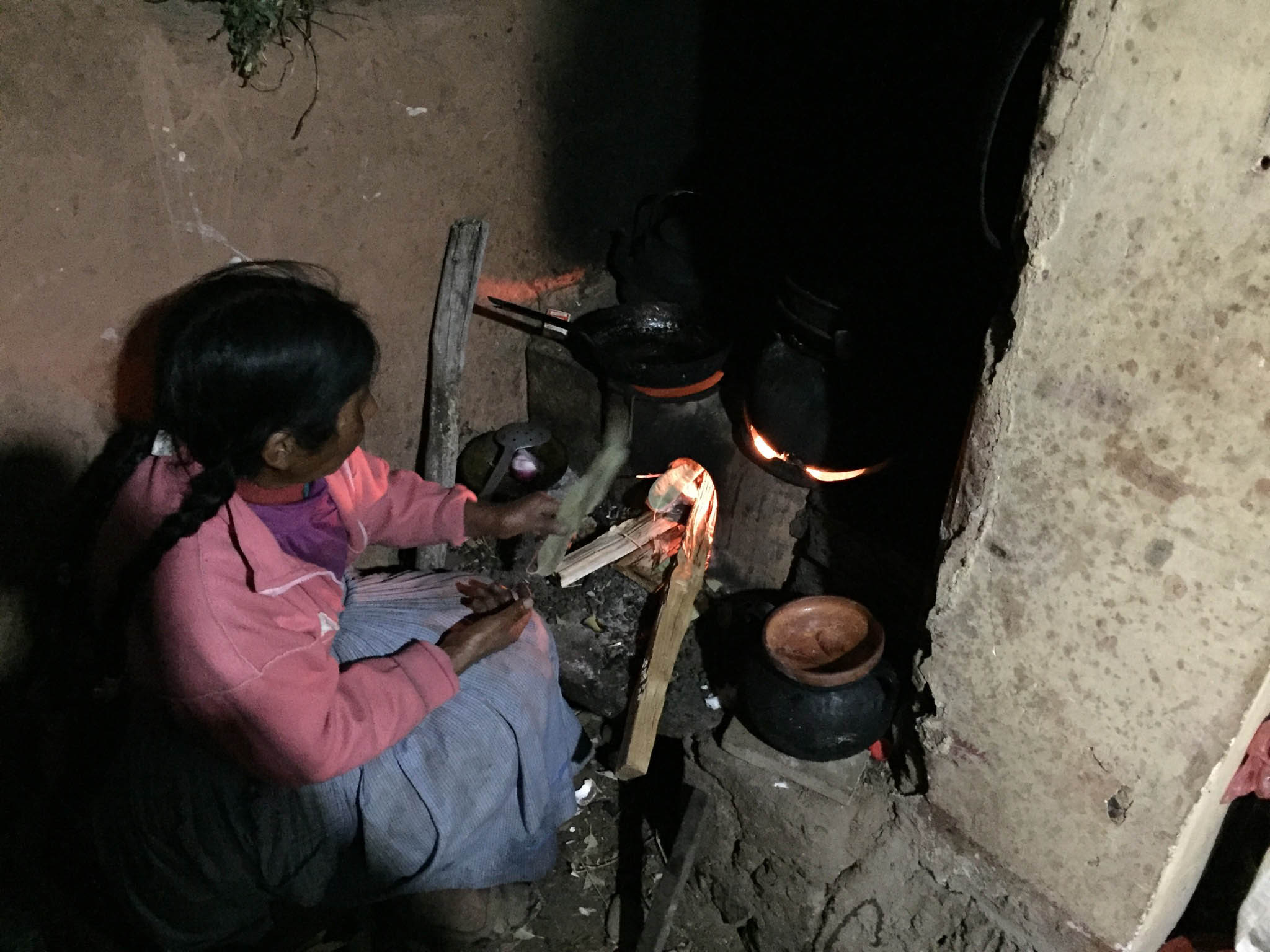 On one side sat a little stove where our mama would stuff things in to burn. We kept seeing her sweep things into the cooking area from the rest of the kitchen like leaves or trash, which she would then put into the stove to keep it fired up. We could tell there is not an extreme amount of education on the island, because our mama had no qualms about putting in pieces of plastic to burn without knowing the ill effects. It burns, right?
On one side sat a little stove where our mama would stuff things in to burn. We kept seeing her sweep things into the cooking area from the rest of the kitchen like leaves or trash, which she would then put into the stove to keep it fired up. We could tell there is not an extreme amount of education on the island, because our mama had no qualms about putting in pieces of plastic to burn without knowing the ill effects. It burns, right?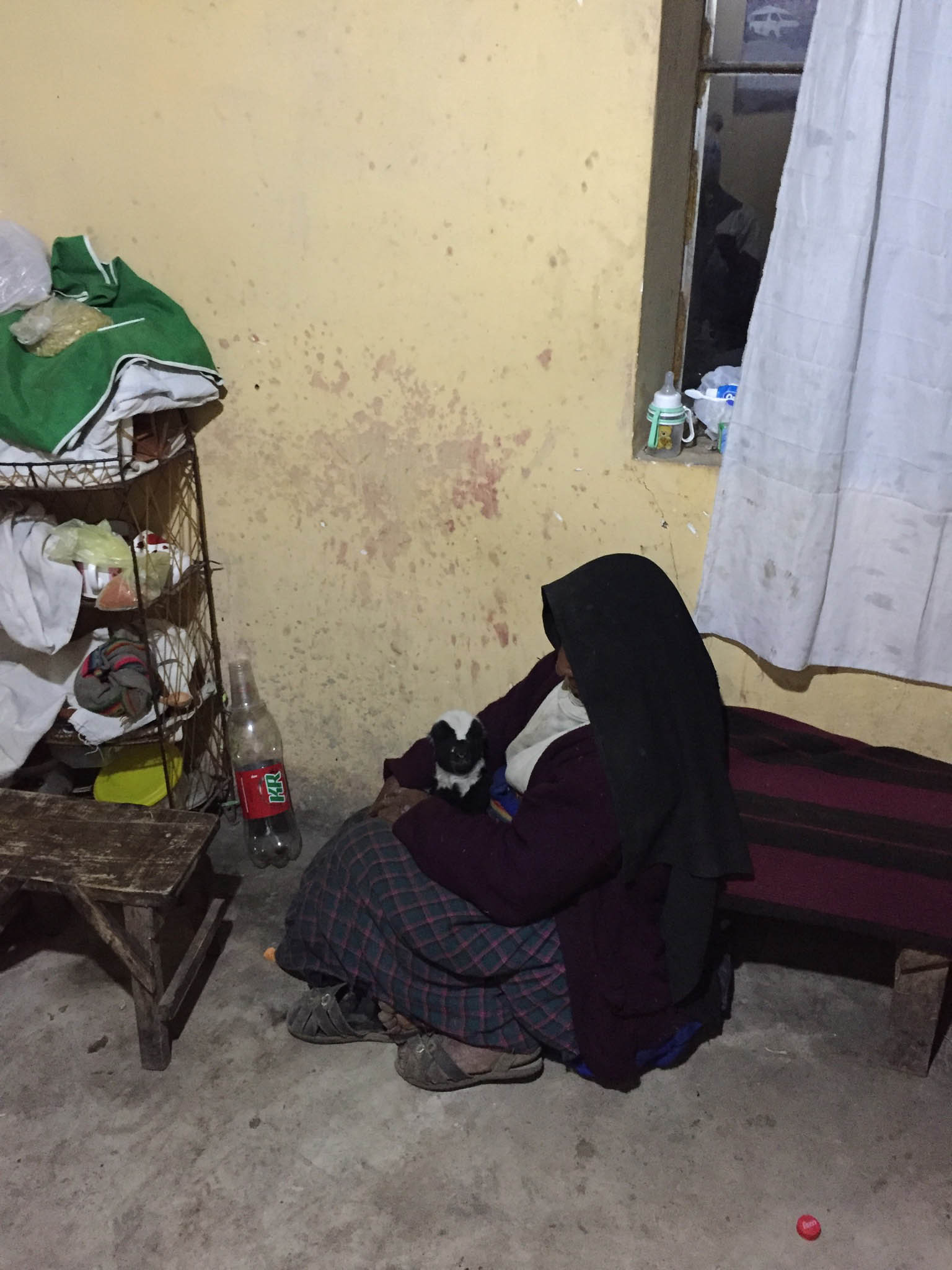 You guys, this baby alpaca was the CUTEST THING EVER. He was so still and docile, he would just stand next to the stove and look at the fire. I wanted to eat him up. (And not in the way that I ate up other alpacas on this trip…)
You guys, this baby alpaca was the CUTEST THING EVER. He was so still and docile, he would just stand next to the stove and look at the fire. I wanted to eat him up. (And not in the way that I ate up other alpacas on this trip…)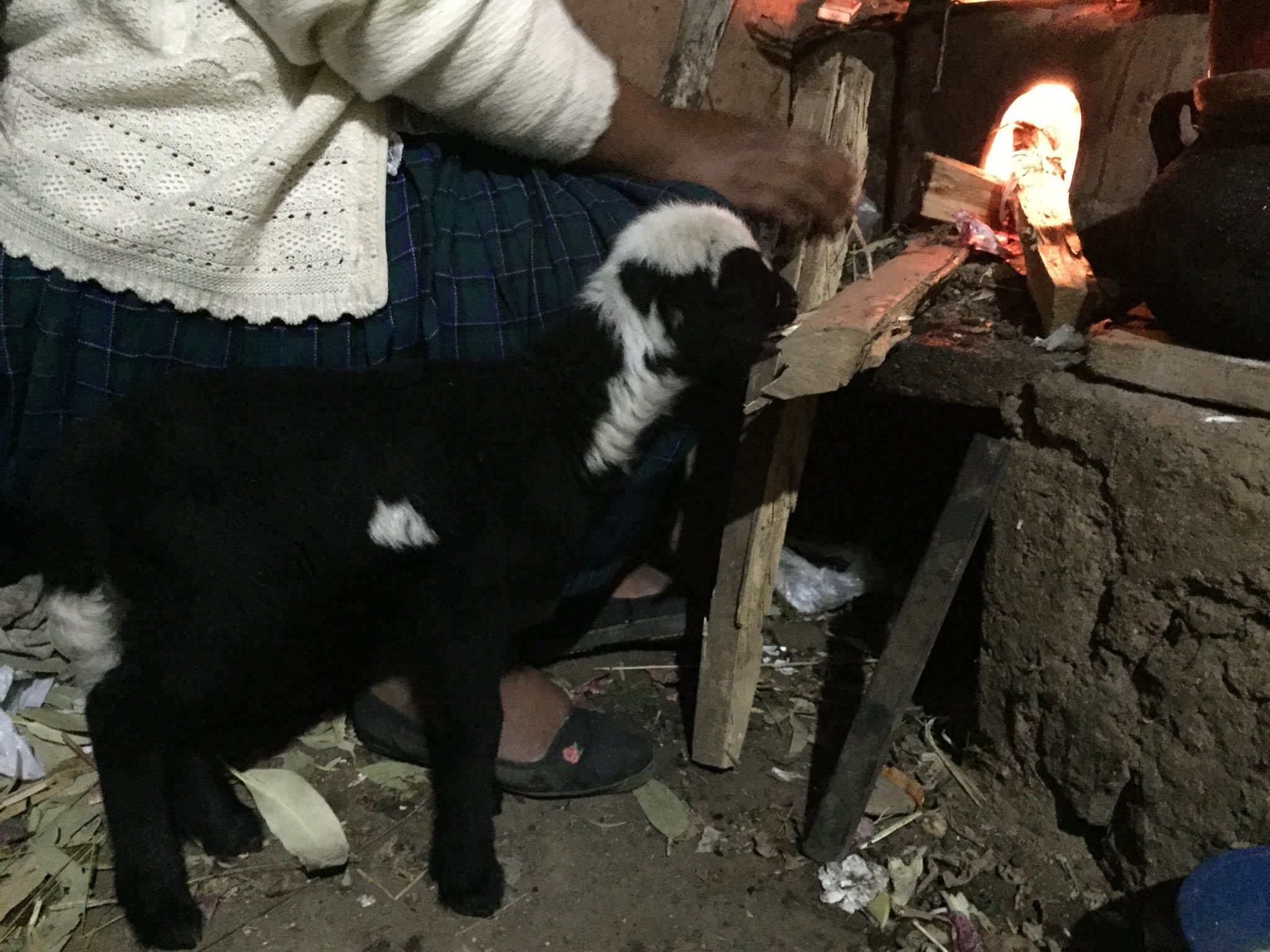 Here you can see a bit more of how our mama’s daughter could heat the skillet up from below. I thought it was so impressive how wonderful these women could cook with such rudimentary means.
Here you can see a bit more of how our mama’s daughter could heat the skillet up from below. I thought it was so impressive how wonderful these women could cook with such rudimentary means.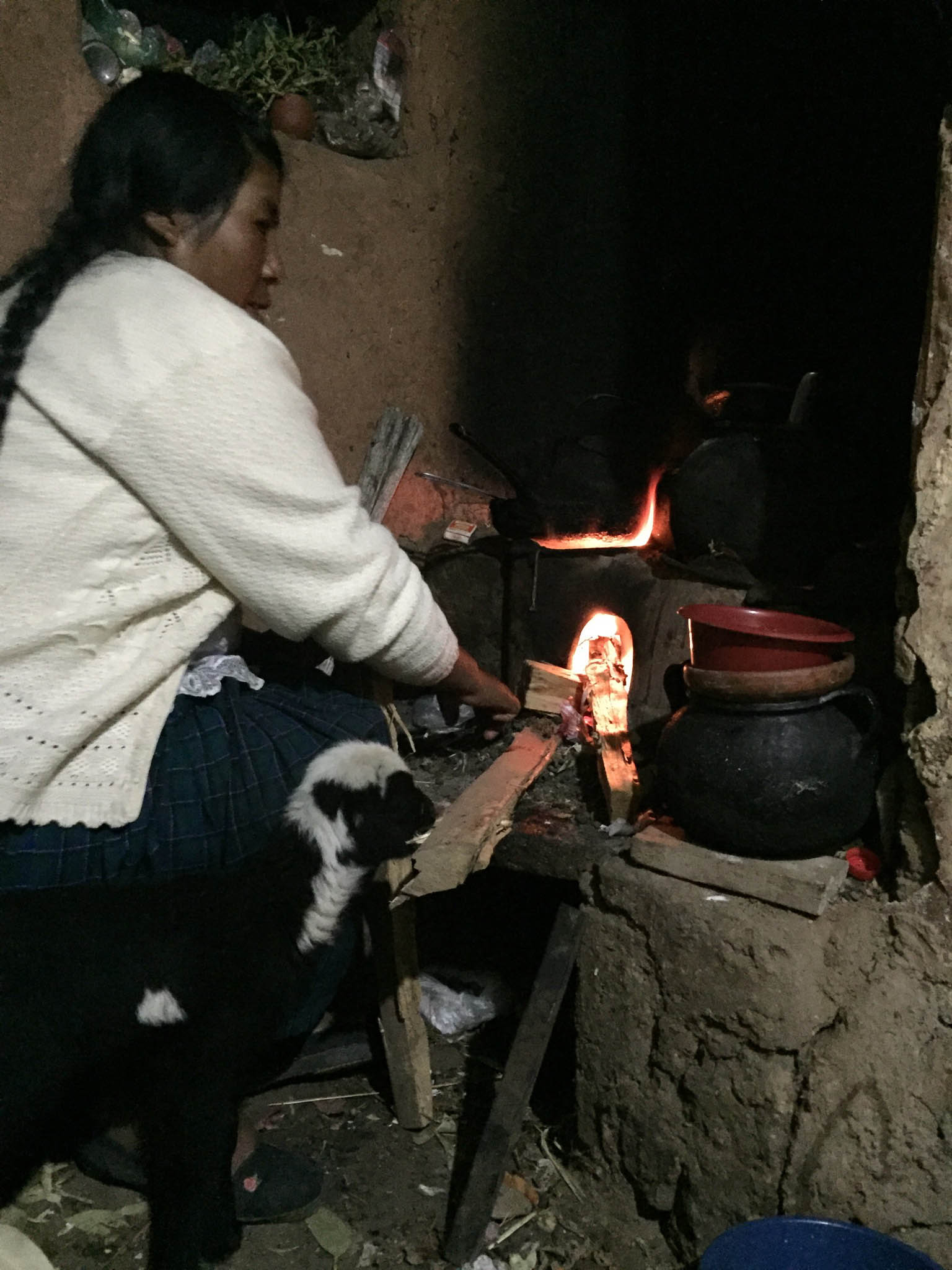 Meanwhile, mama started feeding the baby alpaca. Cue the squeals from all the cute.
Meanwhile, mama started feeding the baby alpaca. Cue the squeals from all the cute.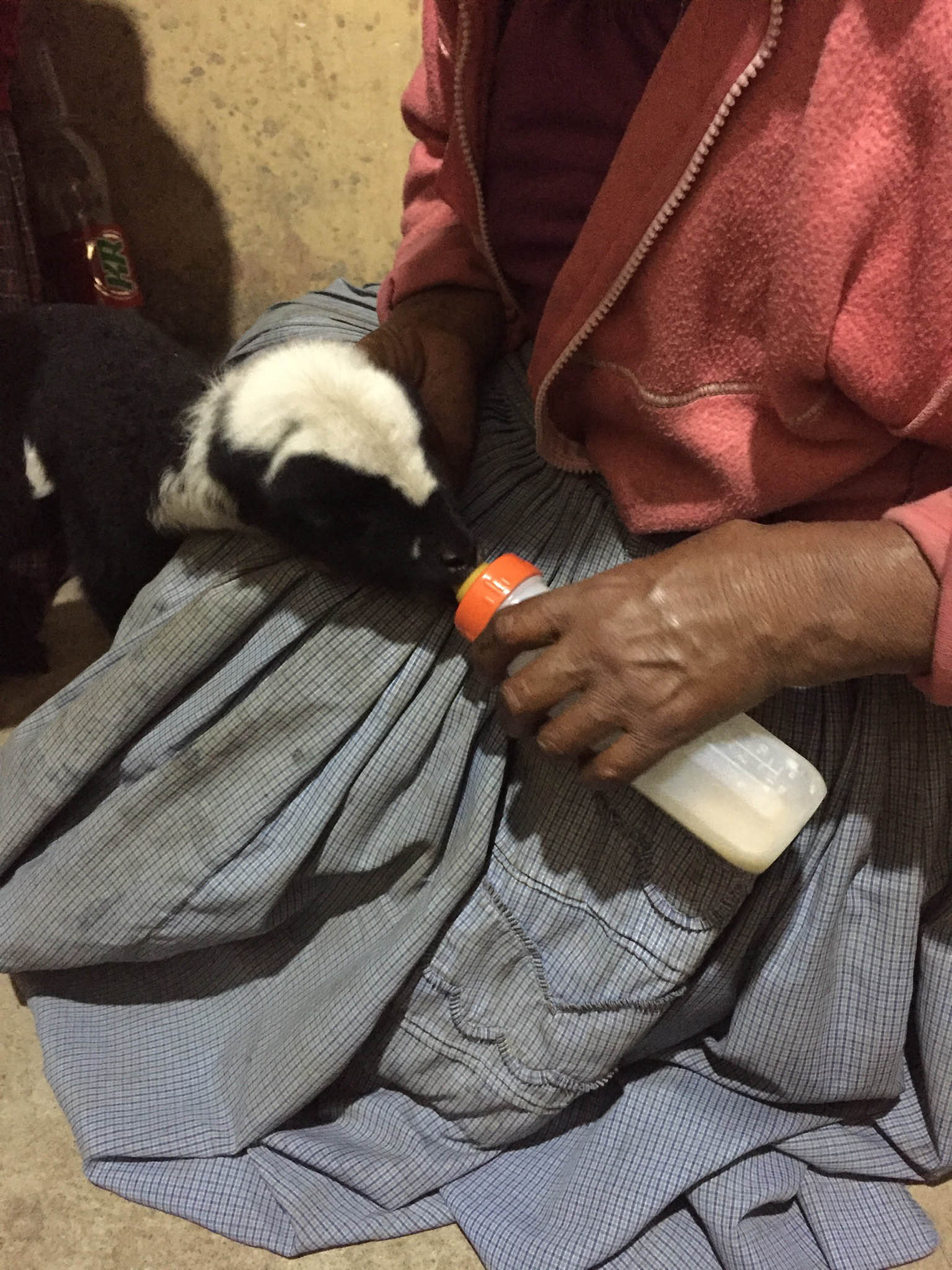 If you aren’t in love with this baby alpaca by now, I can’t help you.
If you aren’t in love with this baby alpaca by now, I can’t help you.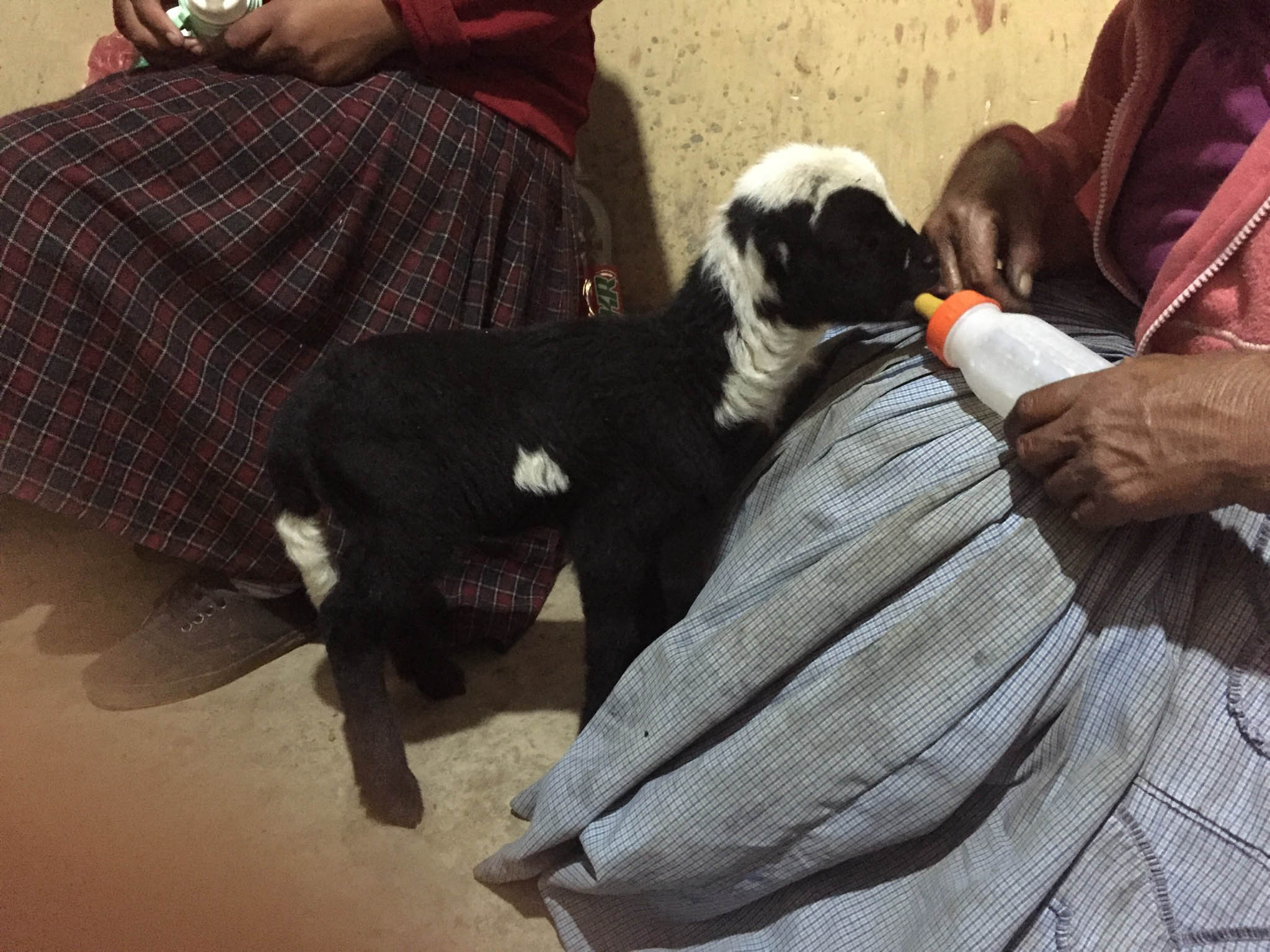 After dinner we met our guide again and started a hike up to the peak of the island, to an altitude of 4200m to complete the same pilgrimage that the locals make once a year, including a small ceremony to walk around the peak’s prayer area three times for good luck.
After dinner we met our guide again and started a hike up to the peak of the island, to an altitude of 4200m to complete the same pilgrimage that the locals make once a year, including a small ceremony to walk around the peak’s prayer area three times for good luck.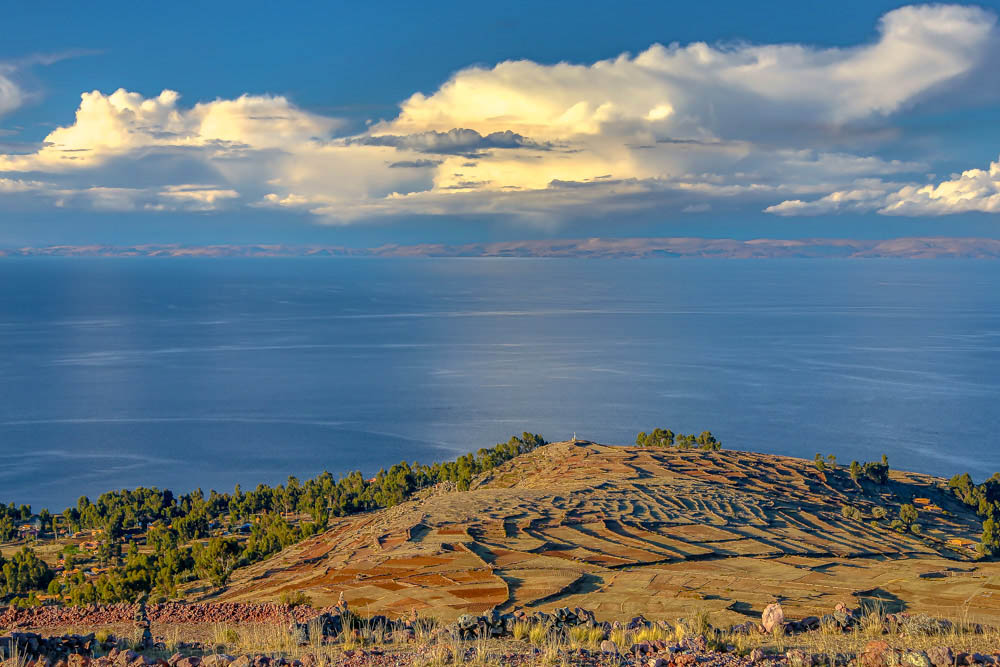 From there, we waited for the sun to set over a magnificent landscape.
From there, we waited for the sun to set over a magnificent landscape.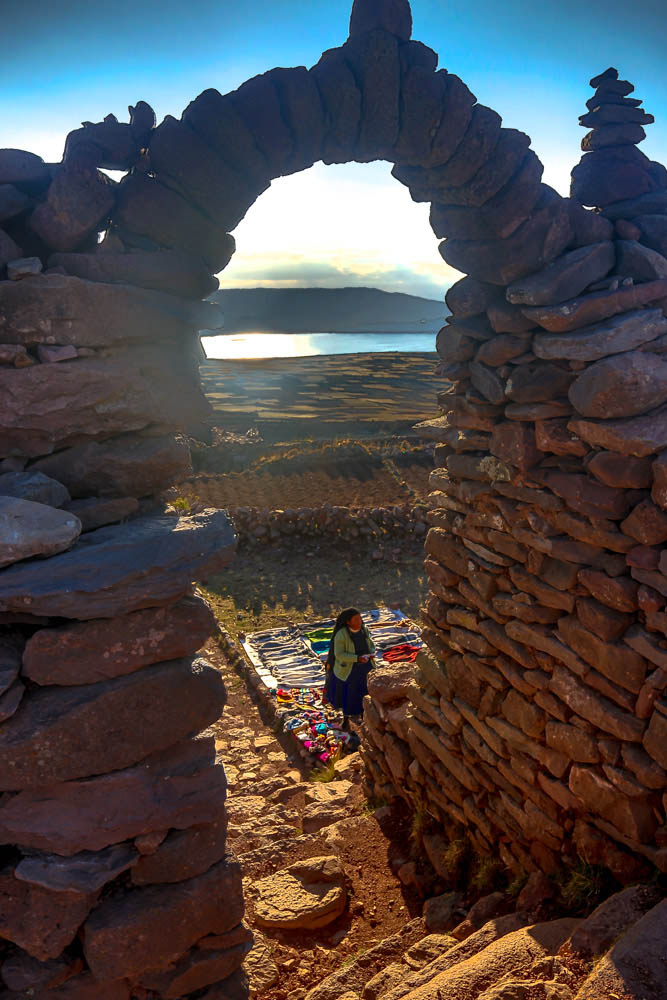 The locals on the island were of course selling their wares, which Kay supported by buying a scarf. I had already bought a hat from my mama’s family earlier in the day, so I declined more purchases. It was a little awkward being put in the buying position, but the cost was so little to us and would help the locals out, so we played into the scheme.
The locals on the island were of course selling their wares, which Kay supported by buying a scarf. I had already bought a hat from my mama’s family earlier in the day, so I declined more purchases. It was a little awkward being put in the buying position, but the cost was so little to us and would help the locals out, so we played into the scheme.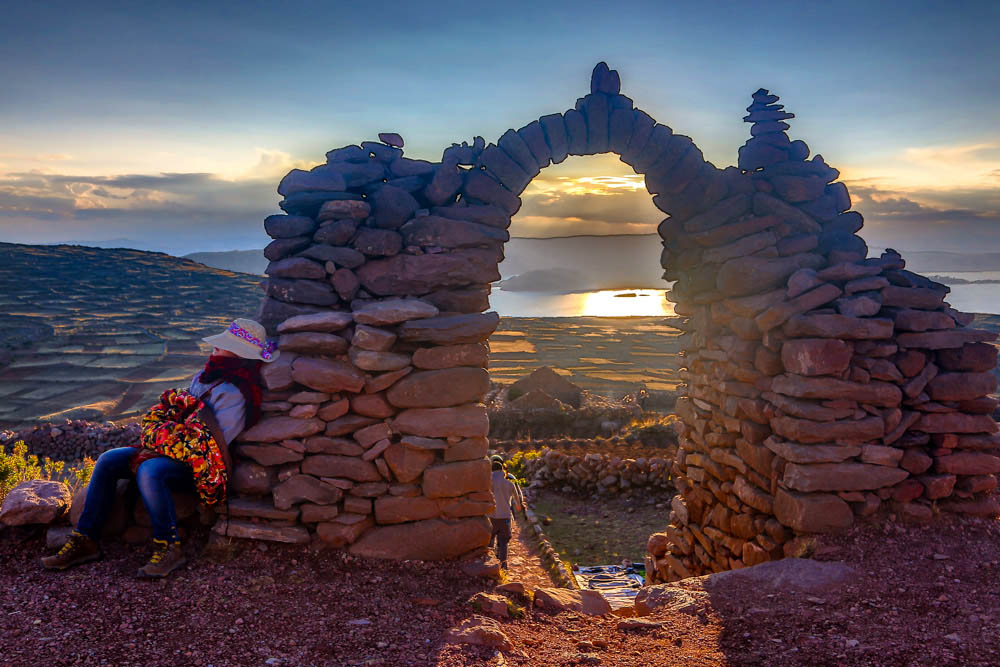

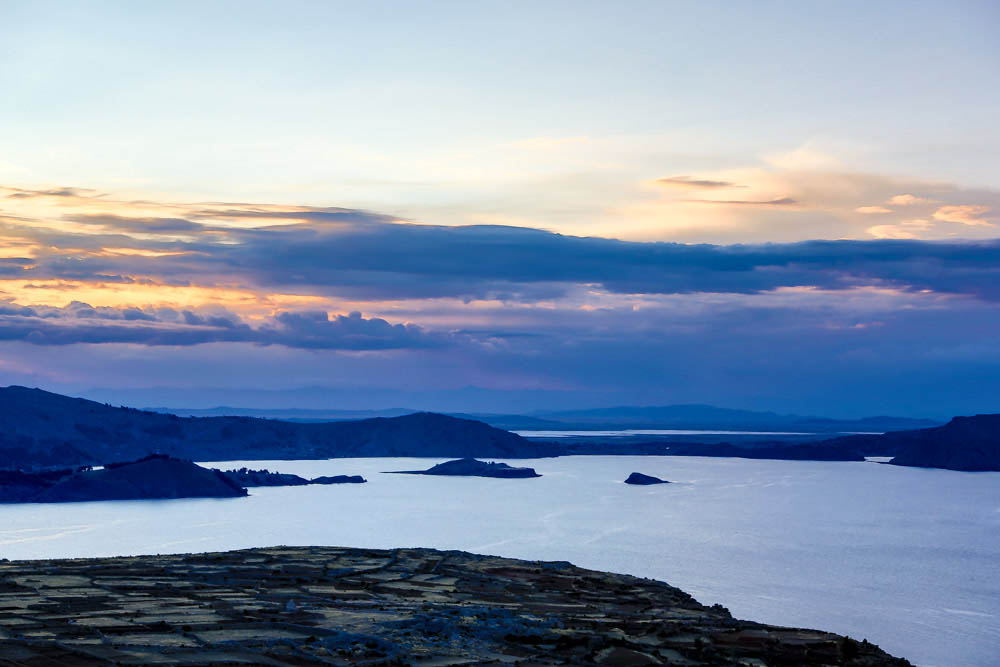 Others bought items as well, and the path was lined with locals wanting to sell their hand woven wares. At least you knew on this island, that the goods were more or less really made by hand and not machine-knit like the goods in the Puno markets. Although we were so chilled in our place in Puno that we’d ended up buying some sweaters there anyway.
Others bought items as well, and the path was lined with locals wanting to sell their hand woven wares. At least you knew on this island, that the goods were more or less really made by hand and not machine-knit like the goods in the Puno markets. Although we were so chilled in our place in Puno that we’d ended up buying some sweaters there anyway.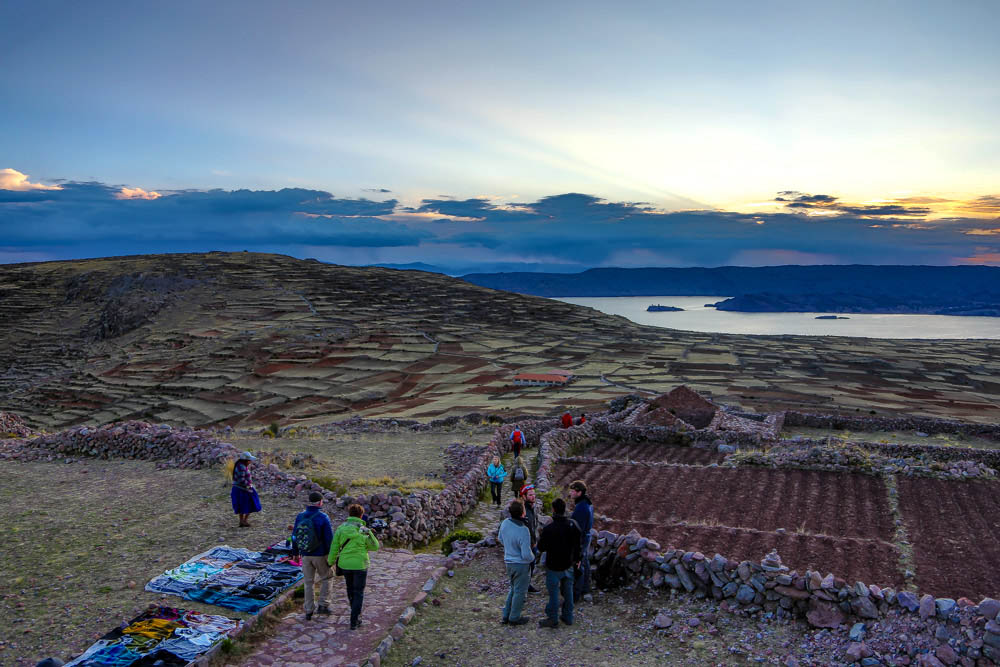 As the sun set, the temperature quickly started dropping back to freezing. Brrr. We ran the gamut from sweating up the hill to shivering at the top and sweating on the way back down.
As the sun set, the temperature quickly started dropping back to freezing. Brrr. We ran the gamut from sweating up the hill to shivering at the top and sweating on the way back down.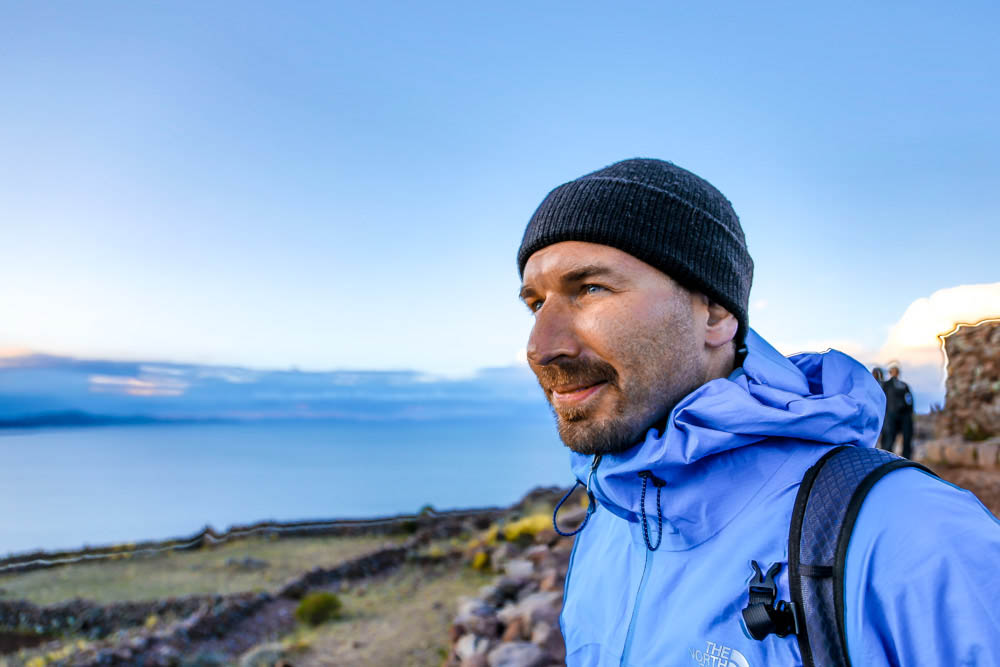

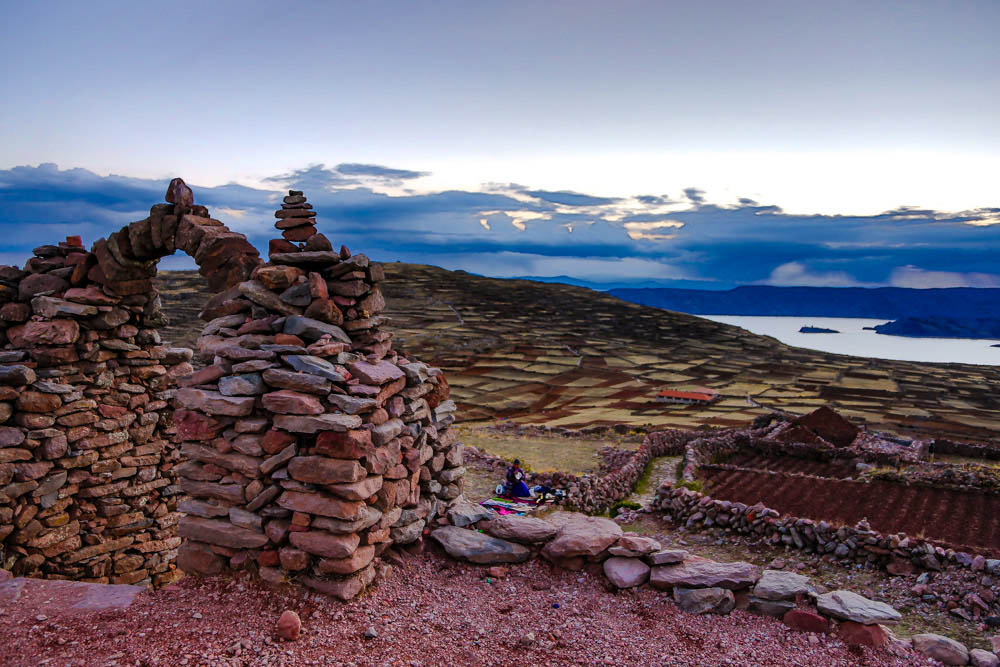 Although it took a lot for the heart to climb up, the view was definitely worth it.
Although it took a lot for the heart to climb up, the view was definitely worth it. Here I am in my new hat. Kay thinks it’s weird and knobby, but I think it’s unique and has character. 🙂
Here I am in my new hat. Kay thinks it’s weird and knobby, but I think it’s unique and has character. 🙂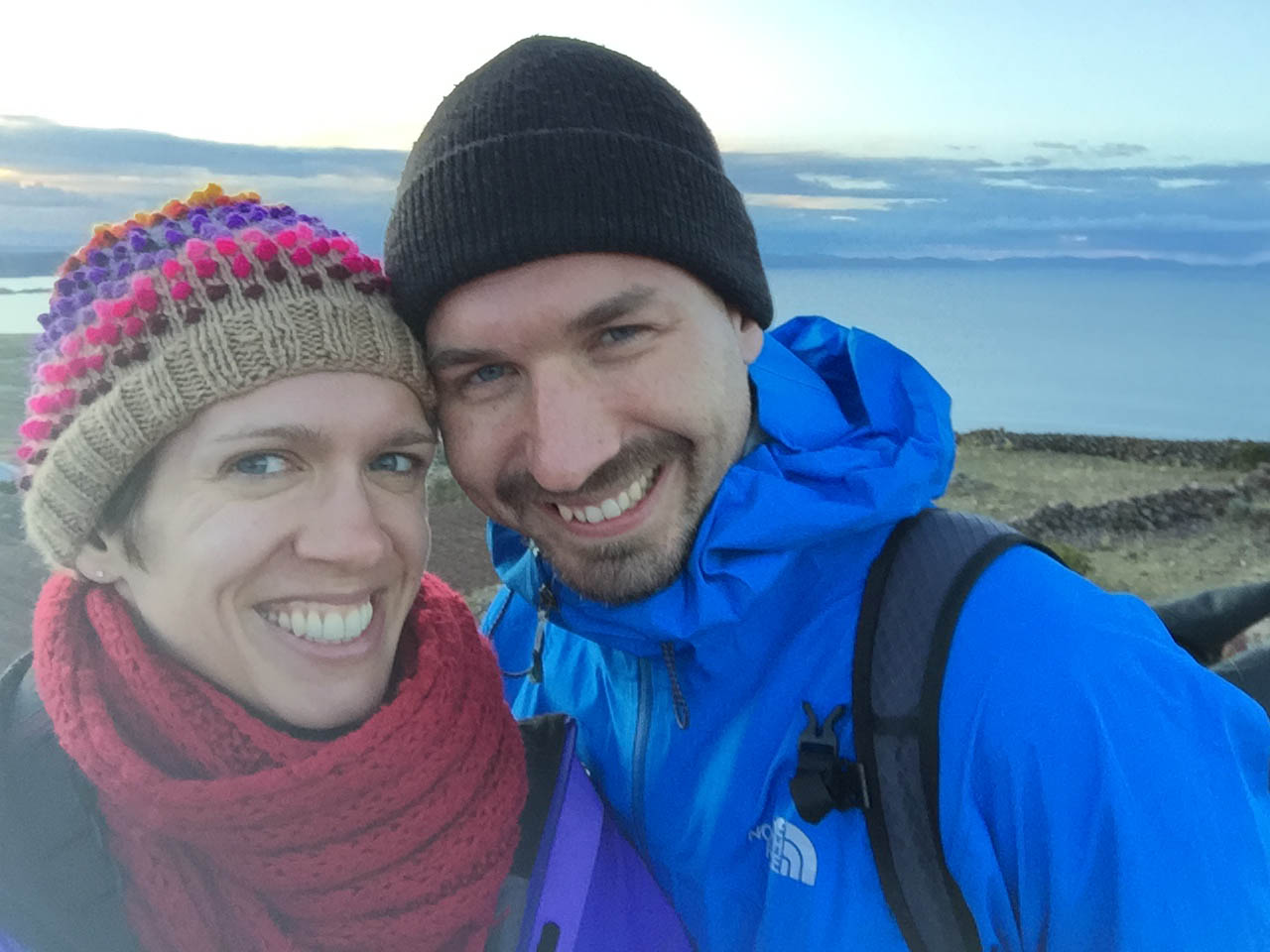 Back down in the town, our papa picked us up and we headed back to the house in the dark, with our headlamps on and our papa using a hand-generated flashlight. The locals have a little electricity in the homes with solar panels giving light, but that’s about it. We thought it was great that he can use the hand-cranked flashlight.
Back down in the town, our papa picked us up and we headed back to the house in the dark, with our headlamps on and our papa using a hand-generated flashlight. The locals have a little electricity in the homes with solar panels giving light, but that’s about it. We thought it was great that he can use the hand-cranked flashlight.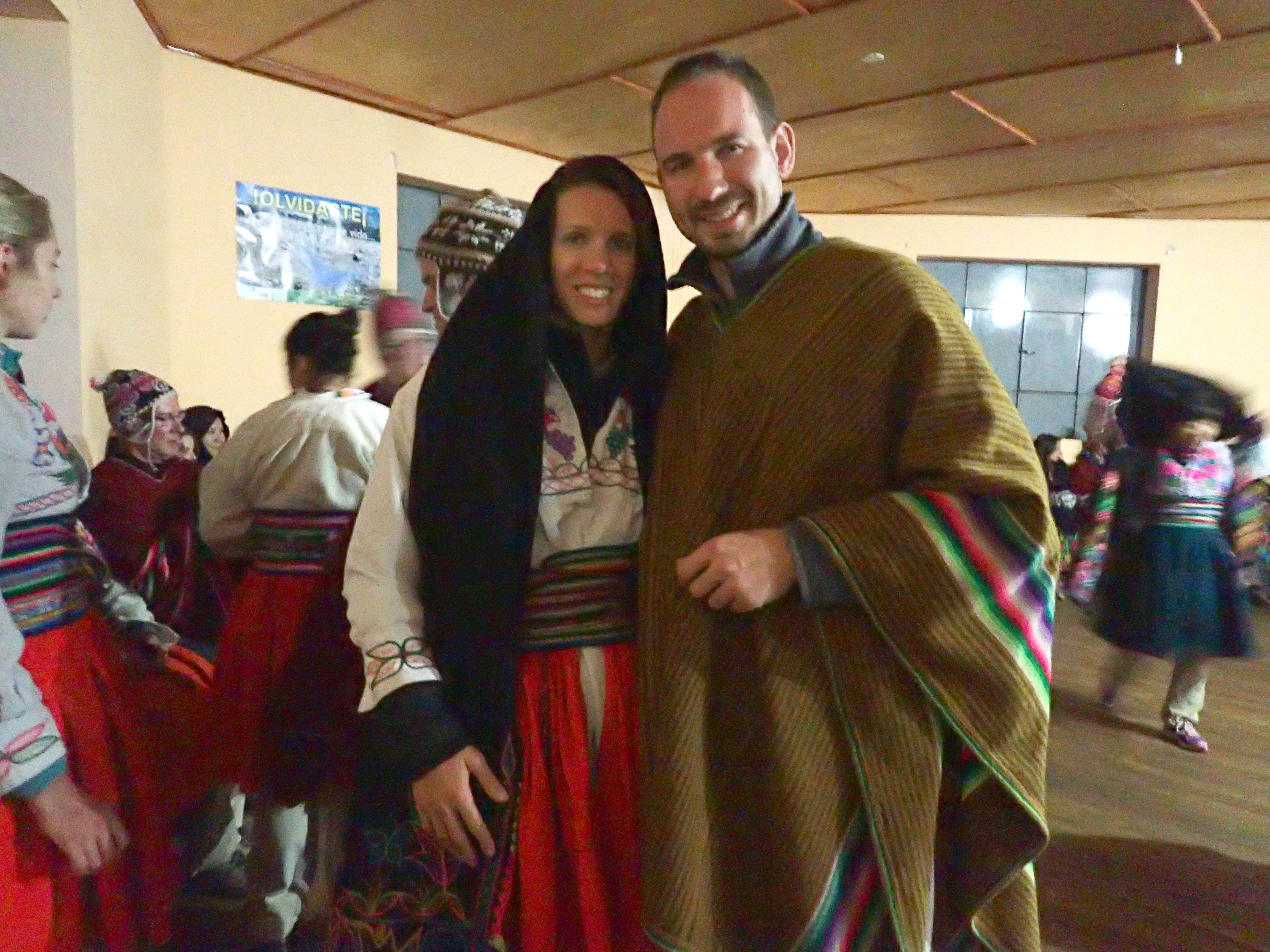 While I felt a little insecure dressing up in a culture that I didn’t really understand, our mama and papa seemed happy to invite us into their family for an evening of dancing. The whole stay seemed like they genuinely enjoy showing their lifestyle to foreigners, and make some extra money off of it as well.
While I felt a little insecure dressing up in a culture that I didn’t really understand, our mama and papa seemed happy to invite us into their family for an evening of dancing. The whole stay seemed like they genuinely enjoy showing their lifestyle to foreigners, and make some extra money off of it as well.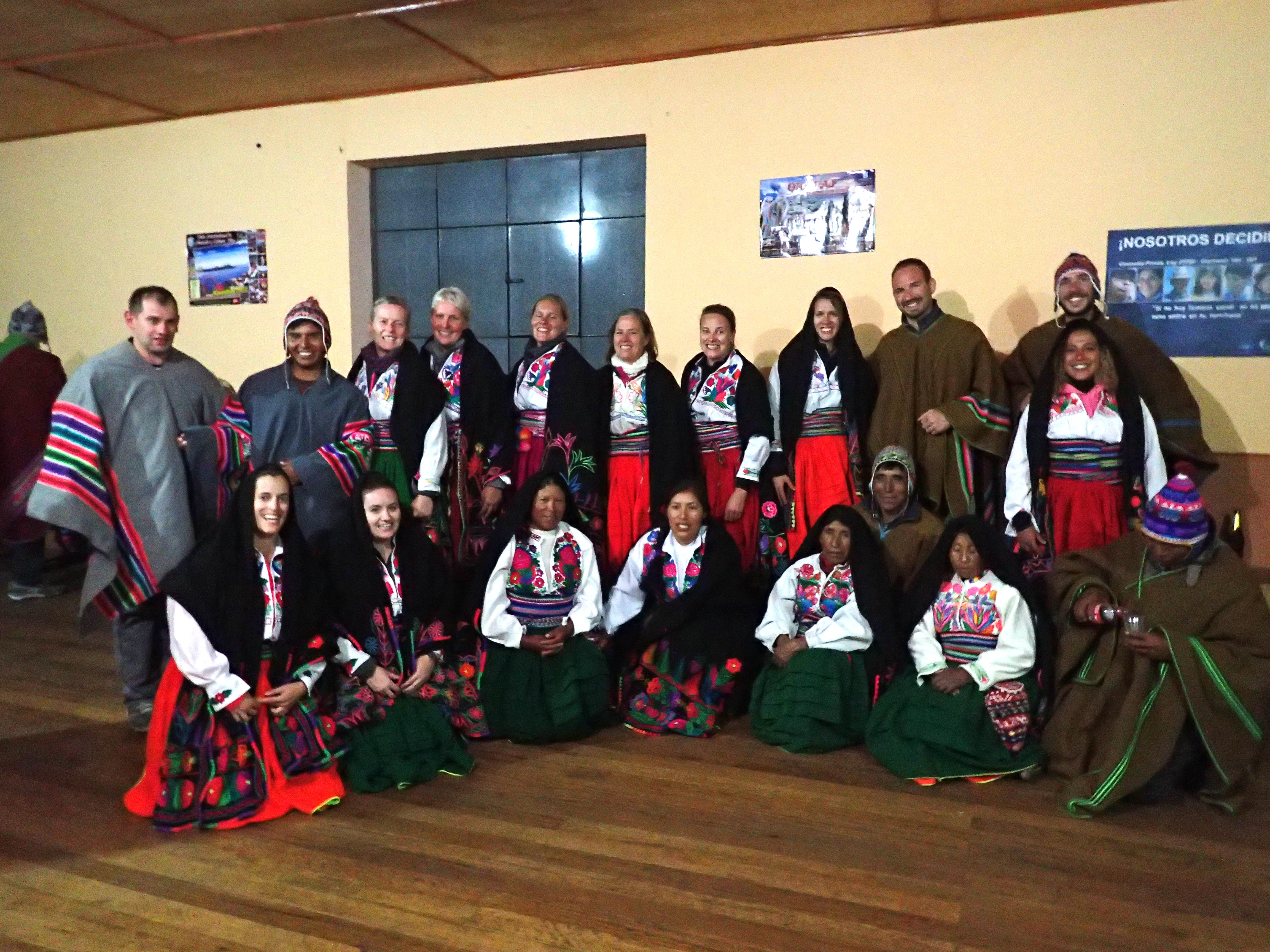 Shortly after the photo, we went home earlier than the others because Kay still had a pretty bad headache from the altitude. I also wasn’t feeling great in the head.
Shortly after the photo, we went home earlier than the others because Kay still had a pretty bad headache from the altitude. I also wasn’t feeling great in the head. I’ve never seen this much hail left outside after a storm, but it hailed for an hour at least until turning back to rain for several hours during the night. Thankfully in the morning it had finished so that we didn’t need to pack up in the rain. Also, the tin roof was expertly made so that none of our belongings got wet. I was very impressed by the craftsmanship.
I’ve never seen this much hail left outside after a storm, but it hailed for an hour at least until turning back to rain for several hours during the night. Thankfully in the morning it had finished so that we didn’t need to pack up in the rain. Also, the tin roof was expertly made so that none of our belongings got wet. I was very impressed by the craftsmanship.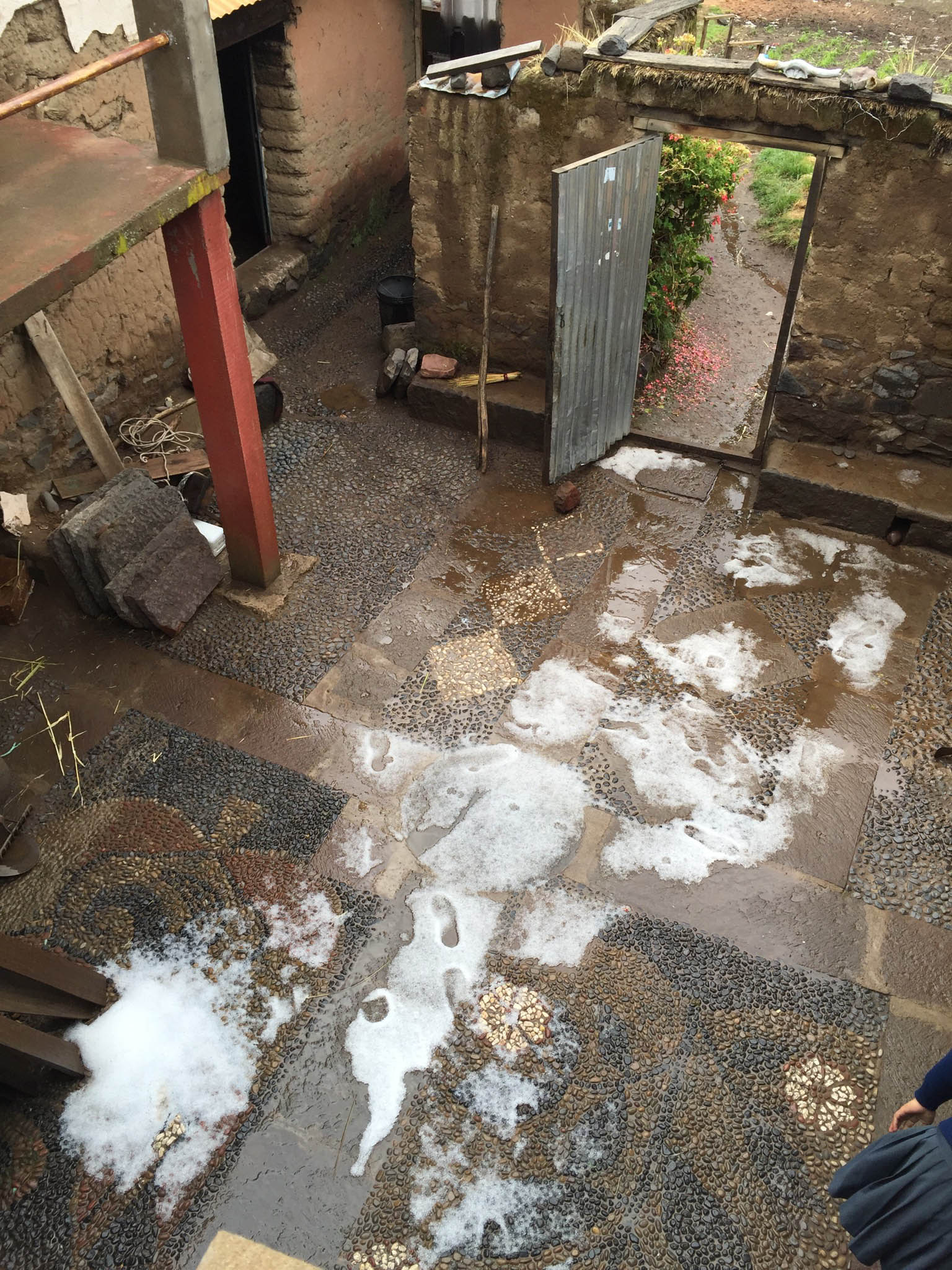 Kay’s head felt better the next morning, but I felt a little awful. I think I was having a combination of altitude sickness and caffeine withdrawal or a neck/shoulder issue, because I felt horrible until I had some Coca Cola later that day on Taquile Island. More on that next.
Kay’s head felt better the next morning, but I felt a little awful. I think I was having a combination of altitude sickness and caffeine withdrawal or a neck/shoulder issue, because I felt horrible until I had some Coca Cola later that day on Taquile Island. More on that next.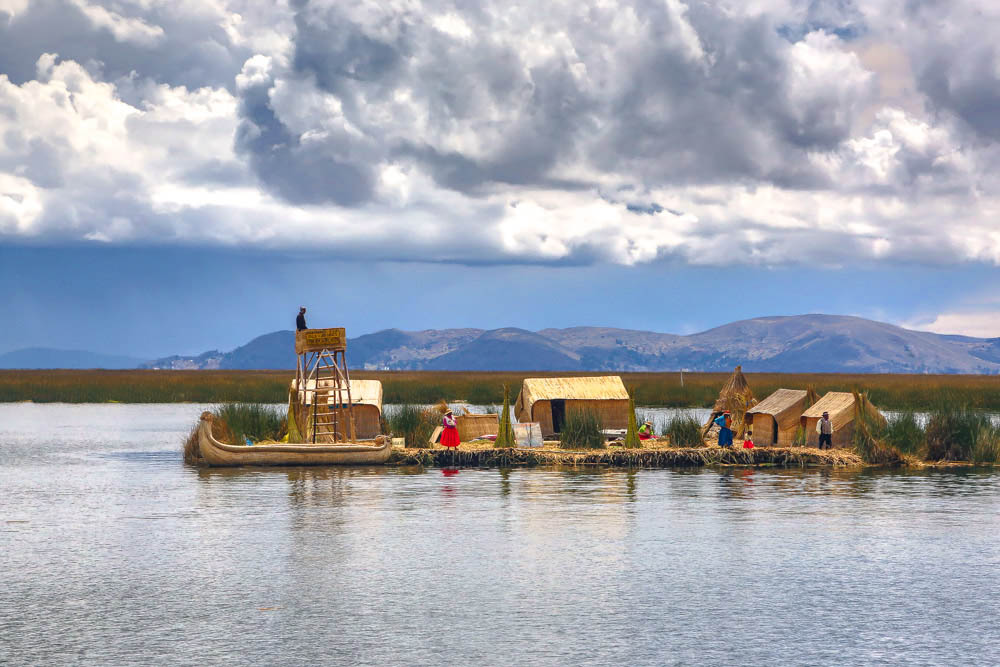 The islands are basically made with plant material including reeds from the area, which are also a major food source for the Uros.
The islands are basically made with plant material including reeds from the area, which are also a major food source for the Uros.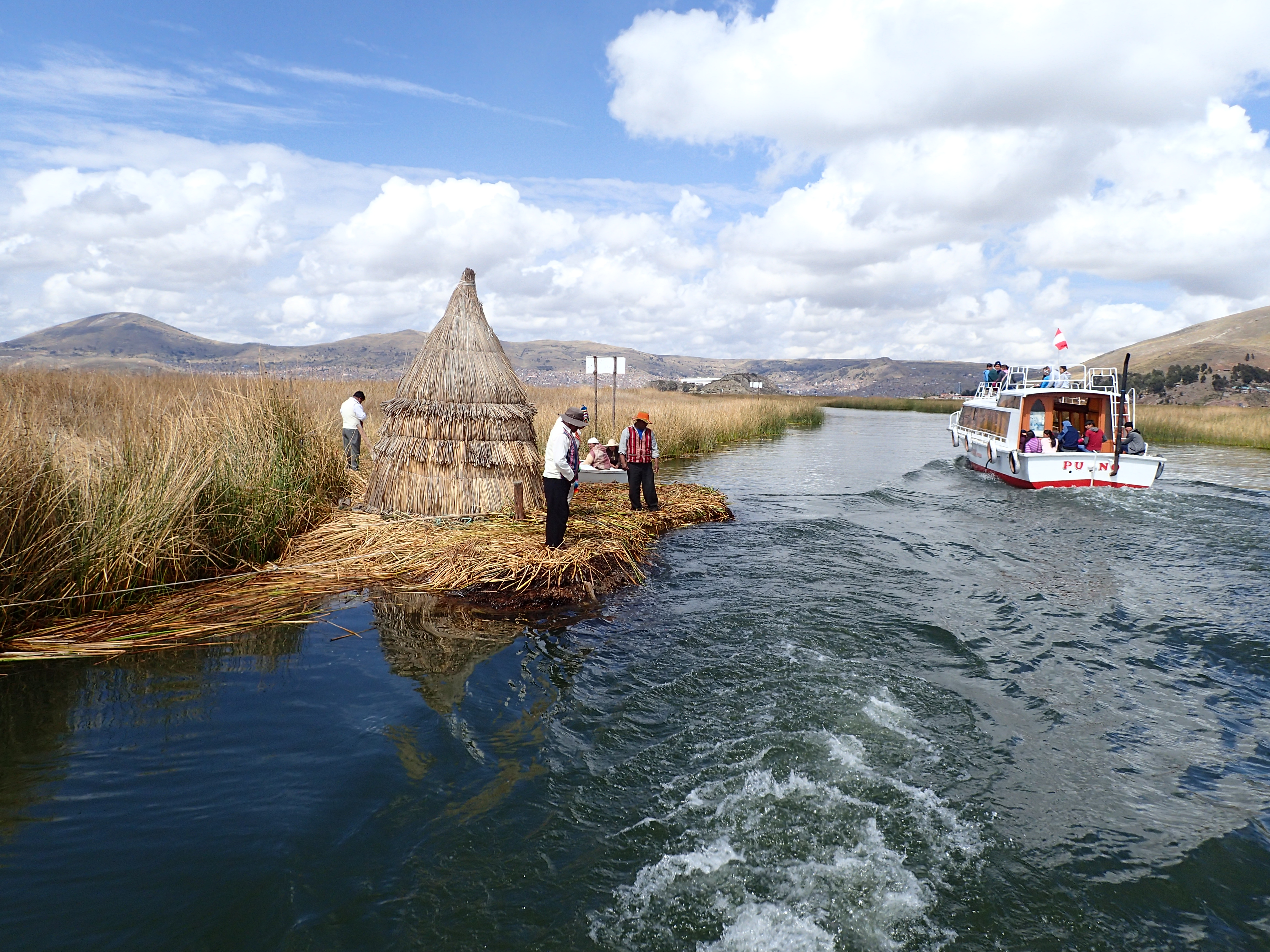 The islands were really impressive and we got to get out of the boat and walk around on a few of them.
The islands were really impressive and we got to get out of the boat and walk around on a few of them. The clothing of the locals on the island was very distinct. We were surprised that in the cold weather (we had hats and jackets) the locals were still bare foot, but they had several layers under their skirts.
The clothing of the locals on the island was very distinct. We were surprised that in the cold weather (we had hats and jackets) the locals were still bare foot, but they had several layers under their skirts.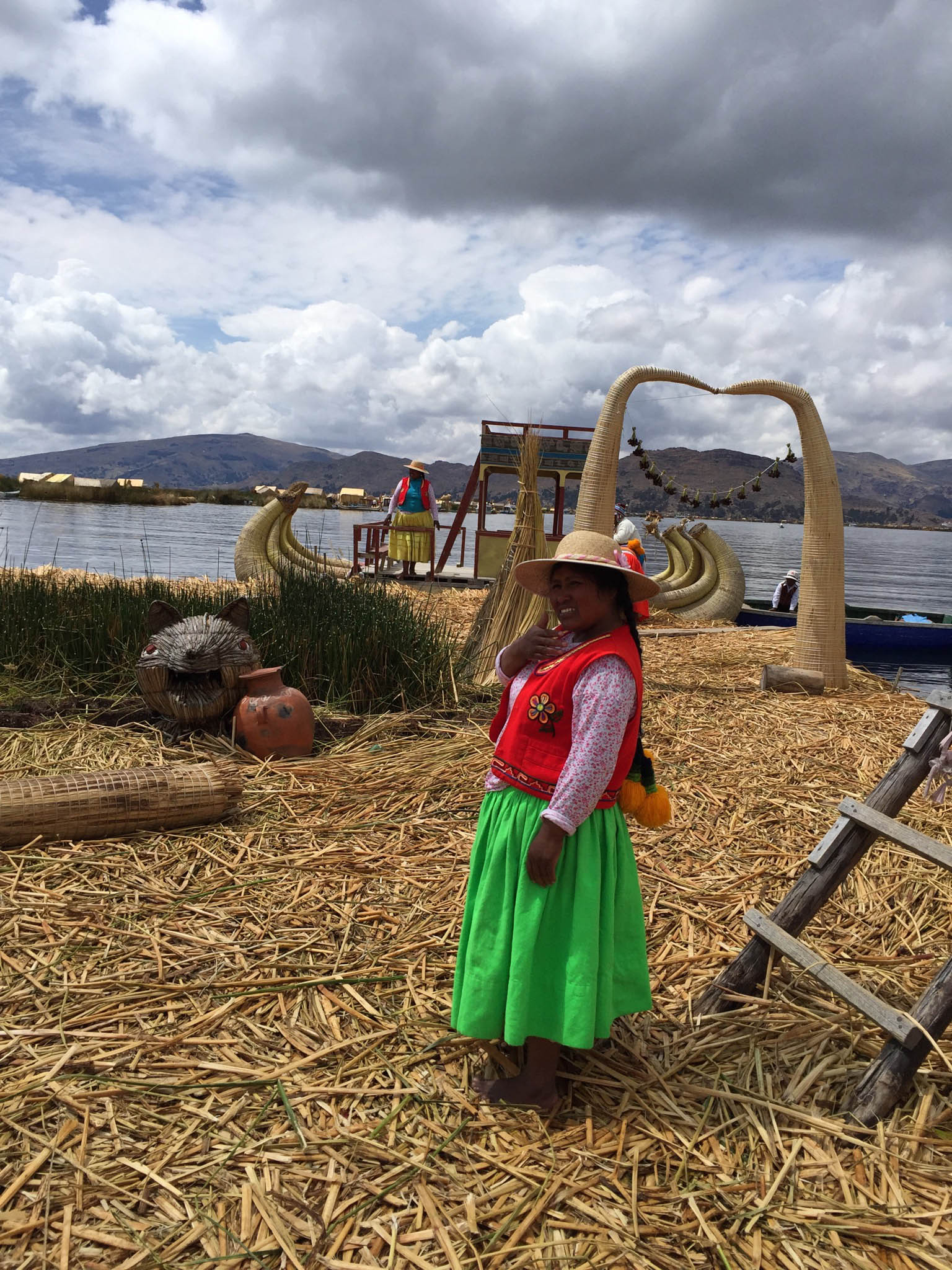 Still, the people in the region are much more used to both the altitude and the temperatures being outside all the time.
Still, the people in the region are much more used to both the altitude and the temperatures being outside all the time.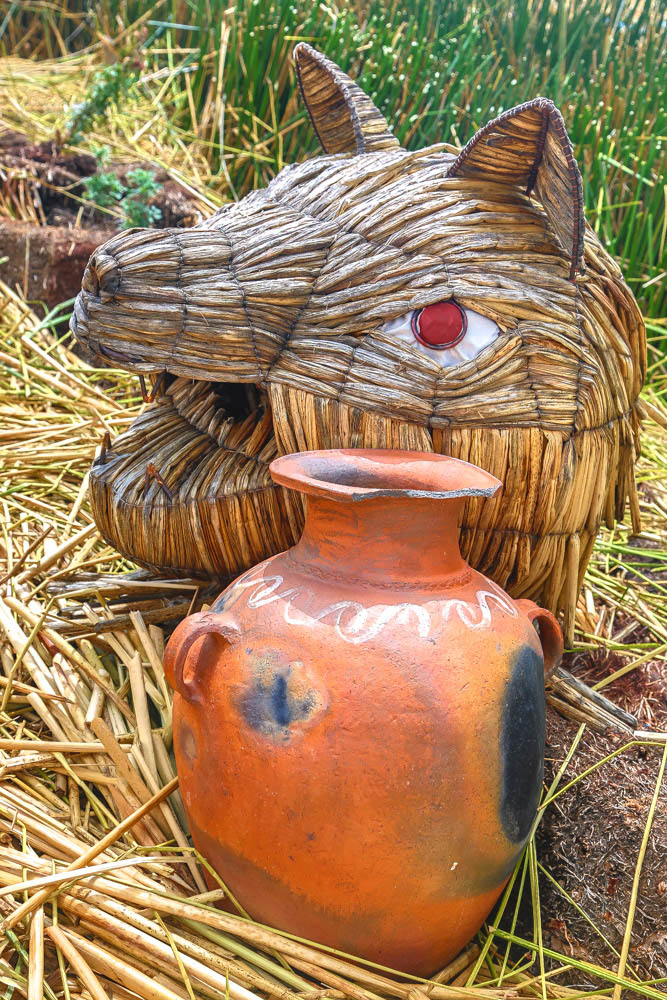
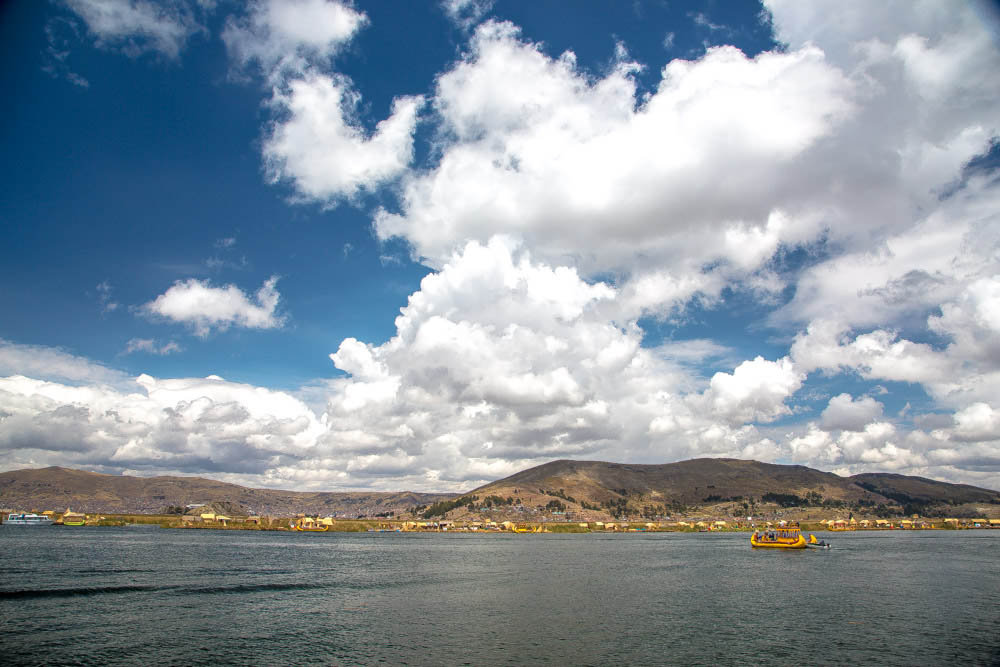 On the “big island” with the school, we stopped for some coca tea, made from the same plant which is used to produce cocaine. We had already been experiencing some altitude sickness in Puno and coca is supposed to help against it, which we found to be true.
On the “big island” with the school, we stopped for some coca tea, made from the same plant which is used to produce cocaine. We had already been experiencing some altitude sickness in Puno and coca is supposed to help against it, which we found to be true.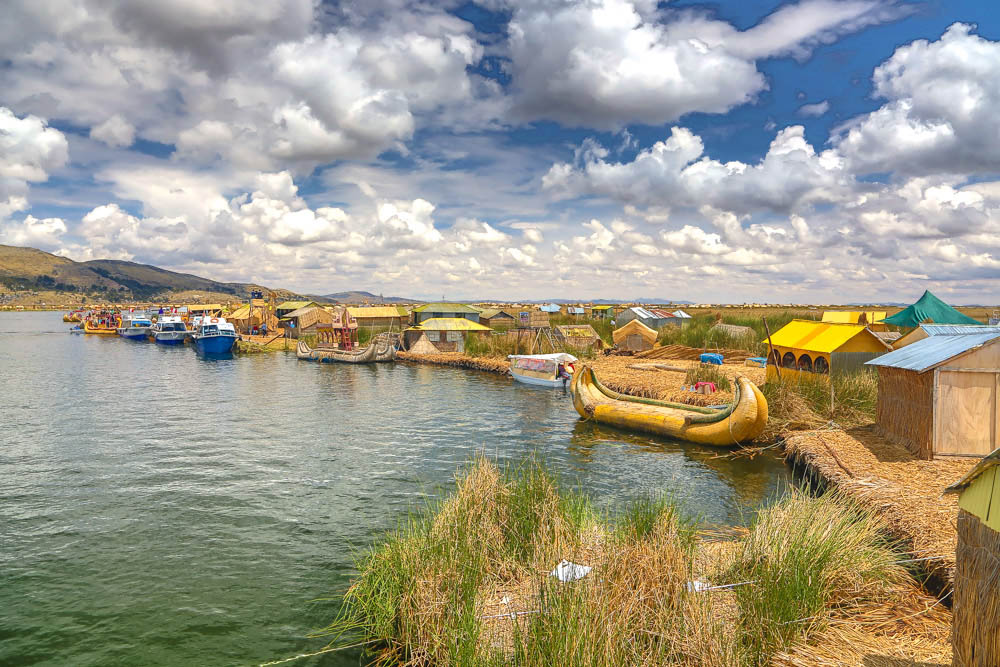 It was impressive that the locals even have a school out on the islands for young children, but if people want further education then they usually need to move into town back on land in Puno.
It was impressive that the locals even have a school out on the islands for young children, but if people want further education then they usually need to move into town back on land in Puno.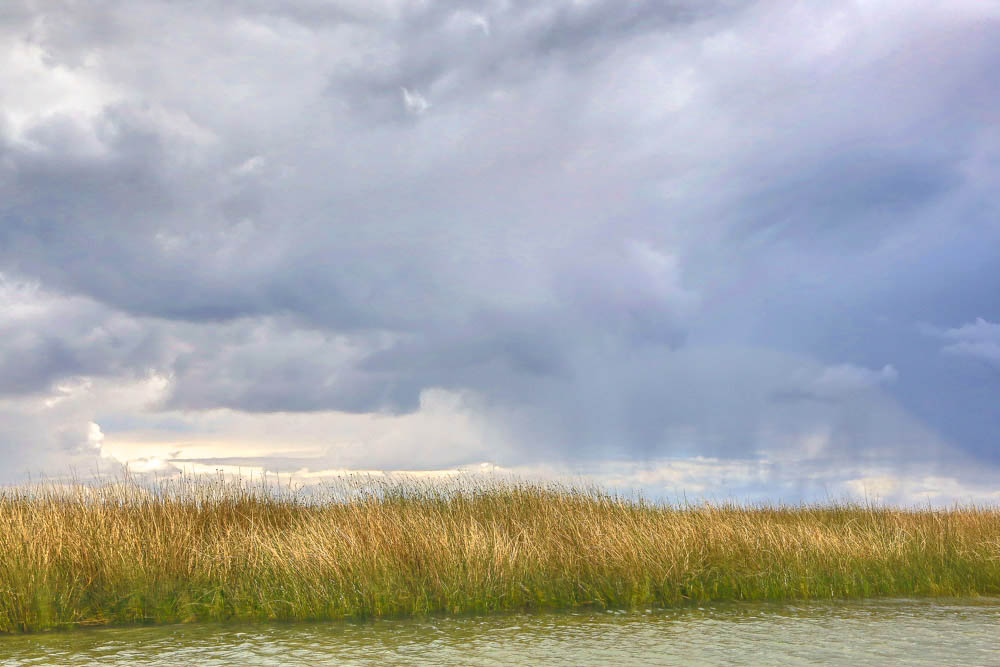 Kay and I enjoying the sun warming us up a little.
Kay and I enjoying the sun warming us up a little.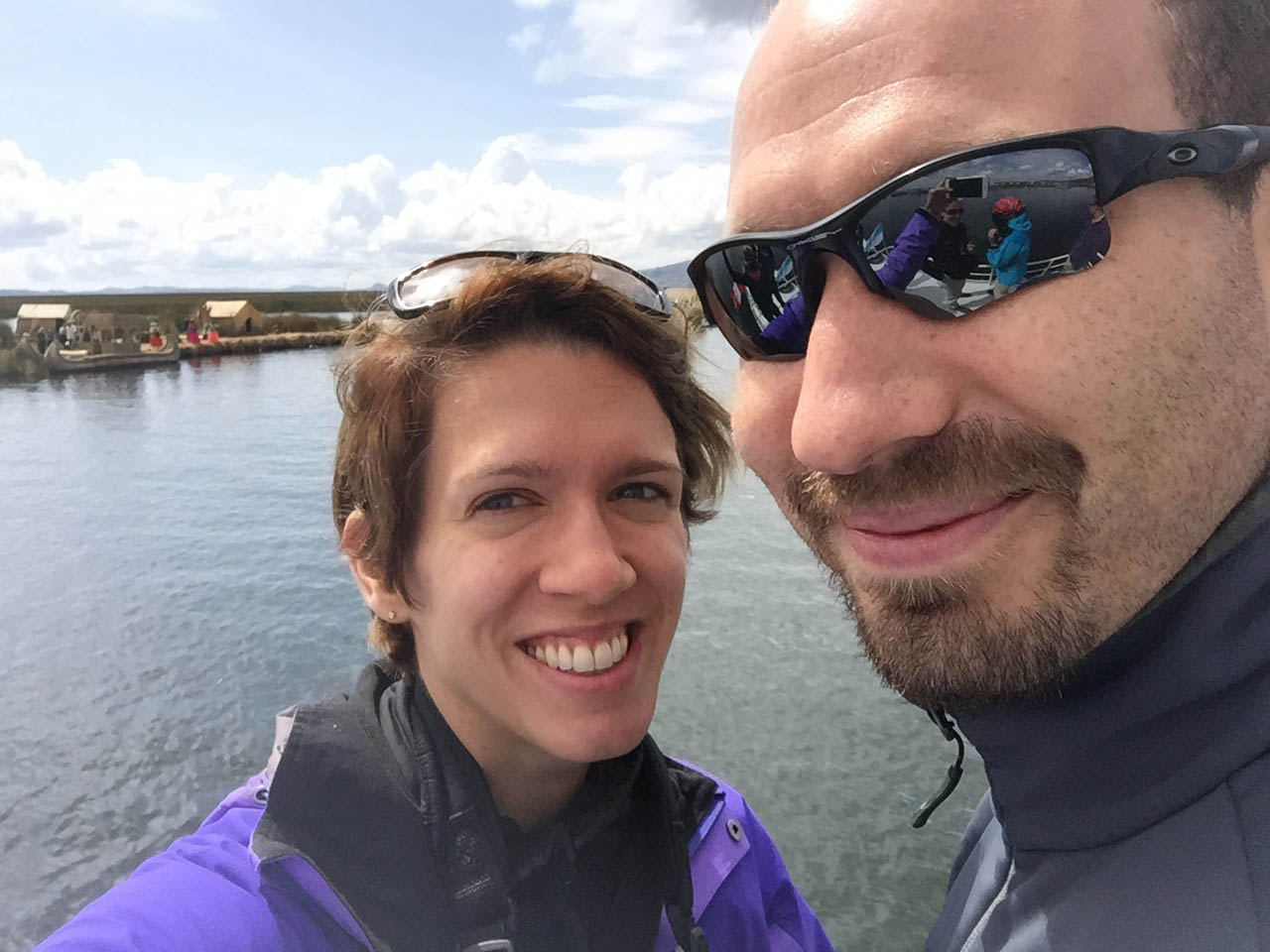 After awhile it was time to get back on the boat and head to Amantaní island for our homestay.
After awhile it was time to get back on the boat and head to Amantaní island for our homestay.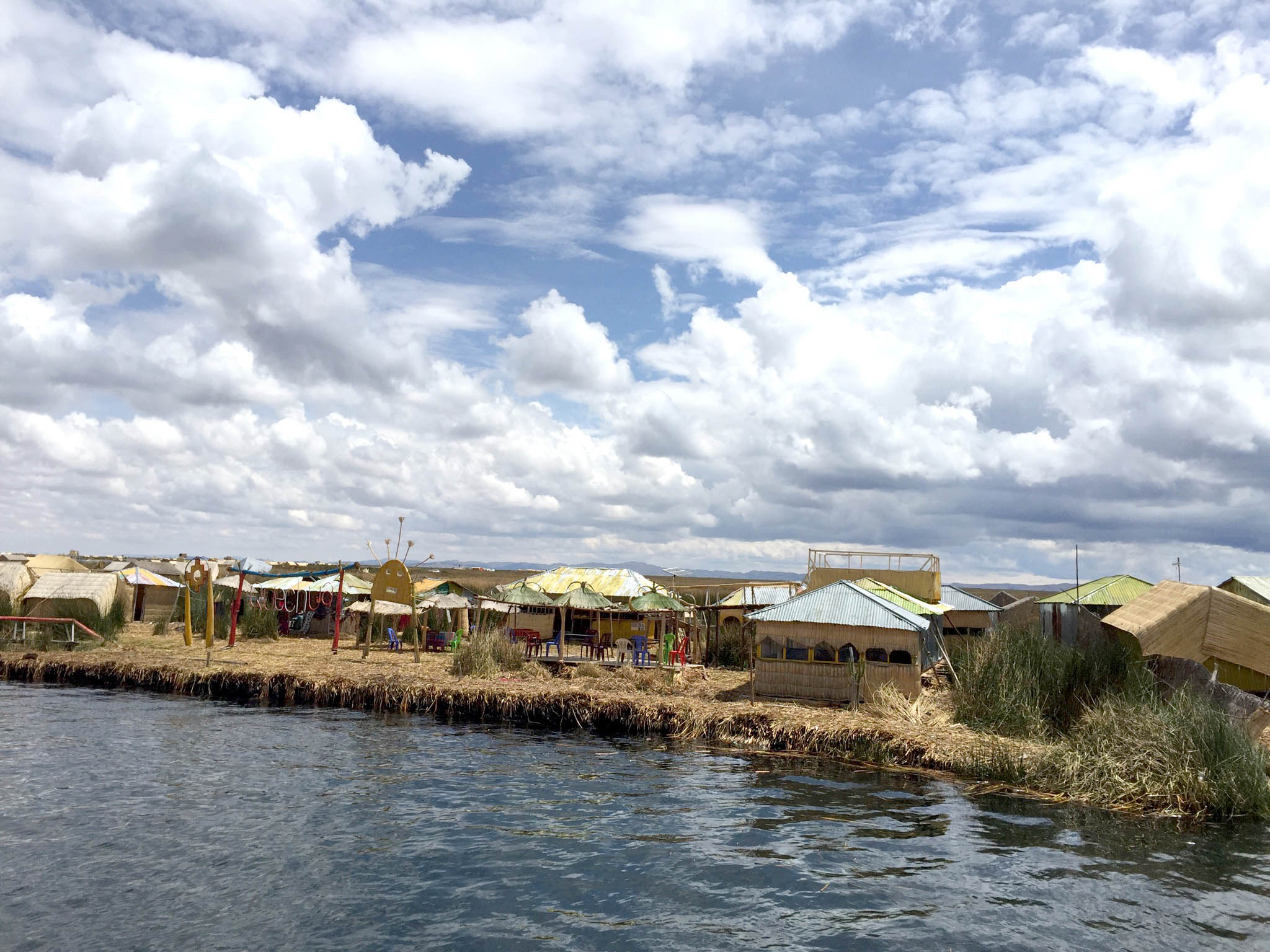 If you have time around Peru, I definitely recommend visiting the lake. Some tours are day trips, so you could shorten your stay, but I’m so glad that we did our overnight homestay. It was such a special experience. More about that soon!
If you have time around Peru, I definitely recommend visiting the lake. Some tours are day trips, so you could shorten your stay, but I’m so glad that we did our overnight homestay. It was such a special experience. More about that soon!